Technology and Digital Media in the Classroom: A Guide for Educators
- January 23, 2020
Technology has done more to change school curriculum and practices than nearly anything else—and in such a short amount of time! While it can be hard to keep up with every trend in educational technology, the mindset you have when it comes to classroom tech matters just as much as which ones you use. By learning to view it as a means of enhancing your lessons and resources, you can provide your students with tools and opportunities they may not otherwise access.
So, why and how should you use technology in your classroom? Read on to discover the impact of technology in education and how to get the most from its unique benefits.

What Is the Proper Role of Technology in the Classroom?
If you struggle to use technology in your classroom, you’re not alone. Many educators aren’t motivated to use digital resources in class, often because they’re unsure how to use them effectively or are unaware of the benefits.[1] In such cases, it’s easy to question not only how to make technology useful, but also whether technology should be used in schools at all.
Even with the latest and best digital technology, classrooms will not benefit unless the students and faculty understand how to use it.[15] In fact, educational technology should never be viewed as a perfect resource to teach your students everything they need to know to succeed. Instead, view it as a tool that can inform and supplement lessons, and even then, only if teachers and administrators are well trained in its use.
While technology can be an excellent resource in a classroom, it’s important to set limitations. Technology—no matter how good—should never be a substitute for face-to-face interaction with a teacher or classmates.[4] Technology is best used to augment non-digital lessons rather than the other way around. The goal when using technology should be to enhance your teaching rather than replace it.[6]
Benefits of Using Tech and Digital Media in Education
With the help of technology, you can introduce your classroom to opportunities and resources they may not otherwise be able to access.[5] In fact, this is one of the greatest ways technology has changed education. You may not be able to take your students to one of NASA’s space centers to witness a rocket launch, for example, but you can teach them all about rockets using resources on NASA’s website . Video clips, educational games, and virtual simulations are just a few examples of technology resources you can use to engage and educate in the classroom.
Plus, the vast majority of today’s careers require at least some digital skills (which include anything from complex skills like coding to simpler ones like composing and sending emails). Using tech in class can prepare students to successfully enter the workforce after graduation.[4] Even though the technology is likely to change from their early school years to the time they start their first career, teaching digital literacy in elementary school is a great way to get students started.
Why else is understanding how to use technology in the classroom important? Using technology alongside non-digital lessons can have many academic and behavioral benefits for your students, including:[2,7,11,12]
- Longer attention span
- Increased intrinsic motivation to learn
- Higher classroom participation and student engagement
- Greater academic achievement
- Stronger digital literacy
And finally, the benefits of classroom technology can expand far beyond the classroom and right into your students’ homes.[4] Rather than handing out paper worksheets, you can send your students online lessons or activities to complete at their own convenience. This practice provides better flexibility, plus the opportunity for you to provide audio or video clips alongside homework assignments. Additionally, if you have under-resourced students in your classroom, you may be able to supplement the resources available to their families by providing take-home technology.
How to Get the Most from Technology in Schools
One of the major concerns parents and educators have with classroom technology is how to limit excessive screen time. The American Association of Pediatrics suggests the following screen time recommendations by age. Keep these guidelines in mind when you teach lessons that involve screen time in your classroom:[17]
- 2–5 years old : No more than one hour of high-quality digital activities or programming
- 6 or older : Consistent limits to prevent screen time getting in the way of sleep, physical activity, or other healthy behaviors

Whenever possible, prioritize active digital screen time over passive.[16] Active screen time, like playing an educational game or learning a new digital skill, engages a student’s mind or body in a way that involves more than observation. Passive screen time—think watching a video or listening to an online lecture—involves limited interaction or engagement with the technology. Active digital activities are more likely to help your students experience new concepts, and they encourage your class to work together during the lesson.
Although teachers at under-resourced and rural schools are less likely to use technology, any tech you have available can greatly add to the opportunities you provide your students.[13, 18] Technology can remove some of the physical or financial barriers to educational resources and experiences.[17] If you’re unable to go on a field trip, for example, you can access plenty of virtual field trips at no cost.[16] Use the technology you do have to supplement your lessons and provide students with information you may not otherwise be able to access.
And finally, use school technology to teach your students digital citizenship .[14] Broadly defined, digital citizenship is the safe, ethical, informed, and responsible use of technology.[16] It encompasses skills like internet safety, setting healthy screen time habits, and communicating with others online. Lessons that involve digital citizenship can help a student use technology responsibly well beyond their elementary school years.
6 Quick Tips for Using Technology in the Classroom
The benefits of technology in education can revolutionize your classroom, but only when used intentionally. All it takes is a little time and personal training to help you understand the ins and outs of useful classroom tech.
Keep these six strategies and ideas in mind to help you get the most out of your classroom technology:
- Always use technology or learning programs yourself before trying it with your students so you can troubleshoot any issues in advance.[9]
- Most of today’s students are digital natives and have grown up around technology for their entire life. Listen to what your students know about technology and ask them for tip. They may just teach you something new![8]
- Use digital resources (like apps, texts, or social media groups) to keep parents informed about class activities and upcoming assignments.[5]
- Prioritize active digital activities, like online learning games or interactive lessons, over passive activities (like watching a video).
- If you’re an administrator, schedule a faculty training session on how to use your school’s technology and answer any questions.[10]
- Focus your technology-based lessons on teaching your students digital citizenship , or skills that will help them thoughtfully and effectively navigate digital media.[14]
- Groff, J., and Mouza, C. A Framework for Addressing Challenges to Classroom Technology Use. AACE Journal, January 2008, 16(1), pp. 21-46.
- Levy, L.A. 7 Reasons Why Digital Literacy is Important for Teachers. Retrieved from usc.edu: https://www.rossieronline.usc.edu/blog/teacher-digital-literacy/.
- Van Dusen, L.M., and Worthen, B.R. Can Integrated Instructional Technology Transform the Classroom? Educational Leadership, October 1995, 53(2), pp. 28-33.
- Rosenberg, J. Technology in the classroom: Friend or Foe? Retrieved from huffpost.com: hhttps://www.huffpost.com/entry/technology-in-the-classro_2_b_2018558..
- Venezky, R.L. Technology in the classroom: steps toward a new vision. Education, Communication & Information, 2004, 4(1), pp. 3-21.
- Buckenmeyer, J.A. Beyond Computers In The Classroom: Factors Related To Technology Adoption To Enhance Teaching And Learning. Contemporary Issues in Education Research. April 2010, 3(4), pp. 27-36.
- Bester, G., and Brand, L. The effect of technology on learner attention and achievement in the classroom. South African Journal of Education, 2013, 33(2), pp. 1-15.
- Reissman, H. 7 smart ways to use technology in classrooms. Retrieved from ted.com: https://ideas.ted.com/7-smart-ways-to-use-technology-in-classrooms/.
- Edutopia Staff. How to Integrate Technology. Retrieved from edutopia.org: https://www.edutopia.org/technology-integration-guide-implementation. Winters-Robinson, E. How Tech Can Engage Students, Simplify the School Day and Save Time for Teachers. Retrieved from edsurge.com: https://www.edsurge.com/news/2019-10-15-how-tech-can-engage-students-simplify-the-school-day-and-save-time-for-teachers.
- Couse, L.J., and Chen, D.W. A Tablet Computer for Young Children? Exploring its Viability for Early Childhood Education. Journal of Research on Technology in Education, 2010, 43(1), pp. 75-96.
- Filer, D. Everyone’s Answering: Using Technology to Increase Classroom Participation. Nursing Education Perspectives, 2010, 31(4), pp. 247-250.
- Friedman, S. How Teachers Use Technology in the Classroom. Retrieved from thejournal.com: https://thejournal.com/articles/2019/04/15/how-teachers-use-technology-in-the-classroom.aspx.
- Mace, N. 8 Strategies to Manage the 21st Century Classroom . Retrieved from education.cu-portland.edu: https://education.cu-portland.edu/blog/classroom-resources/using-classroom-technology/.
- Keswani, B., Patni, P., and Banerjee, D. Role Of Technology In Education: A 21st Century Approach. Journal of Commerce and Instructional Technology, 2008, 8, pp.54-59.
- The Office of Educational Technology. Reimagining the Role of Technology in Education: 2017 National Education Technology Plan Update . Retrieved from tech.ed.gov: tech.ed.gov/files/2017/01/NETP17.pdf.
- Courville, K. Technology and its use in Education: Present Roles and Future Prospects. 2011 Recovery School District Technology Summit, 2011, pp. 1-19.
- Klopfer, E., Osterweil, S., Groff, J., and Haas, J. Using the technology of today, in the classroom today: the instructional power of digital games, social networking, simulations, and how teachers can leverage them . The Education Arcade, 2009, pp. 1-20.
- American Academy of Pediatrics. American Academy of Pediatrics Announces New Recommendations for Children’s Media Use. Retrieved from aap.org: https://www.aap.org/en-us/about-the-aap/aap-press-room/Pages/American-Academy-of-Pediatrics-Announces-New-Recommendations-for-Childrens-Media-Use.aspx.
More education articles

10 of the Best Elementary Activities for the Last Days of School
The end of the school year can evoke a bittersweet feeling. It marks a moment for celebration as educators contemplate the growth and achievements of

Preparing Your Child for Kindergarten: 6 Important Skills to Foster
As someone who has had the privilege of being a kindergarten teacher, I vividly recall the excitement and anticipation of children stepping foot into my

National Poetry Month: Elementary Classroom Activities & Picture Books
Every April, the literary world comes alive with rhythm and rhyme as we celebrate National Poetry Month. For elementary school teachers, this month is an

Mental Health Awareness Month 2024: 7 Ways to Nurture Your Child’s Mental Health

MacKenzie Scott’s Yield Giving Awards Waterford.org a $10 Million Grant
REALIZING THE PROMISE:
Leading up to the 75th anniversary of the UN General Assembly, this “Realizing the promise: How can education technology improve learning for all?” publication kicks off the Center for Universal Education’s first playbook in a series to help improve education around the world.
It is intended as an evidence-based tool for ministries of education, particularly in low- and middle-income countries, to adopt and more successfully invest in education technology.
While there is no single education initiative that will achieve the same results everywhere—as school systems differ in learners and educators, as well as in the availability and quality of materials and technologies—an important first step is understanding how technology is used given specific local contexts and needs.
The surveys in this playbook are designed to be adapted to collect this information from educators, learners, and school leaders and guide decisionmakers in expanding the use of technology.
Introduction
While technology has disrupted most sectors of the economy and changed how we communicate, access information, work, and even play, its impact on schools, teaching, and learning has been much more limited. We believe that this limited impact is primarily due to technology being been used to replace analog tools, without much consideration given to playing to technology’s comparative advantages. These comparative advantages, relative to traditional “chalk-and-talk” classroom instruction, include helping to scale up standardized instruction, facilitate differentiated instruction, expand opportunities for practice, and increase student engagement. When schools use technology to enhance the work of educators and to improve the quality and quantity of educational content, learners will thrive.
Further, COVID-19 has laid bare that, in today’s environment where pandemics and the effects of climate change are likely to occur, schools cannot always provide in-person education—making the case for investing in education technology.
Here we argue for a simple yet surprisingly rare approach to education technology that seeks to:
- Understand the needs, infrastructure, and capacity of a school system—the diagnosis;
- Survey the best available evidence on interventions that match those conditions—the evidence; and
- Closely monitor the results of innovations before they are scaled up—the prognosis.
RELATED CONTENT

Podcast: How education technology can improve learning for all students

To make ed tech work, set clear goals, review the evidence, and pilot before you scale
The framework.
Our approach builds on a simple yet intuitive theoretical framework created two decades ago by two of the most prominent education researchers in the United States, David K. Cohen and Deborah Loewenberg Ball. They argue that what matters most to improve learning is the interactions among educators and learners around educational materials. We believe that the failed school-improvement efforts in the U.S. that motivated Cohen and Ball’s framework resemble the ed-tech reforms in much of the developing world to date in the lack of clarity improving the interactions between educators, learners, and the educational material. We build on their framework by adding parents as key agents that mediate the relationships between learners and educators and the material (Figure 1).
Figure 1: The instructional core
Adapted from Cohen and Ball (1999)
As the figure above suggests, ed-tech interventions can affect the instructional core in a myriad of ways. Yet, just because technology can do something, it does not mean it should. School systems in developing countries differ along many dimensions and each system is likely to have different needs for ed-tech interventions, as well as different infrastructure and capacity to enact such interventions.
The diagnosis:
How can school systems assess their needs and preparedness.
A useful first step for any school system to determine whether it should invest in education technology is to diagnose its:
- Specific needs to improve student learning (e.g., raising the average level of achievement, remediating gaps among low performers, and challenging high performers to develop higher-order skills);
- Infrastructure to adopt technology-enabled solutions (e.g., electricity connection, availability of space and outlets, stock of computers, and Internet connectivity at school and at learners’ homes); and
- Capacity to integrate technology in the instructional process (e.g., learners’ and educators’ level of familiarity and comfort with hardware and software, their beliefs about the level of usefulness of technology for learning purposes, and their current uses of such technology).
Before engaging in any new data collection exercise, school systems should take full advantage of existing administrative data that could shed light on these three main questions. This could be in the form of internal evaluations but also international learner assessments, such as the Program for International Student Assessment (PISA), the Trends in International Mathematics and Science Study (TIMSS), and/or the Progress in International Literacy Study (PIRLS), and the Teaching and Learning International Study (TALIS). But if school systems lack information on their preparedness for ed-tech reforms or if they seek to complement existing data with a richer set of indicators, we developed a set of surveys for learners, educators, and school leaders. Download the full report to see how we map out the main aspects covered by these surveys, in hopes of highlighting how they could be used to inform decisions around the adoption of ed-tech interventions.
The evidence:
How can school systems identify promising ed-tech interventions.
There is no single “ed-tech” initiative that will achieve the same results everywhere, simply because school systems differ in learners and educators, as well as in the availability and quality of materials and technologies. Instead, to realize the potential of education technology to accelerate student learning, decisionmakers should focus on four potential uses of technology that play to its comparative advantages and complement the work of educators to accelerate student learning (Figure 2). These comparative advantages include:
- Scaling up quality instruction, such as through prerecorded quality lessons.
- Facilitating differentiated instruction, through, for example, computer-adaptive learning and live one-on-one tutoring.
- Expanding opportunities to practice.
- Increasing learner engagement through videos and games.
Figure 2: Comparative advantages of technology
Here we review the evidence on ed-tech interventions from 37 studies in 20 countries*, organizing them by comparative advantage. It’s important to note that ours is not the only way to classify these interventions (e.g., video tutorials could be considered as a strategy to scale up instruction or increase learner engagement), but we believe it may be useful to highlight the needs that they could address and why technology is well positioned to do so.
When discussing specific studies, we report the magnitude of the effects of interventions using standard deviations (SDs). SDs are a widely used metric in research to express the effect of a program or policy with respect to a business-as-usual condition (e.g., test scores). There are several ways to make sense of them. One is to categorize the magnitude of the effects based on the results of impact evaluations. In developing countries, effects below 0.1 SDs are considered to be small, effects between 0.1 and 0.2 SDs are medium, and those above 0.2 SDs are large (for reviews that estimate the average effect of groups of interventions, called “meta analyses,” see e.g., Conn, 2017; Kremer, Brannen, & Glennerster, 2013; McEwan, 2014; Snilstveit et al., 2015; Evans & Yuan, 2020.)
*In surveying the evidence, we began by compiling studies from prior general and ed-tech specific evidence reviews that some of us have written and from ed-tech reviews conducted by others. Then, we tracked the studies cited by the ones we had previously read and reviewed those, as well. In identifying studies for inclusion, we focused on experimental and quasi-experimental evaluations of education technology interventions from pre-school to secondary school in low- and middle-income countries that were released between 2000 and 2020. We only included interventions that sought to improve student learning directly (i.e., students’ interaction with the material), as opposed to interventions that have impacted achievement indirectly, by reducing teacher absence or increasing parental engagement. This process yielded 37 studies in 20 countries (see the full list of studies in Appendix B).
Scaling up standardized instruction
One of the ways in which technology may improve the quality of education is through its capacity to deliver standardized quality content at scale. This feature of technology may be particularly useful in three types of settings: (a) those in “hard-to-staff” schools (i.e., schools that struggle to recruit educators with the requisite training and experience—typically, in rural and/or remote areas) (see, e.g., Urquiola & Vegas, 2005); (b) those in which many educators are frequently absent from school (e.g., Chaudhury, Hammer, Kremer, Muralidharan, & Rogers, 2006; Muralidharan, Das, Holla, & Mohpal, 2017); and/or (c) those in which educators have low levels of pedagogical and subject matter expertise (e.g., Bietenbeck, Piopiunik, & Wiederhold, 2018; Bold et al., 2017; Metzler & Woessmann, 2012; Santibañez, 2006) and do not have opportunities to observe and receive feedback (e.g., Bruns, Costa, & Cunha, 2018; Cilliers, Fleisch, Prinsloo, & Taylor, 2018). Technology could address this problem by: (a) disseminating lessons delivered by qualified educators to a large number of learners (e.g., through prerecorded or live lessons); (b) enabling distance education (e.g., for learners in remote areas and/or during periods of school closures); and (c) distributing hardware preloaded with educational materials.
Prerecorded lessons
Technology seems to be well placed to amplify the impact of effective educators by disseminating their lessons. Evidence on the impact of prerecorded lessons is encouraging, but not conclusive. Some initiatives that have used short instructional videos to complement regular instruction, in conjunction with other learning materials, have raised student learning on independent assessments. For example, Beg et al. (2020) evaluated an initiative in Punjab, Pakistan in which grade 8 classrooms received an intervention that included short videos to substitute live instruction, quizzes for learners to practice the material from every lesson, tablets for educators to learn the material and follow the lesson, and LED screens to project the videos onto a classroom screen. After six months, the intervention improved the performance of learners on independent tests of math and science by 0.19 and 0.24 SDs, respectively but had no discernible effect on the math and science section of Punjab’s high-stakes exams.
One study suggests that approaches that are far less technologically sophisticated can also improve learning outcomes—especially, if the business-as-usual instruction is of low quality. For example, Naslund-Hadley, Parker, and Hernandez-Agramonte (2014) evaluated a preschool math program in Cordillera, Paraguay that used audio segments and written materials four days per week for an hour per day during the school day. After five months, the intervention improved math scores by 0.16 SDs, narrowing gaps between low- and high-achieving learners, and between those with and without educators with formal training in early childhood education.
Yet, the integration of prerecorded material into regular instruction has not always been successful. For example, de Barros (2020) evaluated an intervention that combined instructional videos for math and science with infrastructure upgrades (e.g., two “smart” classrooms, two TVs, and two tablets), printed workbooks for students, and in-service training for educators of learners in grades 9 and 10 in Haryana, India (all materials were mapped onto the official curriculum). After 11 months, the intervention negatively impacted math achievement (by 0.08 SDs) and had no effect on science (with respect to business as usual classes). It reduced the share of lesson time that educators devoted to instruction and negatively impacted an index of instructional quality. Likewise, Seo (2017) evaluated several combinations of infrastructure (solar lights and TVs) and prerecorded videos (in English and/or bilingual) for grade 11 students in northern Tanzania and found that none of the variants improved student learning, even when the videos were used. The study reports effects from the infrastructure component across variants, but as others have noted (Muralidharan, Romero, & Wüthrich, 2019), this approach to estimating impact is problematic.
A very similar intervention delivered after school hours, however, had sizeable effects on learners’ basic skills. Chiplunkar, Dhar, and Nagesh (2020) evaluated an initiative in Chennai (the capital city of the state of Tamil Nadu, India) delivered by the same organization as above that combined short videos that explained key concepts in math and science with worksheets, facilitator-led instruction, small groups for peer-to-peer learning, and occasional career counseling and guidance for grade 9 students. These lessons took place after school for one hour, five times a week. After 10 months, it had large effects on learners’ achievement as measured by tests of basic skills in math and reading, but no effect on a standardized high-stakes test in grade 10 or socio-emotional skills (e.g., teamwork, decisionmaking, and communication).
Drawing general lessons from this body of research is challenging for at least two reasons. First, all of the studies above have evaluated the impact of prerecorded lessons combined with several other components (e.g., hardware, print materials, or other activities). Therefore, it is possible that the effects found are due to these additional components, rather than to the recordings themselves, or to the interaction between the two (see Muralidharan, 2017 for a discussion of the challenges of interpreting “bundled” interventions). Second, while these studies evaluate some type of prerecorded lessons, none examines the content of such lessons. Thus, it seems entirely plausible that the direction and magnitude of the effects depends largely on the quality of the recordings (e.g., the expertise of the educator recording it, the amount of preparation that went into planning the recording, and its alignment with best teaching practices).
These studies also raise three important questions worth exploring in future research. One of them is why none of the interventions discussed above had effects on high-stakes exams, even if their materials are typically mapped onto the official curriculum. It is possible that the official curricula are simply too challenging for learners in these settings, who are several grade levels behind expectations and who often need to reinforce basic skills (see Pritchett & Beatty, 2015). Another question is whether these interventions have long-term effects on teaching practices. It seems plausible that, if these interventions are deployed in contexts with low teaching quality, educators may learn something from watching the videos or listening to the recordings with learners. Yet another question is whether these interventions make it easier for schools to deliver instruction to learners whose native language is other than the official medium of instruction.
Distance education
Technology can also allow learners living in remote areas to access education. The evidence on these initiatives is encouraging. For example, Johnston and Ksoll (2017) evaluated a program that broadcasted live instruction via satellite to rural primary school students in the Volta and Greater Accra regions of Ghana. For this purpose, the program also equipped classrooms with the technology needed to connect to a studio in Accra, including solar panels, a satellite modem, a projector, a webcam, microphones, and a computer with interactive software. After two years, the intervention improved the numeracy scores of students in grades 2 through 4, and some foundational literacy tasks, but it had no effect on attendance or classroom time devoted to instruction, as captured by school visits. The authors interpreted these results as suggesting that the gains in achievement may be due to improving the quality of instruction that children received (as opposed to increased instructional time). Naik, Chitre, Bhalla, and Rajan (2019) evaluated a similar program in the Indian state of Karnataka and also found positive effects on learning outcomes, but it is not clear whether those effects are due to the program or due to differences in the groups of students they compared to estimate the impact of the initiative.
In one context (Mexico), this type of distance education had positive long-term effects. Navarro-Sola (2019) took advantage of the staggered rollout of the telesecundarias (i.e., middle schools with lessons broadcasted through satellite TV) in 1968 to estimate its impact. The policy had short-term effects on students’ enrollment in school: For every telesecundaria per 50 children, 10 students enrolled in middle school and two pursued further education. It also had a long-term influence on the educational and employment trajectory of its graduates. Each additional year of education induced by the policy increased average income by nearly 18 percent. This effect was attributable to more graduates entering the labor force and shifting from agriculture and the informal sector. Similarly, Fabregas (2019) leveraged a later expansion of this policy in 1993 and found that each additional telesecundaria per 1,000 adolescents led to an average increase of 0.2 years of education, and a decline in fertility for women, but no conclusive evidence of long-term effects on labor market outcomes.
It is crucial to interpret these results keeping in mind the settings where the interventions were implemented. As we mention above, part of the reason why they have proven effective is that the “counterfactual” conditions for learning (i.e., what would have happened to learners in the absence of such programs) was either to not have access to schooling or to be exposed to low-quality instruction. School systems interested in taking up similar interventions should assess the extent to which their learners (or parts of their learner population) find themselves in similar conditions to the subjects of the studies above. This illustrates the importance of assessing the needs of a system before reviewing the evidence.
Preloaded hardware
Technology also seems well positioned to disseminate educational materials. Specifically, hardware (e.g., desktop computers, laptops, or tablets) could also help deliver educational software (e.g., word processing, reference texts, and/or games). In theory, these materials could not only undergo a quality assurance review (e.g., by curriculum specialists and educators), but also draw on the interactions with learners for adjustments (e.g., identifying areas needing reinforcement) and enable interactions between learners and educators.
In practice, however, most initiatives that have provided learners with free computers, laptops, and netbooks do not leverage any of the opportunities mentioned above. Instead, they install a standard set of educational materials and hope that learners find them helpful enough to take them up on their own. Students rarely do so, and instead use the laptops for recreational purposes—often, to the detriment of their learning (see, e.g., Malamud & Pop-Eleches, 2011). In fact, free netbook initiatives have not only consistently failed to improve academic achievement in math or language (e.g., Cristia et al., 2017), but they have had no impact on learners’ general computer skills (e.g., Beuermann et al., 2015). Some of these initiatives have had small impacts on cognitive skills, but the mechanisms through which those effects occurred remains unclear.
To our knowledge, the only successful deployment of a free laptop initiative was one in which a team of researchers equipped the computers with remedial software. Mo et al. (2013) evaluated a version of the One Laptop per Child (OLPC) program for grade 3 students in migrant schools in Beijing, China in which the laptops were loaded with a remedial software mapped onto the national curriculum for math (similar to the software products that we discuss under “practice exercises” below). After nine months, the program improved math achievement by 0.17 SDs and computer skills by 0.33 SDs. If a school system decides to invest in free laptops, this study suggests that the quality of the software on the laptops is crucial.
To date, however, the evidence suggests that children do not learn more from interacting with laptops than they do from textbooks. For example, Bando, Gallego, Gertler, and Romero (2016) compared the effect of free laptop and textbook provision in 271 elementary schools in disadvantaged areas of Honduras. After seven months, students in grades 3 and 6 who had received the laptops performed on par with those who had received the textbooks in math and language. Further, even if textbooks essentially become obsolete at the end of each school year, whereas laptops can be reloaded with new materials for each year, the costs of laptop provision (not just the hardware, but also the technical assistance, Internet, and training associated with it) are not yet low enough to make them a more cost-effective way of delivering content to learners.
Evidence on the provision of tablets equipped with software is encouraging but limited. For example, de Hoop et al. (2020) evaluated a composite intervention for first grade students in Zambia’s Eastern Province that combined infrastructure (electricity via solar power), hardware (projectors and tablets), and educational materials (lesson plans for educators and interactive lessons for learners, both loaded onto the tablets and mapped onto the official Zambian curriculum). After 14 months, the intervention had improved student early-grade reading by 0.4 SDs, oral vocabulary scores by 0.25 SDs, and early-grade math by 0.22 SDs. It also improved students’ achievement by 0.16 on a locally developed assessment. The multifaceted nature of the program, however, makes it challenging to identify the components that are driving the positive effects. Pitchford (2015) evaluated an intervention that provided tablets equipped with educational “apps,” to be used for 30 minutes per day for two months to develop early math skills among students in grades 1 through 3 in Lilongwe, Malawi. The evaluation found positive impacts in math achievement, but the main study limitation is that it was conducted in a single school.
Facilitating differentiated instruction
Another way in which technology may improve educational outcomes is by facilitating the delivery of differentiated or individualized instruction. Most developing countries massively expanded access to schooling in recent decades by building new schools and making education more affordable, both by defraying direct costs, as well as compensating for opportunity costs (Duflo, 2001; World Bank, 2018). These initiatives have not only rapidly increased the number of learners enrolled in school, but have also increased the variability in learner’ preparation for schooling. Consequently, a large number of learners perform well below grade-based curricular expectations (see, e.g., Duflo, Dupas, & Kremer, 2011; Pritchett & Beatty, 2015). These learners are unlikely to get much from “one-size-fits-all” instruction, in which a single educator delivers instruction deemed appropriate for the middle (or top) of the achievement distribution (Banerjee & Duflo, 2011). Technology could potentially help these learners by providing them with: (a) instruction and opportunities for practice that adjust to the level and pace of preparation of each individual (known as “computer-adaptive learning” (CAL)); or (b) live, one-on-one tutoring.
Computer-adaptive learning
One of the main comparative advantages of technology is its ability to diagnose students’ initial learning levels and assign students to instruction and exercises of appropriate difficulty. No individual educator—no matter how talented—can be expected to provide individualized instruction to all learners in his/her class simultaneously . In this respect, technology is uniquely positioned to complement traditional teaching. This use of technology could help learners master basic skills and help them get more out of schooling.
Although many software products evaluated in recent years have been categorized as CAL, many rely on a relatively coarse level of differentiation at an initial stage (e.g., a diagnostic test) without further differentiation. We discuss these initiatives under the category of “increasing opportunities for practice” below. CAL initiatives complement an initial diagnostic with dynamic adaptation (i.e., at each response or set of responses from learners) to adjust both the initial level of difficulty and rate at which it increases or decreases, depending on whether learners’ responses are correct or incorrect.
Existing evidence on this specific type of programs is highly promising. Most famously, Banerjee et al. (2007) evaluated CAL software in Vadodara, in the Indian state of Gujarat, in which grade 4 students were offered two hours of shared computer time per week before and after school, during which they played games that involved solving math problems. The level of difficulty of such problems adjusted based on students’ answers. This program improved math achievement by 0.35 and 0.47 SDs after one and two years of implementation, respectively. Consistent with the promise of personalized learning, the software improved achievement for all students. In fact, one year after the end of the program, students assigned to the program still performed 0.1 SDs better than those assigned to a business as usual condition. More recently, Muralidharan, et al. (2019) evaluated a “blended learning” initiative in which students in grades 4 through 9 in Delhi, India received 45 minutes of interaction with CAL software for math and language, and 45 minutes of small group instruction before or after going to school. After only 4.5 months, the program improved achievement by 0.37 SDs in math and 0.23 SDs in Hindi. While all learners benefited from the program in absolute terms, the lowest performing learners benefited the most in relative terms, since they were learning very little in school.
We see two important limitations from this body of research. First, to our knowledge, none of these initiatives has been evaluated when implemented during the school day. Therefore, it is not possible to distinguish the effect of the adaptive software from that of additional instructional time. Second, given that most of these programs were facilitated by local instructors, attempts to distinguish the effect of the software from that of the instructors has been mostly based on noncausal evidence. A frontier challenge in this body of research is to understand whether CAL software can increase the effectiveness of school-based instruction by substituting part of the regularly scheduled time for math and language instruction.
Live one-on-one tutoring
Recent improvements in the speed and quality of videoconferencing, as well as in the connectivity of remote areas, have enabled yet another way in which technology can help personalization: live (i.e., real-time) one-on-one tutoring. While the evidence on in-person tutoring is scarce in developing countries, existing studies suggest that this approach works best when it is used to personalize instruction (see, e.g., Banerjee et al., 2007; Banerji, Berry, & Shotland, 2015; Cabezas, Cuesta, & Gallego, 2011).
There are almost no studies on the impact of online tutoring—possibly, due to the lack of hardware and Internet connectivity in low- and middle-income countries. One exception is Chemin and Oledan (2020)’s recent evaluation of an online tutoring program for grade 6 students in Kianyaga, Kenya to learn English from volunteers from a Canadian university via Skype ( videoconferencing software) for one hour per week after school. After 10 months, program beneficiaries performed 0.22 SDs better in a test of oral comprehension, improved their comfort using technology for learning, and became more willing to engage in cross-cultural communication. Importantly, while the tutoring sessions used the official English textbooks and sought in part to help learners with their homework, tutors were trained on several strategies to teach to each learner’s individual level of preparation, focusing on basic skills if necessary. To our knowledge, similar initiatives within a country have not yet been rigorously evaluated.
Expanding opportunities for practice
A third way in which technology may improve the quality of education is by providing learners with additional opportunities for practice. In many developing countries, lesson time is primarily devoted to lectures, in which the educator explains the topic and the learners passively copy explanations from the blackboard. This setup leaves little time for in-class practice. Consequently, learners who did not understand the explanation of the material during lecture struggle when they have to solve homework assignments on their own. Technology could potentially address this problem by allowing learners to review topics at their own pace.
Practice exercises
Technology can help learners get more out of traditional instruction by providing them with opportunities to implement what they learn in class. This approach could, in theory, allow some learners to anchor their understanding of the material through trial and error (i.e., by realizing what they may not have understood correctly during lecture and by getting better acquainted with special cases not covered in-depth in class).
Existing evidence on practice exercises reflects both the promise and the limitations of this use of technology in developing countries. For example, Lai et al. (2013) evaluated a program in Shaanxi, China where students in grades 3 and 5 were required to attend two 40-minute remedial sessions per week in which they first watched videos that reviewed the material that had been introduced in their math lessons that week and then played games to practice the skills introduced in the video. After four months, the intervention improved math achievement by 0.12 SDs. Many other evaluations of comparable interventions have found similar small-to-moderate results (see, e.g., Lai, Luo, Zhang, Huang, & Rozelle, 2015; Lai et al., 2012; Mo et al., 2015; Pitchford, 2015). These effects, however, have been consistently smaller than those of initiatives that adjust the difficulty of the material based on students’ performance (e.g., Banerjee et al., 2007; Muralidharan, et al., 2019). We hypothesize that these programs do little for learners who perform several grade levels behind curricular expectations, and who would benefit more from a review of foundational concepts from earlier grades.
We see two important limitations from this research. First, most initiatives that have been evaluated thus far combine instructional videos with practice exercises, so it is hard to know whether their effects are driven by the former or the latter. In fact, the program in China described above allowed learners to ask their peers whenever they did not understand a difficult concept, so it potentially also captured the effect of peer-to-peer collaboration. To our knowledge, no studies have addressed this gap in the evidence.
Second, most of these programs are implemented before or after school, so we cannot distinguish the effect of additional instructional time from that of the actual opportunity for practice. The importance of this question was first highlighted by Linden (2008), who compared two delivery mechanisms for game-based remedial math software for students in grades 2 and 3 in a network of schools run by a nonprofit organization in Gujarat, India: one in which students interacted with the software during the school day and another one in which students interacted with the software before or after school (in both cases, for three hours per day). After a year, the first version of the program had negatively impacted students’ math achievement by 0.57 SDs and the second one had a null effect. This study suggested that computer-assisted learning is a poor substitute for regular instruction when it is of high quality, as was the case in this well-functioning private network of schools.
In recent years, several studies have sought to remedy this shortcoming. Mo et al. (2014) were among the first to evaluate practice exercises delivered during the school day. They evaluated an initiative in Shaanxi, China in which students in grades 3 and 5 were required to interact with the software similar to the one in Lai et al. (2013) for two 40-minute sessions per week. The main limitation of this study, however, is that the program was delivered during regularly scheduled computer lessons, so it could not determine the impact of substituting regular math instruction. Similarly, Mo et al. (2020) evaluated a self-paced and a teacher-directed version of a similar program for English for grade 5 students in Qinghai, China. Yet, the key shortcoming of this study is that the teacher-directed version added several components that may also influence achievement, such as increased opportunities for teachers to provide students with personalized assistance when they struggled with the material. Ma, Fairlie, Loyalka, and Rozelle (2020) compared the effectiveness of additional time-delivered remedial instruction for students in grades 4 to 6 in Shaanxi, China through either computer-assisted software or using workbooks. This study indicates whether additional instructional time is more effective when using technology, but it does not address the question of whether school systems may improve the productivity of instructional time during the school day by substituting educator-led with computer-assisted instruction.
Increasing learner engagement
Another way in which technology may improve education is by increasing learners’ engagement with the material. In many school systems, regular “chalk and talk” instruction prioritizes time for educators’ exposition over opportunities for learners to ask clarifying questions and/or contribute to class discussions. This, combined with the fact that many developing-country classrooms include a very large number of learners (see, e.g., Angrist & Lavy, 1999; Duflo, Dupas, & Kremer, 2015), may partially explain why the majority of those students are several grade levels behind curricular expectations (e.g., Muralidharan, et al., 2019; Muralidharan & Zieleniak, 2014; Pritchett & Beatty, 2015). Technology could potentially address these challenges by: (a) using video tutorials for self-paced learning and (b) presenting exercises as games and/or gamifying practice.
Video tutorials
Technology can potentially increase learner effort and understanding of the material by finding new and more engaging ways to deliver it. Video tutorials designed for self-paced learning—as opposed to videos for whole class instruction, which we discuss under the category of “prerecorded lessons” above—can increase learner effort in multiple ways, including: allowing learners to focus on topics with which they need more help, letting them correct errors and misconceptions on their own, and making the material appealing through visual aids. They can increase understanding by breaking the material into smaller units and tackling common misconceptions.
In spite of the popularity of instructional videos, there is relatively little evidence on their effectiveness. Yet, two recent evaluations of different versions of the Khan Academy portal, which mainly relies on instructional videos, offer some insight into their impact. First, Ferman, Finamor, and Lima (2019) evaluated an initiative in 157 public primary and middle schools in five cities in Brazil in which the teachers of students in grades 5 and 9 were taken to the computer lab to learn math from the platform for 50 minutes per week. The authors found that, while the intervention slightly improved learners’ attitudes toward math, these changes did not translate into better performance in this subject. The authors hypothesized that this could be due to the reduction of teacher-led math instruction.
More recently, Büchel, Jakob, Kühnhanss, Steffen, and Brunetti (2020) evaluated an after-school, offline delivery of the Khan Academy portal in grades 3 through 6 in 302 primary schools in Morazán, El Salvador. Students in this study received 90 minutes per week of additional math instruction (effectively nearly doubling total math instruction per week) through teacher-led regular lessons, teacher-assisted Khan Academy lessons, or similar lessons assisted by technical supervisors with no content expertise. (Importantly, the first group provided differentiated instruction, which is not the norm in Salvadorian schools). All three groups outperformed both schools without any additional lessons and classrooms without additional lessons in the same schools as the program. The teacher-assisted Khan Academy lessons performed 0.24 SDs better, the supervisor-led lessons 0.22 SDs better, and the teacher-led regular lessons 0.15 SDs better, but the authors could not determine whether the effects across versions were different.
Together, these studies suggest that instructional videos work best when provided as a complement to, rather than as a substitute for, regular instruction. Yet, the main limitation of these studies is the multifaceted nature of the Khan Academy portal, which also includes other components found to positively improve learner achievement, such as differentiated instruction by students’ learning levels. While the software does not provide the type of personalization discussed above, learners are asked to take a placement test and, based on their score, educators assign them different work. Therefore, it is not clear from these studies whether the effects from Khan Academy are driven by its instructional videos or to the software’s ability to provide differentiated activities when combined with placement tests.
Games and gamification
Technology can also increase learner engagement by presenting exercises as games and/or by encouraging learner to play and compete with others (e.g., using leaderboards and rewards)—an approach known as “gamification.” Both approaches can increase learner motivation and effort by presenting learners with entertaining opportunities for practice and by leveraging peers as commitment devices.
There are very few studies on the effects of games and gamification in low- and middle-income countries. Recently, Araya, Arias Ortiz, Bottan, and Cristia (2019) evaluated an initiative in which grade 4 students in Santiago, Chile were required to participate in two 90-minute sessions per week during the school day with instructional math software featuring individual and group competitions (e.g., tracking each learner’s standing in his/her class and tournaments between sections). After nine months, the program led to improvements of 0.27 SDs in the national student assessment in math (it had no spillover effects on reading). However, it had mixed effects on non-academic outcomes. Specifically, the program increased learners’ willingness to use computers to learn math, but, at the same time, increased their anxiety toward math and negatively impacted learners’ willingness to collaborate with peers. Finally, given that one of the weekly sessions replaced regular math instruction and the other one represented additional math instructional time, it is not clear whether the academic effects of the program are driven by the software or the additional time devoted to learning math.
The prognosis:
How can school systems adopt interventions that match their needs.
Here are five specific and sequential guidelines for decisionmakers to realize the potential of education technology to accelerate student learning.
1. Take stock of how your current schools, educators, and learners are engaging with technology .
Carry out a short in-school survey to understand the current practices and potential barriers to adoption of technology (we have included suggested survey instruments in the Appendices); use this information in your decisionmaking process. For example, we learned from conversations with current and former ministers of education from various developing regions that a common limitation to technology use is regulations that hold school leaders accountable for damages to or losses of devices. Another common barrier is lack of access to electricity and Internet, or even the availability of sufficient outlets for charging devices in classrooms. Understanding basic infrastructure and regulatory limitations to the use of education technology is a first necessary step. But addressing these limitations will not guarantee that introducing or expanding technology use will accelerate learning. The next steps are thus necessary.
“In Africa, the biggest limit is connectivity. Fiber is expensive, and we don’t have it everywhere. The continent is creating a digital divide between cities, where there is fiber, and the rural areas. The [Ghanaian] administration put in schools offline/online technologies with books, assessment tools, and open source materials. In deploying this, we are finding that again, teachers are unfamiliar with it. And existing policies prohibit students to bring their own tablets or cell phones. The easiest way to do it would have been to let everyone bring their own device. But policies are against it.” H.E. Matthew Prempeh, Minister of Education of Ghana, on the need to understand the local context.
2. Consider how the introduction of technology may affect the interactions among learners, educators, and content .
Our review of the evidence indicates that technology may accelerate student learning when it is used to scale up access to quality content, facilitate differentiated instruction, increase opportunities for practice, or when it increases learner engagement. For example, will adding electronic whiteboards to classrooms facilitate access to more quality content or differentiated instruction? Or will these expensive boards be used in the same way as the old chalkboards? Will providing one device (laptop or tablet) to each learner facilitate access to more and better content, or offer students more opportunities to practice and learn? Solely introducing technology in classrooms without additional changes is unlikely to lead to improved learning and may be quite costly. If you cannot clearly identify how the interactions among the three key components of the instructional core (educators, learners, and content) may change after the introduction of technology, then it is probably not a good idea to make the investment. See Appendix A for guidance on the types of questions to ask.
3. Once decisionmakers have a clear idea of how education technology can help accelerate student learning in a specific context, it is important to define clear objectives and goals and establish ways to regularly assess progress and make course corrections in a timely manner .
For instance, is the education technology expected to ensure that learners in early grades excel in foundational skills—basic literacy and numeracy—by age 10? If so, will the technology provide quality reading and math materials, ample opportunities to practice, and engaging materials such as videos or games? Will educators be empowered to use these materials in new ways? And how will progress be measured and adjusted?
4. How this kind of reform is approached can matter immensely for its success.
It is easy to nod to issues of “implementation,” but that needs to be more than rhetorical. Keep in mind that good use of education technology requires thinking about how it will affect learners, educators, and parents. After all, giving learners digital devices will make no difference if they get broken, are stolen, or go unused. Classroom technologies only matter if educators feel comfortable putting them to work. Since good technology is generally about complementing or amplifying what educators and learners already do, it is almost always a mistake to mandate programs from on high. It is vital that technology be adopted with the input of educators and families and with attention to how it will be used. If technology goes unused or if educators use it ineffectually, the results will disappoint—no matter the virtuosity of the technology. Indeed, unused education technology can be an unnecessary expenditure for cash-strapped education systems. This is why surveying context, listening to voices in the field, examining how technology is used, and planning for course correction is essential.
5. It is essential to communicate with a range of stakeholders, including educators, school leaders, parents, and learners .
Technology can feel alien in schools, confuse parents and (especially) older educators, or become an alluring distraction. Good communication can help address all of these risks. Taking care to listen to educators and families can help ensure that programs are informed by their needs and concerns. At the same time, deliberately and consistently explaining what technology is and is not supposed to do, how it can be most effectively used, and the ways in which it can make it more likely that programs work as intended. For instance, if teachers fear that technology is intended to reduce the need for educators, they will tend to be hostile; if they believe that it is intended to assist them in their work, they will be more receptive. Absent effective communication, it is easy for programs to “fail” not because of the technology but because of how it was used. In short, past experience in rolling out education programs indicates that it is as important to have a strong intervention design as it is to have a solid plan to socialize it among stakeholders.

Beyond reopening: A leapfrog moment to transform education?
On September 14, the Center for Universal Education (CUE) will host a webinar to discuss strategies, including around the effective use of education technology, for ensuring resilient schools in the long term and to launch a new education technology playbook “Realizing the promise: How can education technology improve learning for all?”
file-pdf Full Playbook – Realizing the promise: How can education technology improve learning for all? file-pdf References file-pdf Appendix A – Instruments to assess availability and use of technology file-pdf Appendix B – List of reviewed studies file-pdf Appendix C – How may technology affect interactions among students, teachers, and content?
About the Authors
Alejandro j. ganimian, emiliana vegas, frederick m. hess.
- Media Relations
- Terms and Conditions
- Privacy Policy
Request More Info
Fill out the form below and a member of our team will reach out right away!
" * " indicates required fields
What is Educational Technology? [Definition, Examples & Impact]

What is Educational Technology? [Tools & Media]
What is educational technology [theory & practice], careers in educational technology [value of a master’s degree].
From the ancient abacus to handheld calculators, from slide projectors and classroom film strips to virtual reality and next-generation e-learning, educational technology continues to evolve in exciting new ways — inspiring teachers and students alike.
Technology is continually changing the way we work and play, create and communicate. So it’s only natural that advancements in digital technology are also creating game-changing opportunities in the world of education.
For teachers, technology is opening up new possibilities to enrich and stimulate young minds. Today, there is growing excitement around the potential for assistive technology, virtual and augmented reality, high-tech collaboration tools, gamification, podcasting, blogging, 3D printing, artificial intelligence, personalized learning and much more.
Here, we’ll explore some of the most promising examples of educational technology and some specific edtech tools and trends. But first let’s take a closer look at what we mean when we talk about “educational technology,” because the discussion can refer to both:
- The theory and practice of educational approaches to learning, as well as
- The technological tools that assist in the development and communication of knowledge
One important definition of educational technology focuses on “the technological tools and media that assist in the communication of knowledge, and its development and exchange.”
Take augmented reality and virtual reality , for example. Writing about the “Top 6 Digital Transformation Trends In Education” in Forbes.com, technology innovation specialist Daniel Newman discusses using AR and VR to “enhance teacher instruction while simultaneously creating immersive lessons that are fun and engaging for the student.” He invites us to imagine using virtual reality to transport students to ancient Greece.
Gamification combines playing and learning by utilizing gaming as an instructional tool, according to Newman, who explains that incorporating gaming technology into the classroom “can make learning difficult subject matter more exciting and interactive.”
Regarding artificial intelligence , Newman notes that a university in Australia used IBM’s Watson to create a virtual student advisory service that was available 24/7/365. Apparently Watson’s virtual advisors fielded more than 30,000 questions in the first trimester, freeing up human advisors to handle more complex issues.
ProwdigyGame.com, whose free curriculum-aligned math game for Grades 1-8 is used by millions of students, teachers and parents, offers specific tips for leveraging educational technology tools in a report titled “25 Easy Ways to Use Technology in the Classroom.” Their ideas include:
- Running a Virtual Field Trip : Explore famous locations such as the Empire State Building or the Great Barrier Reef; or preview actual field trips by using technology to “visit” the locations beforehand.
- Participating in a Webquest : These educational adventures encourage students to find and process information by adding an interesting spin to the research process. For example, they could be placed in the role of detective to solve a specific “case,” collecting clues about a curriculum topic by investigating specified sources and web pages.
- Podcasting : Playing relevant podcasts — or assisting students in creating their own — can be a great way to supplement lessons, engage auditory learners and even empower students to develop new creative skills.
Educational technology strategist David Andrade reports in EdTechMagazine.com ( “What Is on the Horizon for Education Technology?” ) that current tools and trends include online learning and makerspaces, “with robotics and virtual reality expected to be widely adopted in the near future.” Peeking a little further into the future, Andrade says studies indicate that “artificial intelligence and wearable technology will be considered mainstream within four to five years.”
In practice, future innovation will come from the hearts and minds of the teachers who develop the knowledge and skills needed to discover the most engaging, effective ways to use educational technology strategies in classrooms, and virtual classrooms, far and wide.
Another essential definition of educational technology focuses on the theory and practice of utilizing new technology to develop and implement innovative educational approaches to learning and student achievement.
Behind all the high-tech tools, the digital bells and whistles, are the teachers who possess the skill — and the inspiration — to use these new technologies to expand the educational universe of their students.
According to a report by the International Society for Technology in Education ( “11 Hot EdTech Trends to Watch” ), “the most compelling topics among educators who embrace technology for learning and teaching are not about the tech at all, but about the students.”
Benefits for students include expanded opportunities for personalized learning , more collaborative classrooms and new strategies such as so-called “flipped learning,” in which students are introduced to the subject material outside the classroom (often online), with classroom time then being used to deepen understanding through discussion and problem-solving activities with peers.
For teachers who aspire to make an impact in this discipline, earning a master’s in educational technology is obviously about learning new tools, strategies and practices, but it’s also about understanding the supporting structures that must be in place to ensure the most successful outcomes. These include:
- Policy and legal issues
- Ethical issues (student privacy, etc.)
- Funding, grants and budgets
- Real-world applications (the world of work, partnership opportunities, etc.)
- Networking basics, hardware, learning management software
- Equity (community/school access and assets, student access)
- Ability to complete a school or district needs assessment/site tech survey analysis
Therefore, for educators who are inspired by the immense potential of educational technology, the value of a master’s degree cannot be overstated.
“We need technology in every classroom and in every student and teacher’s hand,” says education technology pioneer David Warlick, “because it is the pen and paper of our time, and it is the lens through which we experience much of our world.”
In recent years, rising interest in educational technology has led to the emergence of new advanced degree programs that are designed to prepare educators to shift into an innovator’s mindset and become transformative technology leaders in their classroom, school or district.
The best programs are structured to impart a comprehensive understanding of the tools used in educational technology, the theories and practices, and critically important related issues (budgeting, legal/ethical considerations, real-world partnership opportunities, educational equity, etc.) that are essential for such technology-enhanced programs to deliver on their potential to inspire student learning, achievement and creativity.
For example, the University of San Diego, well-known for its innovative, online Master of Education program, is launching a new specialization. The program is designed to prepare teachers to become effective K-12 technology leaders and coaches, virtual educators and instructional innovators who embrace technology-influenced teaching practices to empower student learning.
The program’s fully online format — in which students learn from expert instructors who possess deep experience in the field, while also interacting with fellow teachers from across the country — enables busy education professionals to complete their master’s degree in 20 months while working full time.
Be Sure To Share This Article
- Share on Twitter
- Share on Facebook
- Share on LinkedIn
Top 11 Reasons to get Your Master of Education Degree
Free 22-page Book

- Master of Education
Related Posts
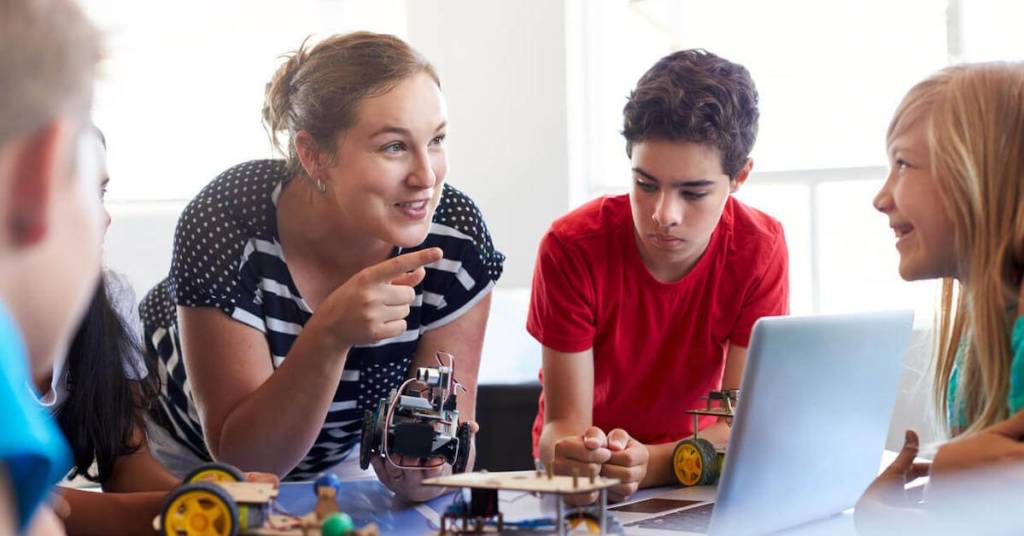

Global Education Monitoring Report
- 2023 GEM REPORT
Technology in education
- Recommendations
- 2023 Webpage
- Press Release
- RELATED PUBLICATIONS
- Background papers
- 2021/2 GEM Report
- 2020 Report
- 2019 Report
- 2017/8 Report
- 2016 Report
A tool on whose terms?
Ismael Martínez Sánchez/ProFuturo
- Monitoring SDG 4
- 2023 webpage
Major advances in technology, especially digital technology, are rapidly transforming the world. Information and communication technology (ICT) has been applied for 100 years in education, ever since the popularization of radio in the 1920s. But it is the use of digital technology over the past 40 years that has the most significant potential to transform education. An education technology industry has emerged and focused, in turn, on the development and distribution of education content, learning management systems, language applications, augmented and virtual reality, personalized tutoring, and testing. Most recently, breakthroughs in artificial intelligence (AI), methods have increased the power of education technology tools, leading to speculation that technology could even supplant human interaction in education.
In the past 20 years, learners, educators and institutions have widely adopted digital technology tools. The number of students in MOOCs increased from 0 in 2012 to at least 220 million in 2021. The language learning application Duolingo had 20 million daily active users in 2023, and Wikipedia had 244 million page views per day in 2021. The 2018 PISA found that 65% of 15-year-old students in OECD countries were in schools whose principals agreed that teachers had the technical and pedagogical skills to integrate digital devices in instruction and 54% in schools where an effective online learning support platform was available; these shares are believed to have increased during the COVID-19 pandemic. Globally, the percentage of internet users rose from 16% in 2005 to 66% in 2022. About 50% of the world’s lower secondary schools were connected to the internet for pedagogical purposes in 2022.
The adoption of digital technology has resulted in many changes in education and learning. The set of basic skills that young people are expected to learn in school, at least in richer countries, has expanded to include a broad range of new ones to navigate the digital world. In many classrooms, paper has been replaced by screens and pens by keyboards. COVID-19 can be seen as a natural experiment where learning switched online for entire education systems virtually overnight. Higher education is the subsector with the highest rate of digital technology adoption, with online management platforms replacing campuses. The use of data analytics has grown in education management. Technology has made a wide range of informal learning opportunities accessible.
Yet the extent to which technology has transformed education needs to be debated. Change resulting from the use of digital technology is incremental, uneven and bigger in some contexts than others. The application of digital technology varies by community and socioeconomic level, by teacher willingness and preparedness, by education level, and by country income. Except in the most technologically advanced countries, computers and devices are not used in classrooms on a large scale. Technology use is not universal and will not become so any time soon. Moreover, evidence is mixed on its impact: Some types of technology seem to be effective in improving some kinds of learning. The short- and long-term costs of using digital technology appear to be significantly underestimated. The most disadvantaged are typically denied the opportunity to benefit from this technology.
Too much attention on technology in education usually comes at a high cost. Resources spent on technology, rather than on classrooms, teachers and textbooks for all children in low- and lower-middle-income countries lacking access to these resources are likely to lead to the world being further away from achieving the global education goal, SDG 4. Some of the world’s richest countries ensured universal secondary schooling and minimum learning competencies before the advent of digital technology. Children can learn without it.
However, their education is unlikely to be as relevant without digital technology. The Universal Declaration of Human Rights defines the purpose of education as promoting the ‘full development of the human personality’, strengthening ‘respect for … fundamental freedoms’ and promoting ‘understanding, tolerance and friendship’. This notion needs to move with the times. An expanded definition of the right to education could include effective support by technology for all learners to fulfil their potential, regardless of context or circumstance.
Clear objectives and principles are needed to ensure that technology use is of benefit and avoids harm. The negative and harmful aspects in the use of digital technology in education and society include risk of distraction and lack of human contact. Unregulated technology even poses threats to democracy and human rights, for instance through invasion of privacy and stoking of hatred. Education systems need to be better prepared to teach about and through digital technology, a tool that must serve the best interests of all learners, teachers and administrators. Impartial evidence showing that technology is being used in some places to improve education, and good examples of such use, need to be shared more widely so that the optimal mode of delivery can be assured for each context.
CAN TECHNOLOGY HELP SOLVE THE MOST IMPORTANT CHALLENGES IN EDUCATION?
Discussions about education technology are focused on technology rather than education. The first question should be: What are the most important challenges in education? As a basis for discussion, consider the following three challenges:
- Equity and inclusion: Is fulfilment of the right to choose the education one wants and to realize one’s full potential through education compatible with the goal of equality? If not, how can education become the great equalizer?
- Quality: Do education’s content and delivery support societies in achieving sustainable development objectives? If not, how can education help learners to not only acquire knowledge but also be agents of change?
- Efficiency: Does the current institutional arrangement of teaching learners in classrooms support the achievement of equity and quality? If not, how can education balance individualized instruction and socialization needs?
How best can digital technology be included in a strategy to tackle these challenges, and under what conditions? Digital technology packages and transmits information on an unprecedented scale at high speed and low cost. Information storage has revolutionized the volume of accessible knowledge. Information processing enables learners to receive immediate feedback and, through interaction with machines, adapt their learning pace and trajectory: Learners can organize the sequence of what they learn to suit their background and characteristics. Information sharing lowers the cost of interaction and communication. But while such technology has tremendous potential, many tools have not been designed for application to education. Not enough attention has been given to how they are applied in education and even less to how they should be applied in different education contexts.
On the question of equity and inclusion , ICT – and digital technology in particular – helps lower the education access cost for some disadvantaged groups: Those who live in remote areas are displaced, face learning difficulties, lack time or have missed out on past education opportunities. But while access to digital technology has expanded rapidly, there are deep divides in access. Disadvantaged groups own fewer devices, are less connected to the internet (Figure 1) and have fewer resources at home. The cost of much technology is falling rapidly but is still too high for some. Households that are better off can buy technology earlier, giving them more advantages and compounding disparity. Inequality in access to technology exacerbates existing inequality in access to education, a weakness exposed during the COVID-19 school closures.
Figure 1: Internet connectivity is highly unequal
Percentage of 3- to 17-year-olds with internet connection at home, by wealth quintile, selected countries, 2017–19 Source: UNICEF database.
Education quality is a multifaceted concept. It encompasses adequate inputs (e.g. availability of technology infrastructure), prepared teachers (e.g. teacher standards for technology use in classrooms), relevant content (e.g. integration of digital literacy in the curriculum) and individual learning outcomes (e.g. minimum levels of proficiency in reading and mathematics). But education quality should also encompass social outcomes. It is not enough for students to be vessels receiving knowledge; they need to be able to use it to help achieve sustainable development in social, economic and environmental terms.
There are a variety of views on the extent to which digital technologies can enhance education quality. Some argue that, in principle, digital technology creates engaging learning environments, enlivens student experiences, simulates situations, facilitates collaboration and expands connections. But others say digital technology tends to support an individualized approach to education, reducing learners’ opportunities to socialize and learn by observing each other in real-life settings. Moreover, just as new technology overcomes some constraints, it brings its own problems. Increased screen time has been associated with adverse impact on physical and mental health. Insufficient regulation has led to unauthorized use of personal data for commercial purposes. Digital technology has also helped spread misinformation and hate speech, including through education.
Improvements to efficiency may be the most promising way for digital technology to make a difference in education. Technology is touted as being able to reduce the time students and teachers spend on menial tasks, time that can be used in other, educationally more meaningful activities. However, there are conflicting views on what is meaningful. The way that education technology is used is more complex than just a substitution of resources. Technology may be one-to-many, one-to-one or peer-to-peer technology. It may require students to learn alone or with others, online or offline, independently or networked. It delivers content, creates learner communities and connects teachers with students. It provides access to information. It may be used for formal or informal learning and can assess what has been learned. It is used as a tool for productivity, creativity, communication, collaboration, design and data management. It may be professionally produced or have user-generated content. It may be specific to schools and place-based or transcend time and place. As in any complex system, each technology tool involves distinct infrastructure, design, content and pedagogy, and each may promote different types of learning.
Technology is evolving too fast to permit evaluation that could inform decisions on legislation, policy and regulation. Research on technology in education is as complex as technology itself. Studies evaluate experiences of learners of various ages using various methodologies applied in contexts as different as self-study, classrooms and schools of diverse sizes and features, non-school settings, and at system level. Findings that apply in some contexts are not always replicable elsewhere. Some conclusions can be drawn from long-term studies as technologies mature but there is an endless stream of new products. Meanwhile, not all impact can be easily measured, given technology’s ubiquity, complexity, utility and heterogeneity. In brief, while there is much general research on education technology, the amount of research for specific applications and contexts is insufficient, making it difficult to prove that a particular technology enhances a particular kind of learning.
Why is there often the perception nevertheless that technology can address major education challenges? To understand the discourse around education technology, it is necessary to look behind the language being used to promote it, and the interests it serves. Who frames the problems technology should address? What are the consequences of such framing for education? Who promotes education technology as a precondition for education transformation? How credible are such claims? What criteria and standards need to be set to evaluate digital technology’s current and potential future contribution to education so as to separate hype from substance? Can evaluation go beyond short-term assessments of impact on learning and capture potential far-reaching consequences of the generalized use of digital technology in education?
Exaggerated claims about technology go hand in hand with exaggerated estimates of its global market size. In 2022, business intelligence providers’ estimates ranged from USD 123 billion to USD 300 billion. These accounts are almost always projected forward, predicting optimistic expansion, yet they fail to give historic trends and verify whether past projections proved true. Such reporting routinely characterizes education technology as essential and technology companies as enablers and disruptors. If optimistic projections are not fulfilled, responsibility is implicitly placed on governments as a way of maintaining indirect pressure on them to increase procurement. Education is criticized as being slow to change, stuck in the past and a laggard when it comes to innovation. Such coverage plays on users’ fascination with novelty but also their fear of being left behind.
The sections below further explore the three challenges this report addresses: equity and inclusion (in terms of access to education for disadvantaged groups and access to content), quality (in terms of teaching through and about digital technology) and efficiency (in terms of education management). After identifying technology’s potential to tackle these challenges, it discusses three conditions that need to be met for that potential to be fulfilled: equitable access, appropriate governance and regulation, and sufficient teacher capacity.
EQUITY AND INCLUSION: ACCESS FOR DISADVANTAGED GROUPS
A wide range of technology brings education to hard-to-reach learners. Technology has historically opened up education to learners facing significant obstacles in access to schools or well-trained teachers. Interactive radio instruction is used in nearly 40 countries. In Nigeria, radio instruction combined with print and audiovisual materials has been used since the 1990s, reaching nearly 80% of nomads and increasing their literacy, numeracy and life skills. Television has helped educate marginalized groups, notably in Latin America and the Caribbean. The Telesecundaria programme in Mexico, combining televised lessons with in-class support and extensive teacher training, increased secondary school enrolment by 21%. Mobile learning devices, often the only type of device accessible to disadvantaged learners, have been used in hard-to-reach areas and emergencies to share educational materials; complement in-person or remote channels; and foster interactions between students, teachers and parents, notably during COVID-19. Adults have been the main target of online distance learning, with open universities having increased participation for both working and disadvantaged adults.
Inclusive technology supports accessibility and personalization for learners with disabilities. Assistive technology removes learning and communication barriers, with numerous studies reporting a significant positive impact on academic engagement, social participation and the well-being of learners with disabilities. However, such devices remain inaccessible and unaffordable in many countries, and teachers often lack specialized training to use them effectively in learning environments. While people with disabilities used to rely exclusively on specialized devices to gain access to education, technology platforms and devices are increasingly incorporating accessibility features, which support inclusive, personalized learning for all students.
Technology supports learning continuity in emergencies. Mapping of 101 distance education projects in crisis contexts in 2020 showed that 70% used radio, television and basic mobile phones. During the Boko Haram crisis in Nigeria, the Technology Enhanced Learning for All programme used mobile phones and radios to support the learning continuity of 22,000 disadvantaged children, with recorded improvement in literacy and numeracy skills. However, there are significant gaps in terms of rigorous evaluation of education technology in emergencies, despite some limited recorded impact. Meanwhile, most projects are led by non-state actors as short-term crisis responses, raising sustainability concerns; education ministries implemented only 12% of the 101 projects.
Technology supported learning during COVID-19, but millions were left out. During school closures, 95% of education ministries carried out some form of distance learning, potentially reaching over 1 billion students globally. Many of the resources used during the pandemic were first developed in response to previous emergencies or rural education, with some countries building on decades of experience with remote learning. Sierra Leone revived the Radio Teaching Programme, developed during the Ebola crisis, one week after schools closed. Mexico expanded content from its Telesecundaria programme to all levels of education. However, at least half a billion, or 31% of students worldwide – mostly the poorest (72%) and those in rural areas (70%) – could not be reached by remote learning. Although 91% of countries used online learning platforms to deliver distance learning during school closures, the platforms only reached a quarter of students globally. For the rest, low-tech interventions such as radio and television were largely used, in combination with paper-based materials and mobile phones for increased interactivity.
Some countries are expanding existing platforms to reach marginalized groups. Less than half of all countries developed long-term strategies for increasing their resilience and the sustainability of interventions as part of their COVID-19 response plans. Many have abandoned distance learning platforms developed during COVID-19, while others are repurposing them to reach marginalized learners. The digital platform set up in Ukraine during the pandemic was expanded once the war broke out in 2022, allowing 85% of schools to complete the academic year.

EQUITY AND INCLUSION: ACCESS TO CONTENT
Technology facilitates content creation and adaptation. Open educational resources (OERs) encourage the reuse and repurposing of materials to cut development time, avoid duplication of work and make materials more context-specific or relevant to learners. They also significantly reduce the cost of access to content. In the US state of North Dakota, an initial investment of USD 110,000 to shift to OERs led to savings of over USD 1 million in student costs. Social media increases access to user-generated content. YouTube, a major player in both formal and informal learning, is used by about 80% of the world’s top 113 universities. Moreover, collaborative digital tools can improve the diversity and quality of content creation. In South Africa, the Siyavule initiative supported tutor collaboration on the creation of primary and secondary education textbooks.
Digitization of educational content simplifies access and distribution. Many countries, including Bhutan and Rwanda, have created static digital versions of traditional textbooks to increase availability. Others, including India and Sweden, have produced digital textbooks that encourage interactivity and multimodal learning. Digital libraries and educational content repositories such as the National Academic Digital Library of Ethiopia, National Digital Library of India and Teachers Portal in Bangladesh help teachers and learners find relevant materials. Learning management platforms, which have become a key part of the contemporary learning environment, help organize content by integrating digital resources into course structures.
Open access resources help overcome barriers. Open universities and MOOCs can eliminate time, location and cost barriers to access. In Indonesia, where low participation in tertiary education is largely attributed to geographical challenges, MOOCs play an important role in expanding access to post-secondary learning. During COVID-19, MOOC enrolment surged, with the top three providers adding as many users in April 2020 as in all of 2019. Technology can also remove language barriers. Translation tools help connect teachers and learners from various countries and increase the accessibility of courses by non-native students.
Ensuring and assessing the quality of digital content is difficult. The sheer quantity of content and its decentralized production pose logistical challenges for evaluation. Several strategies have been implemented to address this. China established specific quality criteria for MOOCs to be nationally recognized. The European Union developed its OpenupED quality label. India strengthened the link between non-formal and formal education. Micro-credentials are increasingly used to ensure that institution and learner both meet minimum standards. Some platforms aim to improve quality by recentralizing content production. YouTube, for example, has been funnelling financing and resources to a few trusted providers and partnering with well-established education institutions.
Technology may reinforce existing inequality in both access to and production of content. Privileged groups still produce most content. A study of higher-education repositories with OER collections found that nearly 90% were created in Europe or North America; 92% of the material in the OER Commons global library is in English. This influences who has access to digital content. MOOCs, for example, mainly benefit educated learners – studies have shown around 80% of participants on major platforms already have a tertiary degree – and those from richer countries. The disparity is due to divides in digital skills, internet access, language and course design. Regional MOOCs cater to local needs and languages but can also worsen inequality.
TEACHING AND LEARNING
Technology has been used to support teaching and learning in multiple ways. Digital technology offers two broad types of opportunities. First, it can improve instruction by addressing quality gaps, increasing opportunities to practise, increasing available time and personalizing instruction. Second, it can engage learners by varying how content is represented, stimulating interaction and prompting collaboration. Systematic reviews over the past two decades on technology’s impact on learning find small to medium-sized positive effects compared to traditional instruction. However, evaluations do not always isolate technology’s impact in an intervention, making it difficult to attribute positive effects to technology alone rather than to other factors, such as added instruction time, resources or teacher support. Technology companies can have disproportionate influence on evidence production. For example, Pearson funded studies contesting independent analysis that showed its products had no impact.
The prevalence of ICT use in classrooms is not high, even in the world’s richest countries. The 2018 PISA found that only about 10% of 15-year-old students in over 50 participating education systems used digital devices for more than an hour a week in mathematics and science lessons, on average (Figure 2) . The 2018 International Computer and Information Literacy Study (ICILS) showed that in the 12 participating education systems, simulation and modelling software in classrooms was available to just over one third of students, with country levels ranging from 8% in Italy to 91% in Finland.
Figure 2: Even in upper-middle- and high-income countries, technology use in mathematics and science classrooms is limited
Percentage of 15-year-old students who used digital devices for at least one hour per week in mathematics or science classroom lessons, selected upper-middle- and high-income countries, 2018 Source: 2018 PISA database.
Recorded lessons can address teacher quality gaps and improve teacher time allocation. In China, lesson recordings from high-quality urban teachers were delivered to 100 million rural students. An impact evaluation showed improvements in Chinese skills by 32% and a 38% long-term reduction in the rural–urban earning gap. However, just delivering materials without contextualizing and providing support is insufficient. In Peru, the One Laptop Per Child programme distributed over 1 million laptops loaded with content, but no positive impact on learning resulted, partly due to the focus on provision of devices instead of the quality of pedagogical integration.
Enhancing technology-aided instruction with personalization can improve some types of learning. Personalized adaptive software generates analytics that can help teachers track student progress, identify error patterns, provide differentiated feedback and reduce workload on routine tasks. Evaluations of the use of a personalized adaptive software in India documented learning gains in after-school settings and for low-performing students. However, not all widely used software interventions have strong evidence of positive effects compared to teacher-led instruction. A meta-analysis of studies on an AI learning and assessment system that has been used by over 25 million students in the United States found it was no better than traditional classroom teaching in improving outcomes.
Varied interaction and visual representation can enhance student engagement. A meta-analysis of 43 studies published from 2008 to 2019 found that digital games improved cognitive and behavioural outcomes in mathematics. Interactive whiteboards can support teaching and learning if well integrated in pedagogy; but in the United Kingdom, despite large-scale adoption, they were mostly used to replace blackboards. Augmented, mixed or virtual reality used as an experiential learning tool for repeated practice in life-like conditions in technical, vocational and scientific subjects is not always as effective as real-life training but may be superior to other digital methods, such as video demonstrations.
Technology offers teachers low-cost and convenient ways to communicate with parents. The Colombian Institute of Family Welfare’s distance education initiative, which targeted 1.7 million disadvantaged children, relied on social media platforms to relay guidance to caregivers on pedagogical activities at home. However, uptake and effectiveness of behavioural interventions targeting caregivers are limited by parental education levels, as well as lack of time and material resources.
Student use of technology in classrooms and at home can be distracting, disrupting learning. A meta-analysis of research on student mobile phone use and its impact on education outcomes, covering students from pre-primary to higher education in 14 countries, found a small negative effect, and a larger one at the university level. Studies using PISA data indicate a negative association between ICT use and student performance beyond a threshold of moderate use. Teachers perceive tablet and phone use as hampering classroom management. More than one in three teachers in seven countries participating in the 2018 ICILS agreed that ICT use in classrooms distracted students. Online learning relies on student ability to self-regulate and may put low-performing and younger learners at increased risk of disengagement.
DIGITAL SKILLS
The definition of digital skills has been evolving along with digital technology. An analysis for this report shows that 54% of countries have identified digital skills standards for learners. The Digital Competence Framework for Citizens (DigComp), developed on behalf of the European Commission, has five competence areas: information and data literacy, communication and collaboration, digital content creation, safety, and problem-solving. Some countries have adopted digital skills frameworks developed by non-state, mostly commercial, actors. The International Computer Driving Licence (ICDL) has been promoted as a ‘digital skills standard’ but is associated mainly with Microsoft applications. Kenya and Thailand have endorsed the ICDL as the digital literacy standard for use in schools.
Digital skills are unequally distributed. In the 27 European Union (EU) countries, 54% of adults had at least basic digital skills in 2021. In Brazil, 31% of adults had at least basic skills, but the level was twice as high in urban as in rural areas, three times as high among those in the labour force as among those outside it, and nine times as high in the top socioeconomic group as in the two bottom groups. The overall gender gap in digital skills is small, but wider in specific skills. In 50 countries, 6.5% of males and 3.2% of females could write a computer program. In Belgium, Hungary and Switzerland, no more than 2 women for every 10 men could program; in Albania, Malaysia and Palestine, 9 women for every 10 men could do so. According to the 2018 PISA, 5% of 15-year-olds with the strongest reading skills but 24% of those with the weakest ones were at risk of being misled by a typical phishing email.
Formal skills training may not be the main way of acquiring digital skills. About one quarter of adults in EU countries, ranging from 16% in Italy to 40% in Sweden, had acquired skills through a ‘formalised educational institution’. Informal learning, such as self-study and informal assistance from colleagues, relatives and friends, was used by twice as many. Still, formal education is important: In 2018, those with tertiary education in Europe were twice as likely (18%) as those with upper secondary education (9%) to engage in free online training or self-study to improve their computer, software or application use. Solid mastery of literacy and numeracy skills is positively associated with mastery of at least some digital skills.
A curriculum content mapping of 16 education systems showed that Greece and Portugal dedicated less than 10% of the curriculum to data and media literacy while Estonia and the Republic of Korea embedded both in half their curricula. In some countries, media literacy in curricula is explicitly connected to critical thinking in subject disciplines, as under Georgia’s New School Model. Asia is characterized by a protectionist approach to media literacy that prioritizes information control over education. But in the Philippines, the Association for Media and Information Literacy successfully advocated for incorporation of media and information literacy in the curriculum, and it is now a core subject in grades 11 and 12.
Digital skills in communication and collaboration matter in hybrid learning arrangements. Argentina promoted teamwork skills as part of a platform for programming and robotics competitions in primary and secondary education. Mexico offers teachers and students digital education resources and tools for remote collaboration, peer learning and knowledge sharing. Ethical digital behaviour includes rules, conventions and standards to be learned, understood and practised by digital users when using digital spaces. Digital communication’s anonymity, invisibility, asynchronicity and minimization of authority can make it difficult for individuals to understand its complexities.
Competences in digital content creation include selecting appropriate delivery formats and creating copy, audio, video and visual assets; integrating digital content; and respecting copyright and licences. The ubiquitous use of social media has turned content creation into a skill with direct application in electronic commerce. In Indonesia, the Siberkreasi platform counts collaborative engagement among its core activities. The Kenya Copyright Board collaborates closely with universities to provide copyright education and conducts frequent training sessions for students in the visual arts and ICT.
Education systems need to strengthen preventive measures and respond to many safety challenges, from passwords to permissions, helping learners understand the implications of their online presence and digital footprint. In Brazil, 29% of schools have conducted debates or lectures on privacy and data protection. In New Zealand, the Te Mana Tūhono (Power of Connectivity) programme delivers digital protection and security services to almost 2,500 state and state-integrated schools. A systematic review of interventions in Australia, Italy, Spain and the United States estimated that the average programme had a 76% chance of reducing cyberbullying perpetration. In Wales, United Kingdom, the government has advised schools how to prepare for and respond to harmful viral online content and hoaxes.
The definition of problem-solving skills varies widely among education systems. Many countries perceive them in terms of coding and programming and as part of a computer science curriculum that includes computational thinking, algorithm use and automation. A global review estimated that 43% of students in high-income countries, 62% in upper-middle-income, 5% in lower-middle-income but no students in low-income countries take computer science as compulsory in primary and/or secondary education. Only 20% of education systems require schools to offer computer science as an elective or core course. Non-state actors often support coding and programming skills. In Chile, Code.org has partnered with the government to provide educational resources in computer science.
EDUCATION MANAGEMENT
Education management information systems focus on efficiency and effectiveness. Education reforms have been characterized by increased school autonomy, target setting and results-based performance, all of which require more data. By one measure, since the 1990s, the number of policies making reference to data, statistics and information has increased by 13 times in high-income, 9 times in upper-middle-income, and 5 times in low- and lower-middle-income countries. But only 54% of countries globally – and as low as 22% in sub-Saharan Africa – have unique student identification mechanisms.
Geospatial data can support education management. Geographical information systems help address equity and efficiency in infrastructure and resource distribution in education systems. School mapping has been used to foster diversity and reduce inequality of opportunity. Ireland links three databases to decide in which of its 314 planning areas to build new schools. Geospatial data can identify areas where children live too far from the nearest school. For instance, it has been estimated that 5% of the population in Guatemala and 41% in the United Republic of Tanzania live more than 3 kilometres away from the nearest primary school.
Education management information systems struggle with data integration. In 2017, Malaysia introduced the Education Data Repository as part of its 2019–23 ICT Transformation Plan to progressively integrate its 350 education data systems and applications scattered across institutions. By 2019, it had integrated 12 of its main data systems, aiming for full integration through a single data platform by the end of 2023. In New Zealand, schools had been procuring student management systems independently and lack of interoperability between them was preventing authorities from tracking student progress. In 2019, the government began setting up the National Learner Repository and Data Exchange to be hosted in cloud data centres, but deployment was paused in 2021 due to cybersecurity concerns. European countries have been addressing interoperability concerns collectively to facilitate data sharing between countries and across multiple applications used in higher-education management through the EMREX project.
Computer-based assessments and computer adaptive testing have been replacing many paper-based assessments. They reduce test administration costs, improve measurement quality and provide rapid scoring. As more examinations shift online, the need for online cheating detection and proctoring tools has also increased. While these can reduce cheating, their effectiveness should be weighed against fairness and psychological effects. Evidence on the quality and usefulness of technology-based assessments has started to emerge, but much less is known about cost efficiency. Among 34 papers on technology-based assessments reviewed for this report, transparent data on cost were lacking.
Learning analytics can increase formative feedback and enable early detection systems. In China, learning analytics has been used to identify learners’ difficulties, predict learning trajectories and manage teacher resources. In the United States, Course Signals is a system used to flag the likelihood of a student not passing a course; educators can then target them for additional support. However, learning analytics requires all actors to have sufficient data literacy. Successful education systems typically have absorptive capacity, including strong school leaders and confident teachers willing to innovate. Yet often seemingly trivial issues, such as maintenance and repair, are ignored or underestimated.
ACCESS TO TECHNOLOGY: EQUITY, EFFICIENCY AND SUSTAINABILITY
Access to electricity and devices is highly unequal between and within countries. In 2021, almost 9% of the global population – and more than 70% of people in rural sub-Saharan Africa – lacked access to electricity. Globally, one in four primary schools do not have electricity. A 2018 study in Cambodia, Ethiopia, Kenya, Myanmar, Nepal and Niger found that 31% of public schools were on grid and 9% were off grid, with only 16% enjoying uninterrupted power supply. Globally, 46% of households had a computer at home in 2020; the share of schools with computers for pedagogical purposes was 47% in primary, 62% in lower secondary and 76% in upper secondary education. There were at most 10 computers per 100 students in Brazil and Morocco but 160 computers per 100 students in Luxembourg, according to the 2018 PISA.
Internet access, a vital enabler of economic, social and cultural rights, is also unequal. In 2022, two in three people globally used the internet. In late 2021, 55% of the world’s population had mobile broadband access. In low- and middle-income countries, 16% less women than men used mobile internet in 2021. An estimated 3.2 billion people do not use mobile internet services despite being covered by a mobile broadband network. Globally, 40% of primary, 50% of lower secondary and 65% of upper secondary schools are connected to the internet. In India, 53% of private unaided and 44% of private aided schools are connected, compared with only 14% of government schools.
Various policies are used to improve access to devices. Some one in five countries have policies granting subsidies or deductions to buy devices. One-to-one technology programmes were established in 30% of countries at one time; currently only 15% of countries pursue such programmes. A number of upper-middle- and high-income countries are shifting from providing devices to allowing students to use their own devices in school. Jamaica adopted a Bring Your Own Device policy framework in 2020 to aim for sustainability.
Some countries champion free and open source software. Education institutions with complex ICT infrastructure, such as universities, can benefit from open source software to add new solutions or functionalities. By contrast, proprietary software does not permit sharing and has vendor locks that hinder interoperability, exchange and updates. In India, the National e-Governance Plan makes it mandatory for all software applications and services used in government to be built on open source software to achieve efficiency, transparency, reliability and affordability.
Countries are committed to universal internet provision at home and in school. About 85% of countries have policies to improve school or learner connectivity and 38% have laws on universal internet provision. A review of 72 low- and middle-income countries found that 29 had used universal service funds to reduce costs for underserved groups. In Kyrgyzstan, renegotiated contracts helped cut prices by nearly half and almost doubled internet speed. In Costa Rica, the Hogares Conectados (Connected Households) programme, which provided an internet cost subsidy to the poorest 60% of households with school-age children, helped reduce the share of unconnected households from 41% in 2016 to 13% in 2019. Zero-rating, or providing free internet access for education or other purposes, has been used, especially during COVID-19, but is not without problems, as it violates the net neutrality principle.
Education technology is often underutilized. In the United States, an average of 67% of education software licences were unused and 98% were not used intensively. According to the EdTech Genome Project, 85% of some 7,000 pedagogical tools, which cost USD 13 billion, were ‘either a poor fit or implemented incorrectly’. Less than one in five of the top 100 education technology tools used in classrooms met the requirements of the US Every Student Succeeds Act. Research had been published for 39% of these tools but the research was aligned with the act in only 26% of cases.
Evidence needs to drive education technology decisions. A review in the United Kingdom found that only 7% of education technology companies had conducted randomized controlled trials, 12% had used third-party certification and 18% had engaged in academic studies. An online survey of teachers and administrators in 17 US states showed that only 11% requested peer-reviewed evidence prior to adopting education technology. Recommendations influence purchase decisions, yet ratings can be manipulated through fake reviews disseminated on social media. Few governments try to fill the evidence gap, so demand has grown for independent reviews. Edtech Tulna, a partnership between a private think tank and a public university in India, offers quality standards, an evaluation toolkit and publicly available expert reviews.
Education technology procurement decisions need to take economic, social and environmental sustainability into account. With respect to economic considerations, it is estimated that initial investment in education technology accounts for just 25% or less of the eventual total cost. Regarding social concerns, procurement processes need to address equity, accessibility, local ownership and appropriation. In France, the Territoires Numériques Educatifs (Digital Educational Territories) initiative was criticized because not all subsidized equipment met local needs, and local governments were left out of the decisions on which equipment to purchase. Both issues have since been addressed. Concerning environmental considerations, it has been estimated that extending the lifespan of all laptops in the European Union by a year would save the equivalent of taking almost 1 million cars off the road in terms of CO2 emissions.
Regulation needs to address risks in education technology procurement. Public procurement is vulnerable to collusion and corruption. In 2019, Brazil’s Comptroller General of the Union found irregularities in the electronic bidding process for the purchase of 1.3 million computers, laptops and notebooks for state and municipal public schools. Decentralizing public procurement to local governments is one way to balance some of the risks. Indonesia has used its SIPLah e-commerce platform to support school-level procurement processes. However, decentralization is vulnerable to weak organizational capacity. A survey of administrators in 54 US school districts found that they had rarely carried out needs assessments.
GOVERNANCE AND REGULATION
Governance of the education technology system is fragmented. A department or an agency responsible for education technology has been identified in 82% of countries. Placing education ministries in charge of education technology strategies and plans could help ensure that decisions are primarily based on pedagogical principles. However, this is the case in just 58% of countries. In Kenya, the 2019 National Information, Communications and Technology Policy led the Ministry of Information, Communications and Technology to integrate ICT at all levels of education.
Participation is often limited in the development of education technology strategies and plans. Nepal established a Steering and a Coordination Committee under the 2013–17 ICT in Education Master Plan for intersectoral and inter-agency coordination and cooperation in its implementation. Including administrators, teachers and students can help bridge the knowledge gap with decision makers to ensure that education technology choices are appropriate. In 2022, only 41% of US education sector leaders agreed that they were regularly included in planning and strategic conversations about technology.
The private sector’s commercial interests can clash with government equity, quality and efficiency goals. In India, the government alerted families about the hidden costs of free online content. Other risks relate to data use and protection, privacy, interoperability and lock-in effects, whereby students and teachers are compelled to use specific software or platforms. Google, Apple and Microsoft produce education platforms tied to particular hardware and operating systems.
Privacy risks to children make their learning environment unsafe. One analysis found that 89% of 163 education technology products recommended for children’s learning during the COVID-19 pandemic could or did watch children outside school hours or education settings. In addition, 39 of 42 governments providing online education during the pandemic fostered uses that ‘risked or infringed’ upon children’s rights. Data used for predictive algorithms can bias predictions and decisions and lead to discrimination, privacy violations and exclusion of disadvantaged groups. The Cyberspace Administration of China and the Ministry of Education introduced regulations in 2019 requiring parental consent before devices powered by AI, such as cameras and headbands, could be used with students in schools and required data to be encrypted.
Children’s exposure to screen time has increased. A survey of screen time of parents of 3- to 8-year-olds in Australia, China, Italy, Sweden and the United States found that their children’s screen exposure increased by 50 minutes during the pandemic for both education and leisure. Extended screen time can negatively affect self-control and emotional stability, increasing anxiety and depression. Few countries have strict regulations on screen time. In China, the Ministry of Education limited the use of digital devices as teaching tools to 30% of overall teaching time. Less than one in four countries are banning the use of smartphones in schools. Italy and the United States have banned the use of specific tools or social media from schools. Cyberbullying and online abuse are rarely defined as offences but can fall under existing laws, such as stalking laws as in Australia and harassment laws in Indonesia.
Monitoring of data protection law implementation is needed. Only 16% of countries explicitly guarantee data privacy in education by law and 29% have a relevant policy, mainly in Europe and Northern America. The number of cyberattacks in education is rising. Such attacks increase exposure to theft of identity and other personal data, but capacity and funds to address the issue are often insufficient. Globally, 5% of all ransomware attacks targeted the education sector in 2022, accounting for more than 30% of cybersecurity breaches. Regulations on sharing children’s personal information are rare but are starting to emerge under the EU’s General Data Protection Regulation. China and Japan have binding instruments on protecting children’s data and information.
Technology has an impact on the teaching profession. Technology allows teachers to choose, modify and generate educational materials. Personalized learning platforms offer teachers customized learning paths and insights based on student data. During the COVID-19 pandemic, France facilitated access to 17 online teaching resource banks mapped against the national curriculum. The Republic of Korea temporarily eased copyright restrictions for teachers. Online teacher-student collaboration platforms provide access to support services, facilitate work team creation, allow participation in virtual sessions and promote sharing of learning materials.
Obstacles to integrating technology in education prevent teachers from fully embracing it. Inadequate digital infrastructure and lack of devices hinder teachers’ ability to integrate technology in their practice. A survey in 165 countries during the pandemic found that two in five teachers used their own devices, and almost one third of schools had only one device for education use. Some teachers lack training to use digital devices effectively. Older teachers may struggle to keep up with rapidly changing technology. The 2018 Teaching and Learning International Survey (TALIS) found that older teachers in 48 education systems had weaker skills and lower self-efficacy in using ICT. Some teachers may lack confidence. Only 43% of lower secondary school teachers in the 2018 TALIS said they felt prepared to use technology for teaching after training, and 78% of teachers in the 2018 ICILS were not confident in using technology for assessment.
Education systems support teachers in developing technology-related professional competencies. About half of education systems worldwide have ICT standards for teachers in a competency framework, teacher training framework, development plan or strategy. Education systems set up annual digital education days for teachers, promote OER, support the exchange of experiences and resources between teachers, and offer training. One quarter of education systems have legislation to ensure teachers are trained in technology, either through initial or in-service training. Some 84% of education systems have strategies for in-service teacher professional development, compared with 72% for pre-service teacher education in technology. Teachers can identify their development needs using digital self-assessment tools such as that provided by the Centre for Innovation in Brazilian Education.
Technology is changing teacher training. Technology is used to create flexible learning environments, engage teachers in collaborative learning, support coaching and mentoring, increase reflective practice, and improve subject or pedagogical knowledge. Distance education programmes have promoted teacher learning in South Africa and even equalled the impact of in-person training in Ghana. Virtual communities have emerged, primarily through social networks, for communication and resource sharing. About 80% of teachers surveyed in the Caribbean belonged to professional WhatsApp groups and 44% used instant messaging to collaborate at least once a week. In Senegal, the Reading for All programme used in-person and online coaching. Teachers considered face-to-face coaching more useful, but online coaching cost 83% less and still achieved a significant, albeit small, improvement in how teachers guided students’ reading practice. In Flanders, Belgium, KlasCement, a teacher community network created by a non-profit and now run by the Ministry of Education, expanded access to digital education and provided a platform for discussions on distance education during the pandemic.
Many actors support teacher professional development in ICT. Universities, teacher training institutions and research institutes provide specialized training, research opportunities and partnerships with schools for professional development in ICT. In Rwanda, universities collaborated with teachers and the government to develop the ICT Essentials for Teachers course. Teacher unions also advocate for policies that support teachers. The Confederation of Education Workers of the Argentine Republic established the right of teachers to disconnect. Civil society organizations, including the Carey Institute for Global Good, offer support through initiatives such as providing OER and online courses for refugee teachers in Chad, Kenya, Lebanon and Niger.

- IIEP Buenos Aires

- A global institute
- Governing Board
- Expert directory
- 60th anniversary
- Monitoring and evaluation
Latest news
- Upcoming events
- PlanED: The IIEP podcast
- Partnering with IIEP
- Career opportunities
- 11th Medium-Term Strategy
- Planning and management to improve learning
- Inclusion in education
- Using digital tools to promote transparency and accountability
- Ethics and corruption in education
- Digital technology to transform education
- Crisis-sensitive educational planning
- Rethinking national school calendars for climate-resilient learning
- Skills for the future
- Interactive map
- Foundations of education sector planning programmes
- Online specialized courses
- Customized, on-demand training
- Training in Buenos Aires
- Training in Dakar
- Preparation of strategic plans
- Sector diagnosis
- Costs and financing of education
- Tools for planning
- Crisis-sensitive education planning
- Supporting training centres
- Support for basic education quality management
- Gender at the Centre
- Teacher careers
- Geospatial data
- Cities and Education 2030
- Learning assessment data
- Governance and quality assurance
- School grants
- Early childhood education
- Flexible learning pathways in higher education
- Instructional leaders
- Planning for teachers in times of crisis and displacement
- Planning to fulfil the right to education
- Thematic resource portals
- Policy Fora
- Network of Education Policy Specialists in Latin America
- Publications
- Briefs, Papers, Tools
- Search the collection
- Visitors information
- Planipolis (Education plans and policies)
- IIEP Learning Portal
- Ethics and corruption ETICO Platform
- PEFOP (Vocational Training in Africa)
- SITEAL (Latin America)
- Policy toolbox
- Education for safety, resilience and social cohesion
- Health and Education Resource Centre
- Interactive Map
- Search deploy
- The institute
Digital technology is everywhere. How can it help plan better education systems?
C_ismael_martinez_sanchez-8308_1.jpg.
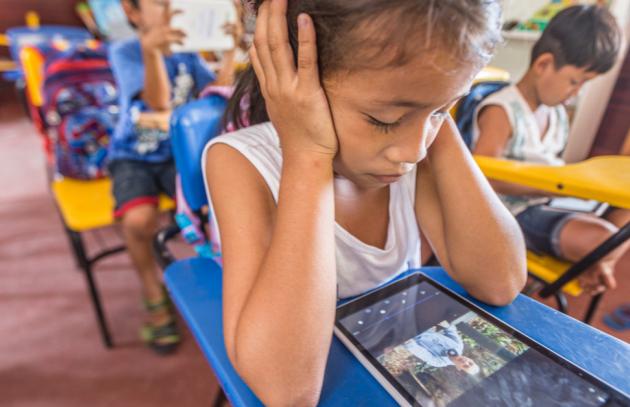
At its best, digital technologies can help build a more equitable and sustainable future. The 2023 GEM Report on technology and education , launched on 26 July 2023, similarly makes the case that, when used responsibly, digital technologies can help unlock the transformative power of education.
However, the journey has had many twists and turns. Over the years, technology has been seen as a threat, a pedagogical distraction, but also a panacea capable to solve a myriad of educational challenges. Today, the global education community embraces an overall more nuanced and balanced view – digital technology ushers in countless opportunities for new learning models, but also serious challenges that must be addressed to promote greater inclusion and equity.
The presence of technology in education today is unavoidable. In a post-pandemic context, we have learned that students are more likely to learn with technology than without it - especially in vulnerable and emergency contexts. It is also permeating the world of planning and management - the so-called behind-the-scenes of education. It is influencing how education systems are designed and redrawing the parameters for how educational administrations function.
When implemented at a macro level, technology has the capacity to produce significant impacts in education systems, offering tools and solutions that streamline processes and improve the efficiency of institutions.” -Martín Benavides, IIEP-UNESCO Director
3 ways technology can enhance planning
At IIEP, we have been working with countries to include technology in educational planning and management. From improved data collection to better transparency, here’s where we are seeing an impact in and through our work with ministries of education and their partners.
1. Technology can improve efficiency in the planning and management of education systems, including more equitable use of resources.
In countries worldwide, IIEP’s technical teams are seeing how technology can boost an Education Management Information System – or EMIS - the most important source of educational data. Technology can support everything from the collection, integration, processing, and maintenance, to the dissemination of data and information to improve decision-making, analysis, and policy formulation. EMIS is also key to monitoring progress toward educational goals and targets, both at the national and international levels.
Technology can also help create projections and modelling to manage the allocation of human and material resources. It can help planners find gaps in access to resources (e.g. teacher gaps in rural contexts) and fill them effectively and can help with time management. Tools such as context-specific school calendars , taking into account environmental and social variables (e.g. rainy seasons and harvest times) help to promote equity.
2. Technology can enhance transparency in the functioning of education.
Technology can provide open access to relevant information about how an education system functions, such as student performance reports. It can help construction open overnment where stakeholders can participate in formulating public policies and monitoring.
3. Technology can boost professional development.
Just like for teachers, technology is also used for the professional development of planners. Online learning platforms and communities of practice can provide resources that support peer-to-peer learning, the acquisition of new skills, and the dissemination of best practices .
These examples illustrate how digital tools in education reach far beyond classrooms. It can help planners do their jobs better and more efficiently, offering new pathways to improving educational quality and equity, now and in the future.
However, as the GEM report on technology and education explores, clear objectives and principles are needed to ensure that the use of technology avoids harm. To do this, it is crucial to understand some of the key challenges facing the integration of technology and its appropriate use in education today.
The challenge of access
Access is often the first challenge many think of when it comes to technology in education. Despite progress, the lack of equitable access to education in many regions of the world exacerbates educational inequalities, both at the individual and systemic levels.
The GEM report notes that, globally, only 40% of primary schools, 50% of lower secondary, and 65% of upper secondary schools have access to the Internet.
Additionally, learning gaps run the risk of widening as long as education systems exist without access to the necessary infrastructure, e.g., devices or connectivity.
During COVID-19, for example, a paradoxical situation arose: on the one hand, digital technologies helped to mitigate the effects of social isolation and made educational continuity possible. However, in their absence, socio-educational inequalities deepened.
To ensure that technologies do not lead to new inequalities, it is essential to promote and revitalize Internet access policies to ensure inclusion and equality in education, i.e. by placing vulnerable populations at the centre of policies.
The challenge of managing and maintaining technology
Technology is generally a private offering and this can complicate management processes in education. The diversity of suppliers is a factor, as choosing the right technology can be complex, especially when considering cost, quality, interoperability, and adaptability to specific educational needs.
Another frequent blind spot is placing an excessive focus on the procurement of devices and software without adequate consideration of how they align with the goals and needs of the education system, as well as the overarching digital transformation policies of states.
In terms of maintenance, the right infrastructure and technical support need to be in place to ensure that solutions function well, as seemingly prosaic factors, such as insufficient connectivity or lack of maintenance, can hinder their effective use.
To overcome these challenges related to technology management, spaces for dialogue with stakeholders must be fostered so that consensus can be built on the benefits and goals of integrating technology, robust mechanisms for evaluation, monitoring and learning, and committed institutional leadership.
In addition, the creation of specific public-private partnerships can achieve greater transparency in educational technology management processes.
The challenge of developing digital skills
The availability of technology does not necessarily guarantee its use. Just as the integration of digital technologies goes beyond the classroom, the challenge of developing digital competencies goes beyond students and teachers and must extend to all actors involved in the educational environment. Families, managers, and policy-makers must be included in this scheme to ensure that all actors can effectively contribute to the use of technology in the educational context and promote a digital culture in society at large.
What’s next?
Let’s focus on Latin America and the Caribbean, where despite more than two decades of integrating various types of digital policies, a deep learning crisis remains. Drawing on its Regional Forum on Education Policies, IIEP has put forward a number of recommendations to further exploit the use of technology in planning and management - with an equity lens.
First, sufficient resources are critical to finance educational change. To have a robust public education system that can close gaps and give everyone at least a minimum of opportunities to learn, constant investment is needed. But some countries fail to do this, either entirely or partially, often because of a lack of coordination or political will.
Second, it is critical to foster cross-sectoral coordination of education ministries with other government sectors. Many learning problems, especially those linked to conditions of extreme poverty, violence, or marginalization, cannot be solved by education policies alone.
Third, there must be a dialogue between the government and society as a whole. The more distant education policy decisions are from the multiple actors in the system, the less sustainable they will be.
Finally, to avoid having policies become distorted or diluted when they reach schools, there should be better articulation between central-level policy-making and district levels. This will help connect the dots in the transmission chain, making digital technologies a smoother journey for all.
- Leading for change: Q&A with chief of education planning from Saint Kitts and Nevis 28 May 2024
- IIEP Strategic Debates 24 May 2024
- Education in emergencies: Improving the Education in Emergencies (EiE) data landscape 24 May 2024
- Enhancing digital technology to transform education
Download the 2023 GEM Report: Technology in education
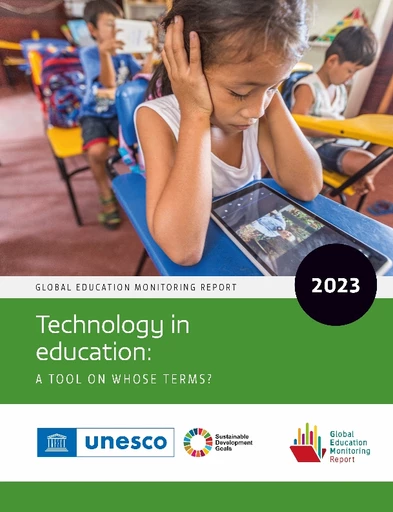
- Privacy Notice
Publication
Global education monitoring report summary, 2023: technology in education: a tool on whose terms? (hin)
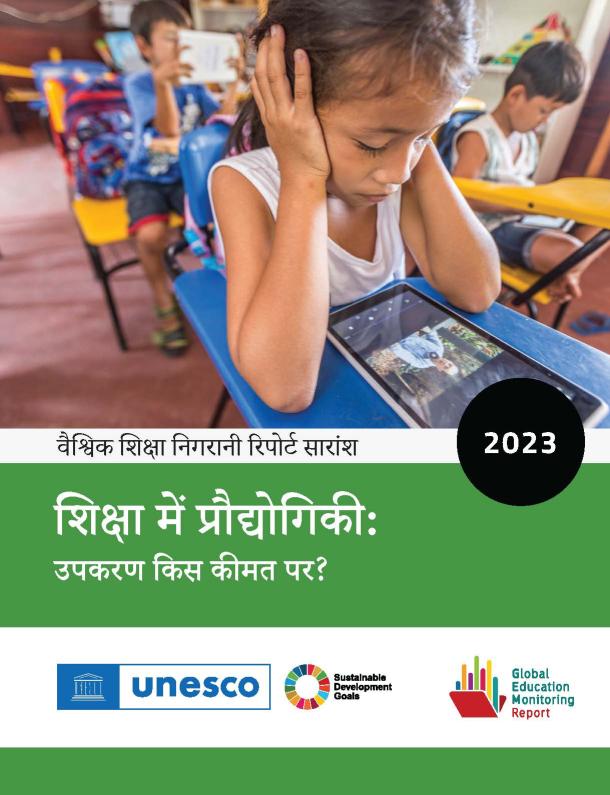
The new 2023 GEM Report on Technology in education: A tool on whose terms? addresses the use of technology in education around the world through the lenses of relevance, equity, scalability and sustainability.
It argues that education systems should always ensure that learners’ interests are placed at the center and that digital technologies are used to support an education based on human interaction rather than aiming at substituting it. The report looks at ways in which technology can help reach disadvantaged learners but also ensure more knowledge reaches more learners in more engaging and cheaper formats. It focuses on how quality can be improved, both in teaching and learning basic skills, and in developing the digital skills needed in daily life. It recognizes the role of technology in system management with special reference to assessment data and other education management information.
Related items
- Guidelines and tools
- Policy Advice
- Country page: India
- Topics: Flagship report
- Region: Asia and the Pacific
- UNESCO Office in New Delhi
- See more add

Other recent publications

Suggestions or feedback?
MIT News | Massachusetts Institute of Technology
- Machine learning
- Social justice
- Black holes
- Classes and programs
Departments
- Aeronautics and Astronautics
- Brain and Cognitive Sciences
- Architecture
- Political Science
- Mechanical Engineering
Centers, Labs, & Programs
- Abdul Latif Jameel Poverty Action Lab (J-PAL)
- Picower Institute for Learning and Memory
- Lincoln Laboratory
- School of Architecture + Planning
- School of Engineering
- School of Humanities, Arts, and Social Sciences
- Sloan School of Management
- School of Science
- MIT Schwarzman College of Computing
What 126 studies say about education technology
Press contact :.
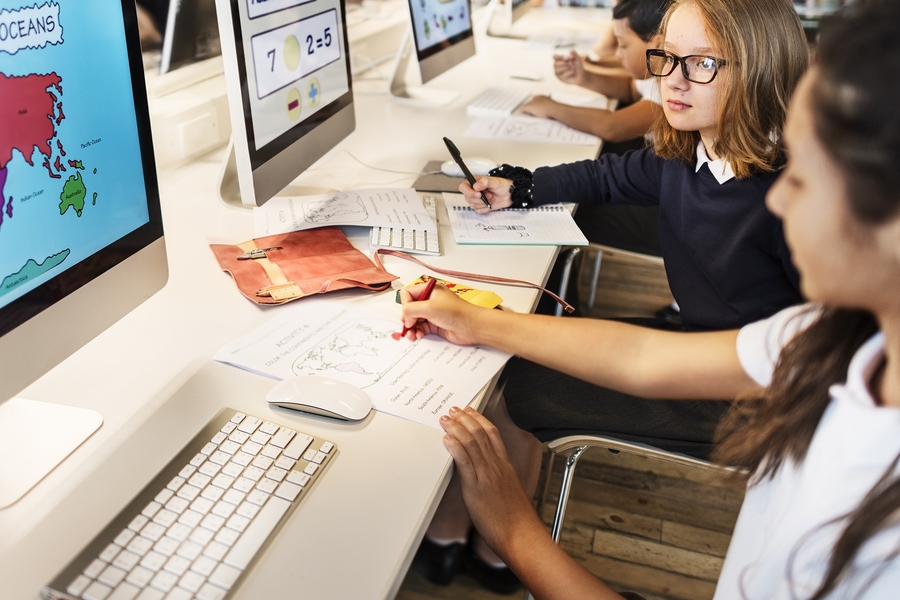
Previous image Next image
In recent years, there has been widespread excitement around the transformative potential of technology in education. In the United States alone, spending on education technology has now exceeded $13 billion . Programs and policies to promote the use of education technology may expand access to quality education, support students’ learning in innovative ways, and help families navigate complex school systems.
However, the rapid development of education technology in the United States is occurring in a context of deep and persistent inequality . Depending on how programs are designed, how they are used, and who can access them, education technologies could alleviate or aggravate existing disparities. To harness education technology’s full potential, education decision-makers, product developers, and funders need to understand the ways in which technology can help — or in some cases hurt — student learning.
To address this need, J-PAL North America recently released a new publication summarizing 126 rigorous evaluations of different uses of education technology. Drawing primarily from research in developed countries, the publication looks at randomized evaluations and regression discontinuity designs across four broad categories: (1) access to technology, (2) computer-assisted learning or educational software, (3) technology-enabled nudges in education, and (4) online learning.
This growing body of evidence suggests some areas of promise and points to four key lessons on education technology.
First, supplying computers and internet alone generally do not improve students’ academic outcomes from kindergarten to 12th grade, but do increase computer usage and improve computer proficiency. Disparities in access to information and communication technologies can exacerbate existing educational inequalities. Students without access at school or at home may struggle to complete web-based assignments and may have a hard time developing digital literacy skills.
Broadly, programs to expand access to technology have been effective at increasing use of computers and improving computer skills. However, computer distribution and internet subsidy programs generally did not improve grades and test scores and in some cases led to adverse impacts on academic achievement. The limited rigorous evidence suggests that distributing computers may have a more direct impact on learning outcomes at the postsecondary level.
Second, educational software (often called “computer-assisted learning”) programs designed to help students develop particular skills have shown enormous promise in improving learning outcomes, particularly in math. Targeting instruction to meet students’ learning levels has been found to be effective in improving student learning, but large class sizes with a wide range of learning levels can make it hard for teachers to personalize instruction. Software has the potential to overcome traditional classroom constraints by customizing activities for each student. Educational software programs range from light-touch homework support tools to more intensive interventions that re-orient the classroom around the use of software.
Most educational software that have been rigorously evaluated help students practice particular skills through personalized tutoring approaches. Computer-assisted learning programs have shown enormous promise in improving academic achievement, especially in math. Of all 30 studies of computer-assisted learning programs, 20 reported statistically significant positive effects, 15 of which were focused on improving math outcomes.
Third, technology-based nudges — such as text message reminders — can have meaningful, if modest, impacts on a variety of education-related outcomes, often at extremely low costs. Low-cost interventions like text message reminders can successfully support students and families at each stage of schooling. Text messages with reminders, tips, goal-setting tools, and encouragement can increase parental engagement in learning activities, such as reading with their elementary-aged children.
Middle and high schools, meanwhile, can help parents support their children by providing families with information about how well their children are doing in school. Colleges can increase application and enrollment rates by leveraging technology to suggest specific action items, streamline financial aid procedures, and/or provide personalized support to high school students.
Online courses are developing a growing presence in education, but the limited experimental evidence suggests that online-only courses lower student academic achievement compared to in-person courses. In four of six studies that directly compared the impact of taking a course online versus in-person only, student performance was lower in the online courses. However, students performed similarly in courses with both in-person and online components compared to traditional face-to-face classes.
The new publication is meant to be a resource for decision-makers interested in learning which uses of education technology go beyond the hype to truly help students learn. At the same time, the publication outlines key open questions about the impacts of education technology, including questions relating to the long-term impacts of education technology and the impacts of education technology on different types of learners.
To help answer these questions, J-PAL North America’s Education, Technology, and Opportunity Initiative is working to build the evidence base on promising uses of education technology by partnering directly with education leaders.
Education leaders are invited to submit letters of interest to partner with J-PAL North America through its Innovation Competition . Anyone interested in learning more about how to apply is encouraged to contact initiative manager Vincent Quan .
Share this news article on:
Related links.
- J-PAL Education, Technology, and Opportunity Initiative
- Education, Technology, and Opportunity Innovation Competition
- Article: "Will Technology Transform Education for the Better?"
- Abdul Latif Jameel Poverty Action Lab
- Department of Economics
Related Topics
- School of Humanities Arts and Social Sciences
- Education, teaching, academics
- Technology and society
- Computer science and technology
Related Articles

J-PAL North America calls for proposals from education leaders
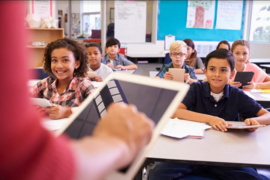
J-PAL North America’s Education, Technology, and Opportunity Innovation Competition announces inaugural partners
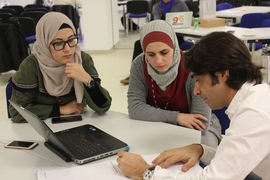
New learning opportunities for displaced persons

J-PAL North America announces new partnerships with three state and local governments

A new way to measure women’s and girls’ empowerment in impact evaluations
Previous item Next item
More MIT News

Scientists identify mechanism behind drug resistance in malaria parasite
Read full story →

Getting to systemic sustainability

New MIT-LUMA Lab created to address climate challenges in the Mediterranean region

MIT Press releases Direct to Open impact report

Modeling the threat of nuclear war

Modular, scalable hardware architecture for a quantum computer
- More news on MIT News homepage →
Massachusetts Institute of Technology 77 Massachusetts Avenue, Cambridge, MA, USA
- Map (opens in new window)
- Events (opens in new window)
- People (opens in new window)
- Careers (opens in new window)
- Accessibility
- Social Media Hub
- MIT on Facebook
- MIT on YouTube
- MIT on Instagram
This site belongs to UNESCO's International Institute for Educational Planning

IIEP Learning Portal

Search form
- issue briefs
- Improve learning
Information and communication technology (ICT) in education
Information and communications technology (ict) can impact student learning when teachers are digitally literate and understand how to integrate it into curriculum..
Schools use a diverse set of ICT tools to communicate, create, disseminate, store, and manage information.(6) In some contexts, ICT has also become integral to the teaching-learning interaction, through such approaches as replacing chalkboards with interactive digital whiteboards, using students’ own smartphones or other devices for learning during class time, and the “flipped classroom” model where students watch lectures at home on the computer and use classroom time for more interactive exercises.
When teachers are digitally literate and trained to use ICT, these approaches can lead to higher order thinking skills, provide creative and individualized options for students to express their understandings, and leave students better prepared to deal with ongoing technological change in society and the workplace.(18)
ICT issues planners must consider include: considering the total cost-benefit equation, supplying and maintaining the requisite infrastructure, and ensuring investments are matched with teacher support and other policies aimed at effective ICT use.(16)
Issues and Discussion
Digital culture and digital literacy: Computer technologies and other aspects of digital culture have changed the ways people live, work, play, and learn, impacting the construction and distribution of knowledge and power around the world.(14) Graduates who are less familiar with digital culture are increasingly at a disadvantage in the national and global economy. Digital literacy—the skills of searching for, discerning, and producing information, as well as the critical use of new media for full participation in society—has thus become an important consideration for curriculum frameworks.(8)
In many countries, digital literacy is being built through the incorporation of information and communication technology (ICT) into schools. Some common educational applications of ICT include:
- One laptop per child: Less expensive laptops have been designed for use in school on a 1:1 basis with features like lower power consumption, a low cost operating system, and special re-programming and mesh network functions.(42) Despite efforts to reduce costs, however, providing one laptop per child may be too costly for some developing countries.(41)
- Tablets: Tablets are small personal computers with a touch screen, allowing input without a keyboard or mouse. Inexpensive learning software (“apps”) can be downloaded onto tablets, making them a versatile tool for learning.(7)(25) The most effective apps develop higher order thinking skills and provide creative and individualized options for students to express their understandings.(18)
- Interactive White Boards or Smart Boards : Interactive white boards allow projected computer images to be displayed, manipulated, dragged, clicked, or copied.(3) Simultaneously, handwritten notes can be taken on the board and saved for later use. Interactive white boards are associated with whole-class instruction rather than student-centred activities.(38) Student engagement is generally higher when ICT is available for student use throughout the classroom.(4)
- E-readers : E-readers are electronic devices that can hold hundreds of books in digital form, and they are increasingly utilized in the delivery of reading material.(19) Students—both skilled readers and reluctant readers—have had positive responses to the use of e-readers for independent reading.(22) Features of e-readers that can contribute to positive use include their portability and long battery life, response to text, and the ability to define unknown words.(22) Additionally, many classic book titles are available for free in e-book form.
- Flipped Classrooms: The flipped classroom model, involving lecture and practice at home via computer-guided instruction and interactive learning activities in class, can allow for an expanded curriculum. There is little investigation on the student learning outcomes of flipped classrooms.(5) Student perceptions about flipped classrooms are mixed, but generally positive, as they prefer the cooperative learning activities in class over lecture.(5)(35)
ICT and Teacher Professional Development: Teachers need specific professional development opportunities in order to increase their ability to use ICT for formative learning assessments, individualized instruction, accessing online resources, and for fostering student interaction and collaboration.(15) Such training in ICT should positively impact teachers’ general attitudes towards ICT in the classroom, but it should also provide specific guidance on ICT teaching and learning within each discipline. Without this support, teachers tend to use ICT for skill-based applications, limiting student academic thinking.(32) To support teachers as they change their teaching, it is also essential for education managers, supervisors, teacher educators, and decision makers to be trained in ICT use.(11)
Ensuring benefits of ICT investments: To ensure the investments made in ICT benefit students, additional conditions must be met. School policies need to provide schools with the minimum acceptable infrastructure for ICT, including stable and affordable internet connectivity and security measures such as filters and site blockers. Teacher policies need to target basic ICT literacy skills, ICT use in pedagogical settings, and discipline-specific uses. (21) Successful implementation of ICT requires integration of ICT in the curriculum. Finally, digital content needs to be developed in local languages and reflect local culture. (40) Ongoing technical, human, and organizational supports on all of these issues are needed to ensure access and effective use of ICT. (21)
Resource Constrained Contexts: The total cost of ICT ownership is considerable: training of teachers and administrators, connectivity, technical support, and software, amongst others. (42) When bringing ICT into classrooms, policies should use an incremental pathway, establishing infrastructure and bringing in sustainable and easily upgradable ICT. (16) Schools in some countries have begun allowing students to bring their own mobile technology (such as laptop, tablet, or smartphone) into class rather than providing such tools to all students—an approach called Bring Your Own Device. (1)(27)(34) However, not all families can afford devices or service plans for their children. (30) Schools must ensure all students have equitable access to ICT devices for learning.
Inclusiveness Considerations
Digital Divide: The digital divide refers to disparities of digital media and internet access both within and across countries, as well as the gap between people with and without the digital literacy and skills to utilize media and internet.(23)(26)(31) The digital divide both creates and reinforces socio-economic inequalities of the world’s poorest people. Policies need to intentionally bridge this divide to bring media, internet, and digital literacy to all students, not just those who are easiest to reach.
Minority language groups: Students whose mother tongue is different from the official language of instruction are less likely to have computers and internet connections at home than students from the majority. There is also less material available to them online in their own language, putting them at a disadvantage in comparison to their majority peers who gather information, prepare talks and papers, and communicate more using ICT. (39) Yet ICT tools can also help improve the skills of minority language students—especially in learning the official language of instruction—through features such as automatic speech recognition, the availability of authentic audio-visual materials, and chat functions. (2)(17)
Students with different styles of learning: ICT can provide diverse options for taking in and processing information, making sense of ideas, and expressing learning. Over 87% of students learn best through visual and tactile modalities, and ICT can help these students ‘experience’ the information instead of just reading and hearing it. (20)(37) Mobile devices can also offer programmes (“apps”) that provide extra support to students with special needs, with features such as simplified screens and instructions, consistent placement of menus and control features, graphics combined with text, audio feedback, ability to set pace and level of difficulty, appropriate and unambiguous feedback, and easy error correction. (24)(29)
Plans and policies
- India [ PDF ]
- Detroit, USA [ PDF ]
- Finland [ PDF ]
- Alberta Education. 2012. Bring your own device: A guide for schools . Retrieved from http://education.alberta.ca/admin/technology/research.aspx
- Alsied, S.M. and Pathan, M.M. 2015. ‘The use of computer technology in EFL classroom: Advantages and implications.’ International Journal of English Language and Translation Studies . 1 (1).
- BBC. N.D. ‘What is an interactive whiteboard?’ Retrieved from http://www.bbcactive.com/BBCActiveIdeasandResources/Whatisaninteractivewhiteboard.aspx
- Beilefeldt, T. 2012. ‘Guidance for technology decisions from classroom observation.’ Journal of Research on Technology in Education . 44 (3).
- Bishop, J.L. and Verleger, M.A. 2013. ‘The flipped classroom: A survey of the research.’ Presented at the 120th ASEE Annual Conference and Exposition. Atlanta, Georgia.
- Blurton, C. 2000. New Directions of ICT-Use in Education . United National Education Science and Culture Organization (UNESCO).
- Bryant, B.R., Ok, M., Kang, E.Y., Kim, M.K., Lang, R., Bryant, D.P. and Pfannestiel, K. 2015. ‘Performance of fourth-grade students with learning disabilities on multiplication facts comparing teacher-mediated and technology-mediated interventions: A preliminary investigation. Journal of Behavioral Education. 24.
- Buckingham, D. 2005. Educación en medios. Alfabetización, aprendizaje y cultura contemporánea, Barcelona, Paidós.
- Buckingham, D., Sefton-Green, J., and Scanlon, M. 2001. 'Selling the Digital Dream: Marketing Education Technologies to Teachers and Parents.' ICT, Pedagogy, and the Curriculum: Subject to Change . London: Routledge.
- "Burk, R. 2001. 'E-book devices and the marketplace: In search of customers.' Library Hi Tech 19 (4)."
- Chapman, D., and Mählck, L. (Eds). 2004. Adapting technology for school improvement: a global perspective. Paris: International Institute for Educational Planning.
- Cheung, A.C.K and Slavin, R.E. 2012. ‘How features of educational technology applications affect student reading outcomes: A meta-analysis.’ Educational Research Review . 7.
- Cheung, A.C.K and Slavin, R.E. 2013. ‘The effectiveness of educational technology applications for enhancing mathematics achievement in K-12 classrooms: A meta-analysis.’ Educational Research Review . 9.
- Deuze, M. 2006. 'Participation Remediation Bricolage - Considering Principal Components of a Digital Culture.' The Information Society . 22 .
- Dunleavy, M., Dextert, S. and Heinecke, W.F. 2007. ‘What added value does a 1:1 student to laptop ratio bring to technology-supported teaching and learning?’ Journal of Computer Assisted Learning . 23.
- Enyedy, N. 2014. Personalized Instruction: New Interest, Old Rhetoric, Limited Results, and the Need for a New Direction for Computer-Mediated Learning . Boulder, CO: National Education Policy Center.
- Golonka, E.M., Bowles, A.R., Frank, V.M., Richardson, D.L. and Freynik, S. 2014. ‘Technologies for foreign language learning: A review of technology types and their effectiveness.’ Computer Assisted Language Learning . 27 (1).
- Goodwin, K. 2012. Use of Tablet Technology in the Classroom . Strathfield, New South Wales: NSW Curriculum and Learning Innovation Centre.
- Jung, J., Chan-Olmsted, S., Park, B., and Kim, Y. 2011. 'Factors affecting e-book reader awareness, interest, and intention to use.' New Media & Society . 14 (2)
- Kenney, L. 2011. ‘Elementary education, there’s an app for that. Communication technology in the elementary school classroom.’ The Elon Journal of Undergraduate Research in Communications . 2 (1).
- Kopcha, T.J. 2012. ‘Teachers’ perceptions of the barriers to technology integration and practices with technology under situated professional development.’ Computers and Education . 59.
- Miranda, T., Williams-Rossi, D., Johnson, K., and McKenzie, N. 2011. "Reluctant readers in middle school: Successful engagement with text using the e-reader.' International journal of applied science and technology . 1 (6).
- Moyo, L. 2009. 'The digital divide: scarcity, inequality and conflict.' Digital Cultures . New York: Open University Press.
- Newton, D.A. and Dell, A.G. 2011. ‘Mobile devices and students with disabilities: What do best practices tell us?’ Journal of Special Education Technology . 26 (3).
- Nirvi, S. (2011). ‘Special education pupils find learning tool in iPad applications.’ Education Week . 30 .
- Norris, P. 2001. Digital Divide: Civic Engagement, Information Poverty, and the Internet Worldwide . Cambridge, USA: Cambridge University Press.
- Project Tomorrow. 2012. Learning in the 21st century: Mobile devices + social media = personalized learning . Washington, D.C.: Blackboard K-12.
- Riasati, M.J., Allahyar, N. and Tan, K.E. 2012. ‘Technology in language education: Benefits and barriers.’ Journal of Education and Practice . 3 (5).
- Rodriquez, C.D., Strnadova, I. and Cumming, T. 2013. ‘Using iPads with students with disabilities: Lessons learned from students, teachers, and parents.’ Intervention in School and Clinic . 49 (4).
- Sangani, K. 2013. 'BYOD to the classroom.' Engineering & Technology . 3 (8).
- Servon, L. 2002. Redefining the Digital Divide: Technology, Community and Public Policy . Malden, MA: Blackwell Publishers.
- Smeets, E. 2005. ‘Does ICT contribute to powerful learning environments in primary education?’ Computers and Education. 44 .
- Smith, G.E. and Thorne, S. 2007. Differentiating Instruction with Technology in K-5 Classrooms . Eugene, OR: International Society for Technology in Education.
- Song, Y. 2014. '"Bring your own device (BYOD)" for seamless science inquiry in a primary school.' Computers & Education. 74 .
- Strayer, J.F. 2012. ‘How learning in an inverted classroom influences cooperation, innovation and task orientation.’ Learning Environment Research. 15.
- Tamim, R.M., Bernard, R.M., Borokhovski, E., Abrami, P.C. and Schmid, R.F. 2011. ‘What forty years of research says about the impact of technology on learning: A second-order meta-analysis and validation study. Review of Educational Research. 81 (1).
- Tileston, D.W. 2003. What Every Teacher Should Know about Media and Technology. Thousand Oaks, CA: Corwin Press.
- Turel, Y.K. and Johnson, T.E. 2012. ‘Teachers’ belief and use of interactive whiteboards for teaching and learning.’ Educational Technology and Society . 15(1).
- Volman, M., van Eck, E., Heemskerk, I. and Kuiper, E. 2005. ‘New technologies, new differences. Gender and ethnic differences in pupils’ use of ICT in primary and secondary education.’ Computers and Education. 45 .
- Voogt, J., Knezek, G., Cox, M., Knezek, D. and ten Brummelhuis, A. 2013. ‘Under which conditions does ICT have a positive effect on teaching and learning? A call to action.’ Journal of Computer Assisted Learning. 29 (1).
- Warschauer, M. and Ames, M. 2010. ‘Can one laptop per child save the world’s poor?’ Journal of International Affairs. 64 (1).
- Zuker, A.A. and Light, D. 2009. ‘Laptop programs for students.’ Science. 323 (5910).
Related information
- Information and communication technologies (ICT)
Become an Insider
Sign up today to receive premium content.

The Evolution of Technology in K–12 Classrooms: 1659 to Today

Alexander Huls is a Toronto-based writer whose work has appeared in The New York Times , Popular Mechanics , Esquire , The Atlantic and elsewhere.
In the 21st century, it can feel like advanced technology is changing the K–12 classroom in ways we’ve never seen before. But the truth is, technology and education have a long history of evolving together to dramatically change how students learn.
With more innovations surely headed our way, why not look back at how we got to where we are today, while looking forward to how educators can continue to integrate new technologies into their learning?
DISCOVER: Special education departments explore advanced tech in their classrooms.
Using Technology in the K–12 Classroom: A History
1659: magic lantern.
- Inventor: Christiaan Huygens
- A Brief History: An ancestor of the slide projector, the magic lantern projected glass slides with light from oil lamps or candles. In the 1680s, the technology was brought to the education space to show detailed anatomical illustrations, which were difficult to sketch on a chalkboard.
- Interesting Fact: Huygens initially regretted his creation, thinking it was too frivolous.
1795: Pencil
- Inventor: Nicolas-Jacques Conté
- A Brief History : Versions of the pencil can be traced back hundreds of years, but what’s considered the modern pencil is credited to Conté, a scientist in Napoleon Bonaparte’s army. It made its impact on the classroom, however, when it began to be mass produced in the 1900s.
- Interesting Fact: The Aztecs used a form of graphite pencil in the 13th century.
1801: Chalkboard
- Inventor: James Pillans
- A Brief History: Pillans — a headmaster at a high school in Edinburgh, Scotland — created the first front-of-class chalkboard, or “blackboard,” to better teach his students geography with large maps. Prior to his creation, educators worked with students on smaller, individual pieces of wood or slate. In the 1960s, the creation was upgraded to a green board, which became a familiar fixture in every classroom.
- Interesting Fact: Before chalkboards were commercially manufactured, some were made do-it-yourself-style with ingredients like pine board, egg whites and charred potatoes.
1888: Ballpoint Pen
- Inventory: John L. Loud
- A Brief History: John L. Loud invented and patented the first ballpoint pen after seeking to create a tool that could write on leather. It was not a commercial success. Fifty years later, following the lapse of Loud’s patent, Hungarian journalist László Bíró invented a pen with a quick-drying special ink that wouldn’t smear thanks to a rolling ball in its nib.
- Interesting Fact: When ballpoint pens debuted in the U.S., they were so popular that Gimbels, the department store selling them, made $81 million in today’s money within six months.
LEARN MORE: Logitech Pen works with Chromebooks to combine digital and physical learning.
1950s: Overhead Projector
- Inventor: Roger Appeldorn
- A Brief History: Overhead projects were used during World War II for mission briefings. However, 3M employee Appeldorn is credited with creating not only a projectable transparent film, but also the overhead projectors that would find a home in classrooms for decades.
- Interesting Fact: Appeldorn’s creation is the predecessor to today’s bright and efficient laser projectors .

1959: Photocopier
- Inventor: Chester Carlson
- A Brief History: Because of his arthritis, patent attorney and inventor Carlson wanted to create a less painful alternative to making carbon copies. Between 1938 and 1947, working with The Haloid Photographic Company, Carlson perfected the process of electrophotography, which led to development of the first photocopy machines.
- Interesting Fact: Haloid and Carlson named their photocopying process xerography, which means “dry writing” in Greek. Eventually, Haloid renamed its company (and its flagship product line) Xerox .
1967: Handheld Calculator
- Inventor: Texas Instruments
- A Brief History: As recounted in our history of the calculator , Texas Instruments made calculators portable with a device that weighed 45 ounces and featured a small keyboard with 18 keys and a visual display of 12 decimal digits.
- Interesting Fact: The original 1967 prototype of the device can be found in the Smithsonian Institution’s National Museum of American History .
1981: The Osborne 1 Laptop
- Inventor: Adam Osborne, Lee Felsenstein
- A Brief History: Osborne, a computer book author, teamed up with computer engineer Felsenstein to create a portable computer that would appeal to general consumers. In the process, they provided the technological foundation that made modern one-to-one devices — like Chromebooks — a classroom staple.
- Interesting Fact: At 24.5 pounds, the Osborne 1 was about as big and heavy as a sewing machine, earning it the current classification of a “luggable” computer, rather than a laptop.
1990: World Wide Web
- Inventor: Tim Berners-Lee
- A Brief History: In the late 1980s, British scientist Berners-Lee created the World Wide Web to enable information sharing between scientists and academics. It wasn’t long before the Web could connect anyone, anywhere to a wealth of information, and it was soon on its way to powering the modern classroom.
- Interesting Fact: The first web server Berners-Lee created was so new, he had to put a sign on the computer that read, “This machine is a server. DO NOT POWER IT DOWN!”
Click the banner to access customized K–12 technology content when you sign up as an Insider.

What Technology Is Used in Today’s K–12 Classrooms?
Technology has come so far that modern classrooms are more technologically advanced than many science labs were two decades ago. Students have access to digital textbooks, personal devices , collaborative cloud-based tools , and interactive whiteboards . Emerging technologies now being introduced to K–12 classrooms include voice assistants, virtual reality devices and 3D printers.
Perhaps the most important thing about ed tech in K–12 isn’t what the technology is, but how it’s used.
How to Integrate Technology into K–12 Classrooms
The first step to integrating technology into the K–12 classroom is figuring out which solution to integrate , given the large variety of tools available to educators. That variety comes with benefits — like the ability to align tech with district objectives and grade level — but also brings challenges.
“It’s difficult to know how to choose the appropriate digital tool or resource,” says Judi Harris, professor and Pavey Family Chair in Educational Technology at the William & Mary School of Education. “Teachers need some familiarity with the tools so that they understand the potential advantages and disadvantages.”

Judi Harris Professor and Pavey Family Chair in Educational Technology, William and Mary School of Education
K–12 IT leaders should also be careful not to focus too much on technology implementation at the expense of curriculum-based learning needs. “What districts need to ask themselves is not only whether they’re going to adopt a technology, but how they’re going to adopt it,” says Royce Kimmons, associate professor of instructional psychology and technology at Brigham Young University.
In other words, while emerging technologies may be exciting, acquiring them without proper consideration of their role in improving classroom learning will likely result in mixed student outcomes. For effective integration, educators should ask themselves, in what ways would the tech increase or support a student’s productivity and learning outcomes? How will it improve engagement?
Integrating ed tech also requires some practical know-how. “Teachers need to be comfortable and confident with the tools they ask students to use,” says Harris.
Professional development for new technologies is crucial, as are supportive IT teams, tech providers with generous onboarding programs and technology integration specialists. Harris also points to initiatives like YES: Youth and Educators Succeeding, a nonprofit organization that prepares students to act as resident experts and classroom IT support.
KEEP READING: What is the continued importance of professional development in K–12 education?
But as educational technology is rolled out and integrated, it’s important to keep academic goals in sight. “We should never stop focusing on how to best understand and help the learner to achieve those learning objectives,” says Harris.
That should continue to be the case as the technology timeline unfolds, something Harris has witnessed firsthand during her four decades in the field. “It’s been an incredible thing to watch and to participate in,” she notes. “The great majority of teachers are extremely eager to learn and to do anything that will help their students learn better.”

- Professional Development
Related Articles

Unlock white papers, personalized recommendations and other premium content for an in-depth look at evolving IT
Copyright © 2024 CDW LLC 200 N. Milwaukee Avenue , Vernon Hills, IL 60061 Do Not Sell My Personal Information
13 Edtech Examples You Should Know
Tech breakthroughs, from a remote-learning robot for sick kids to pens that digitize handwriting, have transformed 21st-century education.
Sam was skeptical of what his new online friends told him. Was Islam really a violent religion? Were "feminazis" really eroding the family?
A sensitive middle-schooler and the protagonist of a recent Washingtonian story , he found himself caught up in a slurry of bigoted and misogynistic views that litter the online forums Reddit and 4chan.
Googling those views to learn more about them only made things worse by overwhelming him with information that confirmed the extremist rhetoric rather than correcting or contextualizing it.
Unbeknownst to Sam, Google's algorithm prioritizes user engagement and retention, which means it often acts more as echo chamber than fact checker. The same goes for other search engines.
Of course, the internet can be a great learning resource if you know where to look — and if you're aware that just because something seems educational or factual doesn't mean it actually is.
That's where bona fide educational technology , which relies heavily on the internet, has a distinct advantage: It's created specifically to educate. Often, it's invented by former teachers who want to help young kids with developing brains (like Sam) think more critically.
Currently valued at around $8 billion (in the U.S.), the edtech industry has in recent years benefitted from a major influx of investment capital — a reported $1.45 billion in 2018 alone. We've gathered some examples of innovative edtech applications that help teachers and students alike.

Course Hero
Location: Redwood City, California
How it’s doing edtech: Course Hero offers software tools to complement what students receive from their textbooks and instructors in a variety of challenging subjects. By offering materials and resources like lecture notes, study guides and practice exams along with tutoring from subject matter experts and AI-powered homework assistance, the Course Hero platform is designed to support student success.
DreamBox Learning (A Discovery Education Company)
Location: Seattle
How it’s doing edtech: Dreambox Learning’s K-8 math curriculum relies on adaptive technology with game-like interfaces that responds to students’ choices in real time by providing corrective drills in response to mistakes and moving on to new concepts when students display mastery of a particular topic. By making assessment an integral part of the learning process, the company aims to personalize the educational experience and reduce the need for testing.

Location: New York
How it’s doing edtech: Nonfiction readings on the Newsela digital platform are fluid, meaning they're readable at each student's individual reading level. Learners who are just learning English can translate complex stories into simple terms. More fluent speakers can explore the full technical vocabulary of a Scientific American deep-dive or an Al Jazeera feature — two of the many reputable sources from which Newsela’s massive library of nonfiction texts are drawn. Spanning topics from American history to space exploration, the readings often touch on social justice issues. More generally, they aim to strike a chord with teenagers and help ignite a lifelong love of reading.

Location: Oakland, CA
How it’s using edtech: Teachers can often sense plagiarism, but TurnItIn confirms gut feelings with hard data. The company’s popular digital plagiarism checker lets teachers compare student work with previous writings contained in a massive multi-lingual database of student papers, published academic work and years' worth of web content. Since its founding in 1998, TurnItIn’s search algorithm has scanned more than 70 billion web pages, many of which have since been archived.)

Location: San Mateo, Calif.
How it’s using edtech: Edmodo is a versatile digital portal through which teachers can perform every aspect of their job, including taking attendance, reading written assignments and auto-grading quizzes. In industry terms, Edmodo’s platform is what's known as a “learning management system,” which means it's intended to replace actual file cabinets stuffed with classroom paperwork. In addition, its customizable and teacher-developed interface has a networking component that lets students, parents and school employees connect and communicate securely.

Location: Copenhagen, Denmark
How it’s using edtech: Labster makes the lab experience accessible to more STEM students with interactive lab simulations where equipment cost is no object and students can experiment with microscopes, pH meters and titration equipment to their hearts’ content. To prepare homogenized milk , for example, students use the cursor to pick up objects and adjust their microscope settings. Labster’s library has almost 100 lab simulations that cover a range of scientific subjects, including chemistry, physics and biology. In partnership with Google, Labster also offers an array of more immersive virtual reality biology lab simulations.

No Isolation
Location: Oslo, Norway
How it’s using edtech: When chronically ill kids miss long stretches of school, they also miss out on the social interaction that schooling provides. No Isolation, a Norwegian startup, wants to change that. Its bright-white “telepresence robot,” shaped like a miniature head and shoulders, acts as a stand-in for sick kids by seeing, hearing, and even speaking on their behalf. Said 17-year-old AV1 user named Jade, who often has to stay home for health reasons, “It feels like I’ve been released from prison."

Location: San Francisco
How it’s using edtech: Remind solves a perennial problem of education: parent-teacher communication. Things like permission slips constantly get lost in the murky depths of kids’ backpacks, but Remind shifts key paperwork and deadlines to the digital realm where they’re harder to lose or overlook. The app allows teachers and school administrators to contact parents and kids on via phone using the equivalent of text messaging. And it works on all phones, not just smartphones. Unlike texting, however, it masks everyone’s phone number and has built-in translation tools.

Location: Palo Alto, CA
How it’s doing edtech: Piazza—Italian for “public square”—is a live Q&A platform where stumped students collaborate to overcome problems they're having with STEM field problem sets. Some might call it a discussion board, but critics have noted that discussion boards often foster stilted, mandatory conversation. Piazza does the opposite. And its notifications encourage quick replies. According to the New York Times , the average question on Piazza is answered within 14 minutes . And though it’s primarily used for student collaboration, the platform lets teachers endorse correct student responses.

Livescribe Inc.
How it’s using edtech: Livescribe specializes in Smartpens , high-tech styluses that digitize handwriting into PDFs, transform handwritten documents scrawled on special "dot paper" (printable at home) into editable text files and even record audio. The pens link to a mobile and desktop app through which audio and written notes are blended into one multimedia document. Intended for lecture classes and interview situations, Livescribe can also benefit students with learning disabilities.

Location: San Carlos, CA
How it’s using edtech: Swivl’s signature video tool is less a camera and more an “intelligent assistant” — in effect, a second set of eyes in the classroom. The robot's smart camera, flanked by multiple microphones, is more autonomous than typical video cameras and has a built-in sense of when and how to swivel. In addition to observing students to get a sense of comprehension levels and classroom dynamics, Swivl video can help educators hone their teaching style.
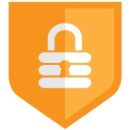
Location: Natick, Mass.
How it's using edtech: Examity's online proctoring services verify that students who take exams remotely do so honestly. The company offers a trio of tools to ensure test-taking integrity: digital identification, auto-proctoring and live proctoring. The digital identification process confirms identities through fingerprints and voice biometrics, among other methods. During auto-proctored exams, machine learning algorithms monitor students through the webcams and microphones on their personal computers and flags suspicious behavior. Security is even tighter in live-proctored exams during which test-takers are monitored by college-educated proctors who've completed two months of training on the workings of Examity's interface. Types of tests for which the company's platform can be used include standardized testing, college finals and certification exams. And there's 24/7 tech support via phone or online chat.

Location: New York City
How it's using edtech: Edtech isn't just for young people. In Thinkful's virtual classrooms, instructors train adults for new careers in full-stack programming and data analytics. Alumni of Thinkful's courses have landed jobs at tech giants like Google and Amazon, and the team has such faith in their program that students are promised a tuition refund if they can't find a job within six months of graduation. Central to Thinkful's approach is one-on-one mentorship. Each student receives focused, face-to-face attention via video chat from a professional in the field they're studying. When students leave Thinkful's bootcamp for the job market, the company also offers them six months of career services, including interview training.
Responses have been edited for length and clarity.
Recent Edtech Articles

- Become a Member
- Artificial Intelligence
- Computational Thinking
- Digital Citizenship
- Edtech Selection
- Global Collaborations
- STEAM in Education
- Teacher Preparation
- ISTE Certification
- School Partners
- Career Development
- ISTELive 24
- 2024 ASCD Annual Conference
- Solutions Summit
- Leadership Exchange
- 2024 ASCD Leadership Summit
- Edtech Product Database
- Solutions Network
- Sponsorship & Advertising
- Sponsorship & Advertising

Dream Big. Transform Teaching. Empower Learners.

Scale to new learning heights at the edtech event of the year. Over 1,000+ sessions provide something for every educator to impact every student.
ISTE U Courses ISTE U’s research-based courses put pedagogy first to help you transform your practice. The Summer courses are open for enrollment now through July 8. Enroll today! Learn More Learn More
ISTE Certification ISTE Certification focuses on pedagogy, not on apps or devices for all educators. This program challenges you to stretch yourself and be an expert among your colleagues. Learn More Learn More
Advancing Edtech Evaluation and Selection Discover reliable tools for evaluating and selecting quality edtech products, including the new Teacher Ready Evaluation Tool, ISTE Seal and the EdSurge Product Index. Learn More Learn More
The Trusted Standard
Focused on pedagogy, not tools, the ISTE Standards are a framework that guides educators in using technology to create high-impact, sustainable and scalable learning experiences for all students.
The ISTE Standards
Popular Topics
ISTE has a library of thousands of blog posts, podcasts, courses, books, journals, expert webinars and topic guides. Browse by topic or job role to find everything you need.
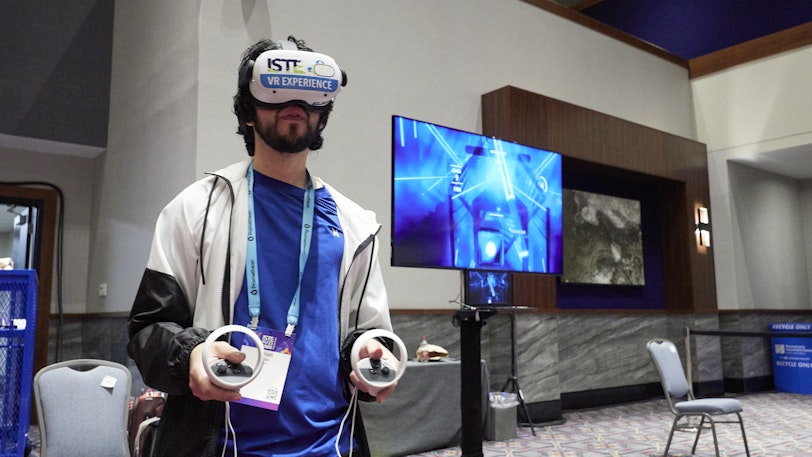
You want to attend ISTELive 24 , the edtech event of the year, but money is tight. Here are 6 ways to save money and fund your conference experience.
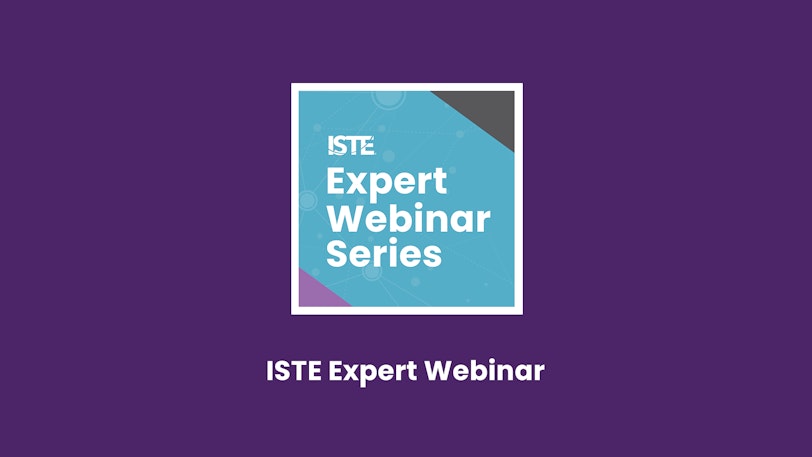
Find out how focusing on the “skills of learning” can make education more inclusive, equitable and empathetic – and prepare students for the future – with educator Jason Trinh.
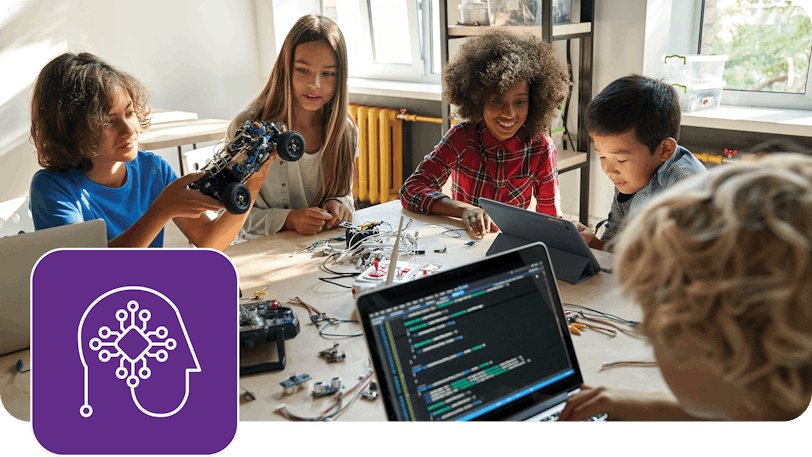
Artificial intelligence (AI) is no longer the stuff of the future; today's students can expect to interact with AI in both their personal and professional lives. To prepare students for success, educators need to understand how AI technologies can be leveraged to facilitate learning and solve real-world problems.
Create the Learning Tools of the Future
Edtech providers leverage ISTE’s expertise and network to develop, identify and scale quality learning solutions. From the Edtech Solutions Network to the Learning Technology Directory , we help solution providers find their people.

Year-Round Mission Sponsors
- artificial intelligence
Technology in Education: An Overview

- Share article
Technology is everywhere in education: Public schools in the United States now provide at least one computer for every five students. They spend more than $3 billion per year on digital content. Led by the federal government, the country is in the midst of a massive effort to make affordable high-speed Internet and free online teaching resources available to even the most rural and remote schools. And in 2015-16, for the first time, more state standardized tests for the elementary and middle grades will be administered via technology than by paper and pencil.
To keep up with what’s changing (and what isn’t), observers must know where to look.
There’s the booming ed-tech industry, with corporate titans and small startups alike vying for a slice of an $8 billion-plus yearly market for hardware and software. Much attention is also paid to the “early adopters”—those districts, schools, and teachers who are making the most ingenious and effective uses of the new tools at their disposal.
But a significant body of research has also made clear that most teachers have been slow to transform the ways they teach, despite the influx of new technology into their classrooms. There remains limited evidence to show that technology and online learning are improving learning outcomes for most students. And academics and parents alike have expressed concerns about digital distractions, ways in which unequal access to and use of technology might widen achievement gaps, and more.
State and federal lawmakers, meanwhile, have wrestled in recent years with the reality that new technologies also present new challenges. The rise of “big data,” for example, has led to new concerns about how schools can keep sensitive student information private and secure.
What follows is an overview of the big trends, opportunities, and concerns associated with classroom technology. Links to additional resources are included in each section for those who would like to dig deeper.
What Is Personalized Learning?
Many in the ed-tech field see new technologies as powerful tools to help schools meet the needs of ever-more-diverse student populations. The idea is that digital devices, software, and learning platforms offer a once-unimaginable array of options for tailoring education to each individual student’s academic strengths and weaknesses, interests and motivations, personal preferences, and optimal pace of learning.
In recent years, a group of organizations including the Bill & Melinda Gates Foundation, the Michael and Susan Dell Foundation, and EDUCAUSE have crafted a definition of “personalized learning” that rests on four pillars:
- Each student should have a “learner profile” that documents his or her strengths, weaknesses, preferences, and goals;
- Each student should pursue an individualized learning path that encourages him or her to set and manage personal academic goals;
- Students should follow a “competency-based progression” that focuses on their ability to demonstrate mastery of a topic, rather than seat time; and,
- Students’ learning environments should be flexible and structured in ways that support their individual goals.
How does technology support that vision?
In many schools, students are given district-owned computing devices or allowed to bring their own devices from home. The idea is that this allows for “24-7” learning at the time and location of the student’s choosing.
Learning management systems, student information systems, and other software are also used to distribute assignments, manage schedules and communications, and track student progress.
And educational software and applications have grown more “adaptive,” relying on technology and algorithms to determine not only what a student knows, but what his or her learning process is, and even his or her emotional state.
For all the technological progress, though, implementation remains a major challenge. Schools and educators across the country continue to wrestle with the changing role of teachers, how to balance flexible and “personalized” models with the state and federal accountability requirements they still must meet, and the deeper cultural challenge of changing educators’ long-standing habits and routines.
Despite the massive investments that many school systems are making, the evidence that digital personalized learning can improve student outcomes or narrow achievement gaps at scale remains scattered, at best.
Additional resources:
- Taking Stock of Personalized Learning (Education Week special report)
- A Working Definition of Personalized Learning
- Why Ed Tech Is Not Transforming How Teachers Teach
What Is 1-to-1 Computing?
Increasingly, schools are moving to provide students with their own laptop computer, netbook, or digital tablet. Schools purchased more than 23 million devices for classroom use in 2013 and 2014 alone. In recent years, iPads and then Chromebooks (inexpensive Web-based laptops) have emerged as the devices of choice for many schools.
Video: Creating a Digital Culture

The two biggest factors spurring the rise in 1-to-1 student computing have been new mandates that state standardized tests be delivered online and the widespread adoption of the Common Core State Standards.
Generally, the hope is that putting devices in the hands of students will help with some or all of the following goals:
- Allowing teachers and software to deliver more personalized content and lessons to students, while allowing students to learn at their own pace and ability level;
- Helping students to become technologically skilled and literate and thus better prepared for modern workplaces;
- Empowering students to do more complex and creative work by allowing them to use digital and online applications and tools;
- Improving the administration and management of schools and classrooms by making it easier to gather information on what students know and have done;
- Improving communications among students, teachers, and parents.
Despite the potential benefits, however, many districts have run into trouble when attempting to implement 1-to-1 computing initiatives. Paying for the devices can be a challenge, especially as the strategy of issuing long-term bonds for short-term technology purchases has come into question. Many districts have also run into problems with infrastructure (not enough bandwidth to support all students accessing the Internet at the same time) and deployment (poor planning in distributing and managing thousands of devices.)
The most significant problem for schools trying to go 1-to-1, though, has been a lack of educational vision. Without a clear picture of how teaching and learning is expected to change, experts say, going 1-to-1 often amounts to a “spray and pray” approach of distributing many devices and hoping for the best.
Some critics of educational technology also point to a recent study by the Organization for Economic Cooperation and Development, which found that countries where 15-year old students use computers most in the classroom scored the worst on international reading and math tests.
- Learn More About 1-to-1 Computing
- Hard Lessons Learned in Ambitious L.A. iPad Initiative
- Chromebooks Gaining Popularity in School Districts
What Is Blended Learning?
In its simplest terms, blended learning combines traditional, teacher-to-student lessons with technology-based instruction.
Many schools and districts use a “rotation” model, which is often viewed as an effective means of providing students with more personalized instruction and smaller group experiences. In some cases, saving money (through larger overall class sizes, for example) is also a goal. The basic premise involves students rotating between online and in-person stations for different parts of the day. There are many versions of this approach, however: Do students stay in the classroom or go to a computer lab?
Does online instruction cover core content, or is it primarily for remediation? Are all students doing the same thing online, or do different students have different software and learning experiences?
Video: At Blended Learning School, Students on Flexible Schedules

One big trend for schools involves trying to make sure that what happens online is connected with what happens during face-to-face interactions with teachers. That could involve giving teachers a say in selecting the software that students use, for example, or making a concerted effort to ensure online programs provide teachers with data that is useful in making timely instructional decisions.
Another trend involves boosting students’ access to the Internet outside of school. Robust blended learning programs involve “anytime, anywhere” access to learning content for students—a major challenge in many communities.
Perhaps the biggest hurdle confronting educators interested in blended learning, though, is the lack of a solid research base. As of now, there is still no definitive evidence that blended learning works (or doesn’t.) While some studies have found encouraging results with specific programs or under certain circumstances, the question of whether blended learning positively impacts student learning still has a mostly unsatisfactory answer: “It depends.”
- Blended Learning: Breaking Down Barriers (Education Week special report)
- Blended Learning Research: The 7 Studies You Need to Know
- Learn More About Blended Learning
What Is the Status of Tech Infrastructure and the E-Rate?
The promise of technology in the classroom is almost entirely dependent on reliable infrastructure. But in many parts of the country, schools still struggle to get affordable access to high-speed Internet and/or robust wireless connectivity.
A typical school district network involves multiple components. In 2014, the Federal Communications Commission established connectivity targets for some of the pieces:
- A connection to the broader Internet provided by an outside service provider to the district office (or another central district hub). Target: 100 megabits per second per 1,000 students in the short-term, and 1 Gigabit per second per 1,000 students in the long-term.
- A “Wide Area Network” that provides network connections between the district’s central hub and all of its campuses, office buildings, and other facilities. Target: Connections capable of delivering 10 Gigabits per second per 1,000 students.
- “Local Area Networks” that provide connections within a school, including the equipment necessary to provide Wi-Fi service inside classrooms. Target: The FCC recommended a survey to determine a suitable measure. Many school-technology advocates call for internal connections that support 1-to-1 computing.
To support schools (and libraries) in building and paying for these networks, the FCC in 1996 established a program known as the E-rate. Fees on consumers’ phone bills fund the program, which has paid out more than $30 billion since its inception.
In 2014, the commission overhauled the E-rate, raising the program’s annual spending cap from $2.4 billion to $3.9 billion and prioritizing support for broadband service and wireless networks. The changes were already being felt as of Fall 2015; after steadily declining for years, the number of schools and libraries applying for E-rate funds for wireless network equipment skyrocketed, with nearly all of the applicants expected to receive a portion of the $1.6 billion in overall wireless-related requests.

As part of the E-rate overhaul, the FCC also approved a series of regulatory changes aimed at leveling the playing field for rural and remote schools, which often face two big struggles: accessing the fiber-optic cables that experts say are essential to meeting the FCC’s long-term goals, and finding affordable rates.
Infrastructure in some contexts can also be taken to include learning devices, digital content, and the policies and guidelines that govern how they are expected to be used in schools (such as “responsible use policies” and “digital citizenship” programs aimed to ensure that students and staff are using technology appropriately and in support of learning goals.)
Another big—and often overlooked—aspect of infrastructure is what’s known as interoperability. Essentially, the term refers to common standards and protocols for formatting and handling data so that information can be shared between software programs. A number of frameworks outline data interoperability standards for different purposes. Many hope to see the field settle on common standards in the coming years.
Additional Resources:
- The Typical School Network (EducationSuperHighway)
- The E-rate Overhaul in 4 Easy Charts
- Reversing a Raw Deal: Rural Schools Still Struggle to Access Affordable High Speed Internet (Education Week special series)
How Is Online Testing Evolving?
The biggest development on this front has been states’ adoption of online exams aligned with the Common Core State Standards. During the 2014-15 school year, 10 states (plus the District of Columbia) used exams from the Partnership for Assessment of Readiness for College and Careers (PARCC), and 18 states used exams from the Smarter Balanced Assessment Consortium, all of which were delivered primarily online. Many of the other states also used online assessments.
The 2015-16 school year will be the first in which more state-required summative assessments in U.S. middle and elementary schools will be delivered via technology rather than paper and pencil, according to a recent analysis by EdTech Strategies, an educational technology consulting firm.
Beyond meeting legislative mandates, perceived benefits include cost savings, ease of administration and analysis, and the potential to employ complex performance tasks.
But some states—including Florida, Minnesota, Montana, and Wisconsin—have experienced big problems with online tests, ranging from cyber attacks to log-in problems to technical errors. And there is growing evidence that students who take the paper-and-pencil version of some important tests perform better than peers who take the same exams online, at least in the short term.
Nevertheless, it appears likely that online testing will continue to grow—and not just for state summative assessments. The U.S. Department of Education, for example, is among those pushing for a greater use of technologically enhanced formative assessments that can be used to diagnose students’ abilities in close to real time. In the department’s 2016 National Education Technology Plan, for example, it calls for states and districts to “design, develop, and implement learning dashboards, response systems, and communication pathways that give students, educators, families, and other stakeholders timely and actionable feedback about student learning to improve achievement and instructional practices.”
- PARCC Scores Lower for Students Who Took Exams on Computers
- Map: The National K-12 Testing Landscape
- Pencils Down: The Shift to Online and Computer-Based Testing (EdTech Strategies)
- Online Testing Glitches Causing Distrust in Technology
- U.S. Ed-Tech Plan Calls Attention to ‘Digital-Use Divide’
How Are Digital Materials Used in Classrooms?
Digital instructional content is the largest slice of the (non-hardware) K-12 educational technology market, with annual sales of more then $3 billion. That includes digital lessons in math, English/language arts, and science, as well as “specialty” subjects such as business and fine arts. The market is still dominated by giant publishers such as Houghton Mifflin Harcourt and Pearson, who have been scrambling to transition from their print-centric legacy products to more digital offerings.
But newcomers with one-off products or specific areas of expertise have made inroads, and some apps and online services have also gained huge traction inside of schools.
As a result, many schools use a mix of digital resources, touting potential benefits such as greater ability to personalize, higher engagement among students, enhanced ability to keep content updated and current, and greater interactivity and adaptivity (or responsiveness to individual learners).
Still, though, the transition to digital instructional materials is happening slowly, for reasons that range from the financial (for districts that haven’t been able to purchase devices for all students, for example) to the technical (districts that lack the infrastructure to support every student being online together.) Print still accounts for about 70 percent of pre-K-12 instructional materials sales in the United States.
- Learn More About Digital Curriculum
- Digital Content Providers Ride Wave of Rising Revenues
- K-12 Print Needs Persist Despite Digital Growth
What Are Open Educational Resources?
Rather than buying digital instructional content, some states and districts prefer using “open” digital education resources that are licensed in such a way that they can be freely used, revised, and shared. The trend appears likely to accelerate: The U.S. Department of Education, for example, is now formally encouraging districts to move away from textbooks and towards greater adoption of OER.

New York and Utah have led the way in developing open educational resources and encouraging their use by schools. The K-12 OER Collaborative, which includes 12 states and several nonprofit organizations, is working to develop OER materials as well.
Proponents argue that OER offer greater bang for the buck, while also giving students better access to a wider array of digital materials and teachers more flexibility to customize instructional content for individual classrooms and students. Some also believe OER use encourages collaboration among teachers. Concerns from industry and others generally focus on the quality of open materials, as well as the challenges that educators face in sifting through voluminous one-off resources to find the right material for every lesson.
- What is OER? (Creative Commons)
- Districts Put Open Educational Resources to Work
- Calculating the Return on Open Educational Resources
How Are Virtual Education and Distance Learning Doing?
One technology trend that has come under increasing scrutiny involves full-time online schools, particularly cyber charters. About 200,000 students are enrolled in about 200 publicly funded, independently managed online charter schools across 26 states.
But such schools were found to have an “overwhelming negative impact” on student learning in a comprehensive set of studies released in 2015 by a group of research organizations, including Stanford University’s Center for Research on Education Outcomes at Stanford University.
That research did not cover the more than two dozen full-time online schools that are state-run, however, nor did it cover the dozens more that are run by individual school districts. Thousands upon thousands of students who are enrolled in traditional brick-and-mortar schools also take individual courses online. Five states—Alabama, Arkansas, Florida, Michigan, and Virginia—now require students to have some online learning to graduate. Other states, such as Utah, have passed laws encouraging such options for students.
For many students, especially those in rural and remote areas, online and distance learning can offer access to courses, subjects, and teachers they might otherwise never be able to find. Such opportunities can also benefit advanced and highly motivated students and those with unusual schedules and travel requirements, and be a useful tool to keep schools running during snow days.
But so far, achieving positive academic outcomes at scale via online learning has proven difficult, and many observers have expressed concerns about the lack of accountability in the sector, especially as relates to for-profit managers of online options.
- Learn More About Remote/Virtual Learning
- Cyber Charters Have ‘Overwhelming Negative Impact’
Education Issues, Explained
How to Cite This Article Herold, B. (2016, February 5). Technology in Education An Overview. Education Week. Retrieved Month Day, Year from https://www.edweek.org/technology/technology-in-education-an-overview/2016/02
Sign Up for EdWeek Tech Leader
Edweek top school jobs.

Sign Up & Sign In

How Important Is Technology in Education? Benefits, Challenges, and Impact on Students
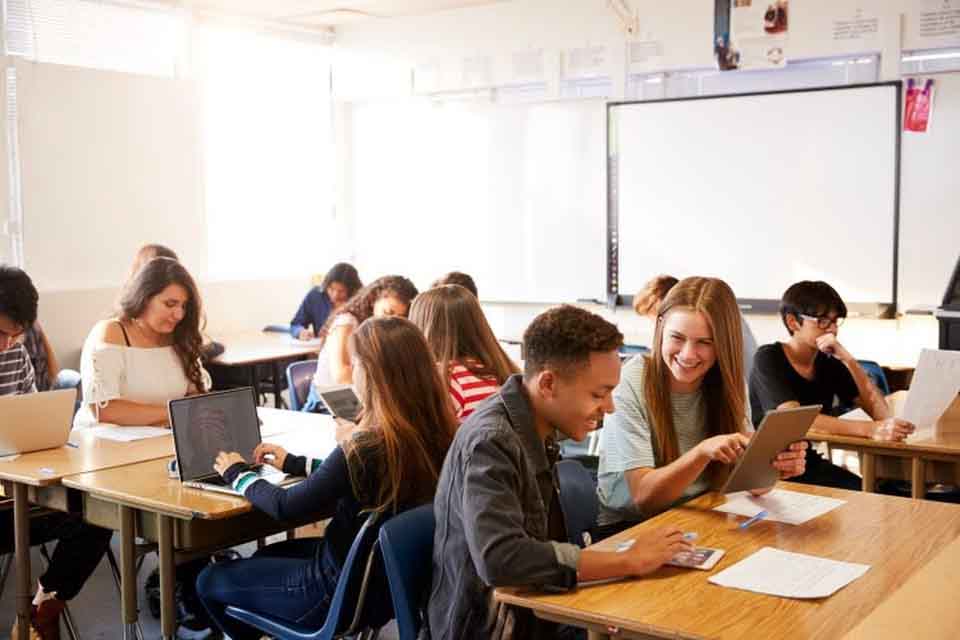
Many of today’s high-demand jobs were created in the last decade, according to the International Society for Technology in Education (ISTE). As advances in technology drive globalization and digital transformation, teachers can help students acquire the necessary skills to succeed in the careers of the future.
How important is technology in education? The COVID-19 pandemic is quickly demonstrating why online education should be a vital part of teaching and learning. By integrating technology into existing curricula, as opposed to using it solely as a crisis-management tool, teachers can harness online learning as a powerful educational tool.
The effective use of digital learning tools in classrooms can increase student engagement, help teachers improve their lesson plans, and facilitate personalized learning. It also helps students build essential 21st-century skills.
Virtual classrooms, video, augmented reality (AR), robots, and other technology tools can not only make class more lively, they can also create more inclusive learning environments that foster collaboration and inquisitiveness and enable teachers to collect data on student performance.
Still, it’s important to note that technology is a tool used in education and not an end in itself. The promise of educational technology lies in what educators do with it and how it is used to best support their students’ needs.
Educational Technology Challenges
BuiltIn reports that 92 percent of teachers understand the impact of technology in education. According to Project Tomorrow, 59 percent of middle school students say digital educational tools have helped them with their grades and test scores. These tools have become so popular that the educational technology market is projected to expand to $342 billion by 2025, according to the World Economic Forum.
However, educational technology has its challenges, particularly when it comes to implementation and use. For example, despite growing interest in the use of AR, artificial intelligence, and other emerging technology, less than 10 percent of schools report having these tools in their classrooms, according to Project Tomorrow. Additional concerns include excessive screen time, the effectiveness of teachers using the technology, and worries about technology equity.
Prominently rising from the COVID-19 crisis is the issue of content. Educators need to be able to develop and weigh in on online educational content, especially to encourage students to consider a topic from different perspectives. The urgent actions taken during this crisis did not provide sufficient time for this. Access is an added concern — for example, not every school district has resources to provide students with a laptop, and internet connectivity can be unreliable in homes.
Additionally, while some students thrive in online education settings, others lag for various factors, including support resources. For example, a student who already struggled in face-to-face environments may struggle even more in the current situation. These students may have relied on resources that they no longer have in their homes.
Still, most students typically demonstrate confidence in using online education when they have the resources, as studies have suggested. However, online education may pose challenges for teachers, especially in places where it has not been the norm.
Despite the challenges and concerns, it’s important to note the benefits of technology in education, including increased collaboration and communication, improved quality of education, and engaging lessons that help spark imagination and a search for knowledge in students.
The Benefits of Technology in Education
Teachers want to improve student performance, and technology can help them accomplish this aim. To mitigate the challenges, administrators should help teachers gain the competencies needed to enhance learning for students through technology. Additionally, technology in the classroom should make teachers’ jobs easier without adding extra time to their day.
Technology provides students with easy-to-access information, accelerated learning, and fun opportunities to practice what they learn. It enables students to explore new subjects and deepen their understanding of difficult concepts, particularly in STEM. Through the use of technology inside and outside the classroom, students can gain 21st-century technical skills necessary for future occupations.
Still, children learn more effectively with direction. The World Economic Forum reports that while technology can help young students learn and acquire knowledge through play, for example, evidence suggests that learning is more effective through guidance from an adult, such as a teacher.
Leaders and administrators should take stock of where their faculty are in terms of their understanding of online spaces. From lessons learned during this disruptive time, they can implement solutions now for the future. For example, administrators could give teachers a week or two to think carefully about how to teach courses not previously online. In addition to an exploration of solutions, flexibility during these trying times is of paramount importance.
Below are examples of how important technology is in education and the benefits it offers to students and teachers.
Increased Collaboration and Communication
Educational technology can foster collaboration. Not only can teachers engage with students during lessons, but students can also communicate with each other. Through online lessons and learning games, students get to work together to solve problems. In collaborative activities, students can share their thoughts and ideas and support each other. At the same time, technology enables one-on-one interaction with teachers. Students can ask classroom-related questions and seek additional help on difficult-to-understand subject matter. At home, students can upload their homework, and teachers can access and view completed assignments using their laptops.
Personalized Learning Opportunities
Technology allows 24/7 access to educational resources. Classes can take place entirely online via the use of a laptop or mobile device. Hybrid versions of learning combine the use of technology from anywhere with regular in-person classroom sessions. In both scenarios, the use of technology to tailor learning plans for each student is possible. Teachers can create lessons based on student interests and strengths. An added benefit is that students can learn at their own pace. When they need to review class material to get a better understanding of essential concepts, students can review videos in the lesson plan. The data generated through these online activities enable teachers to see which students struggled with certain subjects and offer additional assistance and support.
Curiosity Driven by Engaging Content
Through engaging and educational content, teachers can spark inquisitiveness in children and boost their curiosity, which research says has ties to academic success. Curiosity helps students get a better understanding of math and reading concepts. Creating engaging content can involve the use of AR, videos, or podcasts. For example, when submitting assignments, students can include videos or interact with students from across the globe.
Improved Teacher Productivity and Efficiency
Teachers can leverage technology to achieve new levels of productivity, implement useful digital tools to expand learning opportunities for students, and increase student support and engagement. It also enables teachers to improve their instruction methods and personalize learning. Schools can benefit from technology by reducing the costs of physical instructional materials, enhancing educational program efficiency, and making the best use of teacher time.
Become a Leader in Enriching Classrooms through Technology
Educators unfamiliar with some of the technology used in education may not have been exposed to the tools as they prepared for their careers or as part of their professional development. Teachers looking to make the transition and acquire the skills to incorporate technology in education can take advantage of learning opportunities to advance their competencies. For individuals looking to help transform the education system through technology, American University’s School of Education online offers a Master of Arts in Teaching and a Master of Arts in Education Policy and Leadership to prepare educators with essential tools to become leaders. Courses such as Education Program and Policy Implementation and Teaching Science in Elementary School equip graduate students with critical competencies to incorporate technology into educational settings effectively.
Learn more about American University’s School of Education online and its master’s degree programs.
Virtual Reality in Education: Benefits, Tools, and Resources
Data-Driven Decision Making in Education: 11 Tips for Teachers & Administration
Helping Girls Succeed in STEM
BuiltIn, “Edtech 101”
EdTech, “Teaching Teachers to Put Tech Tools to Work”
International Society for Technology in Education, “Preparing Students for Jobs That Don’t Exist”
The Journal, “How Teachers Use Technology to Enrich Learning Experiences”
Pediatric Research, “Early Childhood Curiosity and Kindergarten Reading and Math Academic Achievement”
Project Tomorrow, “Digital Learning: Peril or Promise for Our K-12 Students”
World Economic Forum, “The Future of Jobs Report 2018”
World Economic Forum, “Learning through Play: How Schools Can Educate Students through Technology”
Request Information
11 Most Important Education Trends for 2024 and Beyond

Turn your texts, PPTs, PDFs or URLs to video - in minutes.

American academic Allan Bloom said, "Education is the movement from darkness to light."
In 2024, educators are seeing that movement accelerate at lightspeed, fueled by ever-evolving technology. In this blog post, we look at the biggest education trends and the technology that makes them possible. From artificial intelligence to AR and big data learning analytics, we dissect the current trends in education with insights from expert professionals, world forums, and industry reports. Read on to see how these emerging trends find their place anywhere, from smartphones to smart classrooms.
Education trend 1: Artificial intelligence
Far more than just another "cool" trend in the education sector, AI is a life-changer — especially for kids in remote areas, poorer schools, or with learning disabilities.
Even large-scale organizations like UNICEF are using AI tools to help deliver high-quality education to students everywhere. Advanced AI algorithms and machine learning models can:
- Personalize learning plans so everyone is always challenged at the right level.
- Free teachers from grading and paperwork, giving them more time to focus on students individually.
A critical aspect to digital learning is internet access. That's why innovations like Starlink could revolutionize connectivity and mobile education in developing countries.
AI strategies are also being tested and implemented at the world's top schools, colleges, and universities. Some faculty members clone themselves to create video lectures in minutes. Others teach through innovative videos where they interact with AI avatars (digital doubles of real actors) that play the student's role:
As educational technologies improve and educational trends evolve, experts and big organizations are excited about how artificial intelligence can transform education.
The World Economic Forum analyzed AI's impact on education in its latest report in 2024, " Shaping the Future of Learning: The Role of AI in Education 4.0. "
The impact of AI on education:
- Tailors the educational content and pacing to individual student needs.
- Allows teachers to devote more time to teaching and student interaction.
- Improves access to education for students with disabilities and language barriers.
Education trend 2: Interactivity
Education through interactivity uses quizzes, simulations, and collaborative projects in online learning environments. An online platform with interactive videos , particularly one with built-in quizzes that provide real-time, instant feedback, is super-effective and makes learning more dynamic.
Interactivity typically tests and redirects, adapting the learning path on the spot. Students don't need to wait for a teacher to grade them, so they can go through materials at their own pace and accelerate learning.
In a recent conversation with Michael Milken, Chairman of the Milken Institute, Elon Musk said that children don't need a teacher in front of a board. Instead, he advocated for compelling, interactive learning experiences that truly engage and help them learn actively:
The impact of interactivity on education:
- Allows students to participate in their learning process actively.
- Encourages collaboration and communication.
- Interactive videos make lessons more adaptive and personalized.
Education trend 3: Gamification
As every kindergarten teacher knows, games have always been used to teach. Today, they're particularly effective because kids are so much more exposed to dopamine hits while playing games on their parent's devices. On a biological level, dopamine shapes learning and is an excellent way to improve the effectiveness of learning programs.
Students demand more interactive and gamified education. By 2026, the game-based learning global market will hit a compound annual growth rate of 21.9% and reach a revenue of $29.7 billion.
Gamified teaching strategies apply game-design elements and principles in educational contexts. Like any game, they boost motivation using points, badges, leaderboards, and challenges — all the things that typically get you hooked when playing digital games.
In a recent Stanford report on "How technology is reinventing education," Dan Schwartz, dean of Stanford Graduate School of Education and professor of educational technology, said gamification tries to make " chocolate-covered broccoli. " In other words, it uses art and rewards to add some fun to speeded-response tasks with single-answer, factual questions.
Impact of gamification on education:
- Increases student motivation and engagement.
- Subtly encourages continuous learning and improvement.
- Promotes healthy competition among students.
Education trend 4: Mobile learning
In 2024, 60.67% of website traffic is mobile, and the overwhelming majority of internet users (92.3%) will consider going online through their smartphones instead of other devices.
Mobile learning, or m-learning, refers to using smartphones, tablets, and laptops to access learning resources and environments anywhere and anytime. It's highly attractive for everyone, from kids with smartphones to grown-ups chugging away at corporate training on the go.
Impact of mobile learning on education:
- Allows students to learn from anywhere.
- Facilitates just-in-time learning.
- Encourages a more personalized learning experience.
Education trend 5: Adaptive learning
Adaptive learning uses technology, often integrated with learning management systems, to customize each student's learning experience. It tracks student progress and adjusts what they learn next, keeping things challenging and effective.
In workplace training for non-negotiable skills such as compliance training and health and safety certification, adaptive learning is used to ensure comprehension and skill acquisition.
According to the Adaptive Learning Industry Report 2024-2030, the top three biggest adopters of adaptive learning are K-12, Higher Education, and Corporate institutions.
Impact of adaptive learning on education:
- Makes learning more fun by tweaking the difficulty and type of content.
- Welcomes all kinds of learners, making sure they get material that fits just right.
- Boosts memory and reduces stress by giving quick feedback and help.
Education trend 6: Digital citizenship soft skills
The internet is a giant playground, but it can be dangerous to navigate without proper skills. Digital citizenship teaches internet users how to manage their digital footprints, respect intellectual property, spot credible content from fake news, and even interact nicely in online communities.
This shift requires schools and institutions to prioritize digital literacy in their curriculums. These soft skills prepare students to be informed, responsible, and awesome digital citizens.
On Feb 13, 2023, the Digital Citizenship and Media Literacy Act was introduced in the Senate.
Richard Culatta, CEO of ISTE and ASCD and internationally recognized learning designer, says , " Digital citizenship is about far more than just helping kids be safe online; it's about empowering them to use technology to solve real-world problems, to know how to balance their time between a variety of online and offline activities, to be curious learners and to use digital tools to deepen their relationships with their family and friends. "
Impact of digital citizenship skills on education:
- Promote safe and responsible use of tech inside and outside of educational institutions.
- Improve critical thinking and discernment.
- Prep students for the digital economy and online learning.
Education trend 7: Augmented reality
Augmented reality overlays digital information in the real world, making the learning environment more interactive and immersive. Students can see and interact with 3D models and simulations that pop into their physical surroundings using devices like smartphones, tablets, or AR glasses.
The latest advancements in this technology make AR experiences even more accessible and engaging for students. Check out this video by Lestute on how AR can be used in education:
The more this tech evolves, the bigger its impact will be, especially in the medical and engineering fields — imagine if instructors could teach someone the steps to dismantling a bomb using AR.
But AR might as well work for language learning — a student studying Spanish can point their AR device at a chair, and the Spanish word "silla" will appear along with pronunciation guides and usage examples. This immediate, context-based learning helps with faster, more intuitive language acquisition.
Impact of AR on education:
- Transforms traditional teaching methods into interactive, 3D experiences.
- Encourages experiential learning.
- Breaks down geographical and physical barriers in education.
Education trend 8: Blended learning
This type of learning mixes learning online with spending time in a traditional classroom. Teachers and students meet in person, but students also have some freedom to decide when, where, and how they want to learn.
This approach helps foster conversations between students and teachers, both in person and online. Equally important, it offers students greater flexibility, allowing them to balance their studies with other commitments more effectively.
For instance, consider a university biology class where the professor combines classic face-to-face teaching with online videos and virtual labs. Students can dive into interactive content at their own pace, try out virtual experiments, and chat in online forums.
Even though some learning happens online, the blended formula keeps education engaging and teachers central. It even fosters a sense of belonging, as you can discover from this insightful TEDx talk:
Impact of blended learning on education:
- Offers flexibility in how and when students learn, accommodating different learning styles and schedules.
- Enhances student autonomy and responsibility in managing their learning.
- Provides more opportunities for interactive and engaging education.
Education trend 9: Experiential learning
Experiential learning requires institutions to facilitate internships, workshops, and simulations where students are fully involved and solve real problems. It's hands-on and interactive and helps develop practical and soft skills for future careers, including crucial leadership skills.
Experiential learning leads students to pick up practical knowledge and make tough decisions in their real jobs later on. The stakes are high, especially as children become absorbed by technology, and educators must shift them from just consuming online content to doing something actively.
Adrienne Alexander, an educational revolutionary, has some powerful thoughts on " The education revolution we need to have: "
Impact of experiential learning on education:
- Deepens understanding by engaging students in practical situations.
- Develops critical life skills like problem-solving, teamwork, and decision-making.
- Prepares students for professional careers with relevant, hands-on experience.
Education trend 10: STEAM education
Expanding on the traditional STEM curriculum (Science, Technology, Engineering, and Mathematics), STEAM incorporates Art. So, it promotes creative and innovative thinking and encourages students to approach challenges from multiple perspectives that create innovative solutions.
While AI and digital citizenship skills are great, creativity is now the predictor of success. Being able to think differently is more important than ever, which is why STEAM education is so powerful and will only continue to grow in importance:
Impact of STEAM on education:
- Promotes well-rounded intellectual development.
- Enhances innovation and creativity.
- Prepares students for a diverse range of career paths.
Education trend 11: Big data learning analytics
Here, we have two education trends in one: big data will get bigger, and learning analytics will be a powerful tool. Schools are using big data learning analytics to understand students better. This understanding enables them to adopt data-driven strategies for learning optimization in the classroom and online.
Teachers and educators rely on AI to collect, analyze, and report large volumes of data about learners and their contexts. Then, they identify patterns and insights that help them design courses, decide on policies, and offer individual student support.
As documented in various research papers, like this one from the Journal of Asynchronous Learning Network, analytics are critical and effective in higher education.
Impact of big data learning analytics on education:
- Enhances decision-making in educational programs.
- Supports personalized learning and interventions.
- Enables continuous monitoring and adjustment of teaching methods.
Supercharge your education program with engaging AI videos
Video can bring complex concepts to life like no other tool. It's incredibly effective at attracting learners and making information stick.
In 2024 and beyond, creating videos for hard and soft skills training or really any type of educational content will be easier than ever, thanks to generative AI. With Gen AI, one can turn plain text into video content in minutes.
Try this free AI video generator and discover the endless ways you can use videos to enhance learning and keep up with the emerging trends in education.

You might also like

How to Make Video Lectures Without Cameras
Learn how to create engaging and informative video lectures without the use of a camera in this comprehensive guide.

10 Best Video Lecture Software You Can Find in 2024
Want to create video lectures, but not sure where to start? Compare these 10 video lecture software to choose the right one. Pros, cons, pricing included.

8 AI Trends To Look Out For in 2024
Discover the top AI trends shaping 2024 and beyond. Personalization, democratization, generative AI, digital twinning, and more →

25 Operational Excellence Examples for Peak Business Performance
Discover 25 operational excellence examples for peak business performance, including continuous improvement and lean manufacturing.
Discover the top 11 education trends for 2024 & beyond, including AI personalization, gamification, AR experiences, & more. Stay ahead with the latest trends!

6 Must-Know Sales Enablement Trends & Stats for 2024
Discover the latest AI-powered sales enablement trends & stats for 2024. Elevate your sales strategy with insights on sales enablement trends.
Billions are spent on educational technology, but we don't know if it works
D uring the COVID lockdowns, schools and universities worldwide relied on education technology—edtech—to keep students learning. They used online platforms to give lessons, mark work and send feedback, used apps to teach and introduced students to programs that let them work together on projects.
In the aftermath of school closures, the market for edtech has kept on growing. The value of the sector is projected to rise to US$132.4 billion globally by 2032 .
The problem is that we don't know very much about how effective many edtech apps or programs are—or if they are effective at all .
And some effects may be negative. Some of the so-called educational apps advertised to families show many adverts to children. They may use manipulative features to keep children on screens without teaching them anything new.
This technology is here to stay and will remain a significant part of how children learn—so knowing whether it works is imperative.
Assessing and addressing the quality of edtech is a significant task, especially when it is already so widely used. For edtech under development, a valuable option is to foster closer collaboration between tech developers and scientists who study learning to embed existing research and knowledge into the design.
Research consultancy firms can carry out swift assessments to provide edtech developers with information on how well what they are offering works. Transparency and integrity in the research process is vital, though, to prevent bias. Ways of ensuring this include pre-registration : reporting that a study is going to take place before it happens.
Partnerships with schools could also provide valuable feedback . However, minimum standards of quality and ethical considerations would need to be assured before technologies are sent to schools.
Setting a standard
When it comes to edtech that is already available, what is really needed is some kind of standardized metric to assess how well it works.
But establishing minimum standards for the effect of edtech is easier said than done. There is, historically, a lack of standardized metrics for assessing educational impact within impact economics —the study of how businesses create financial returns while ensuring positive social or environmental outcomes.
Without standardization, there are too many ways to assess edtech. A review commissioned by the UK government of evaluation criteria and standards for edtech analyzed 74 methods for assessing their quality.
Similarly, I carried out a research study with colleagues on available criteria to assess the effectiveness and efficacy of edtech produced specifically for schools. We found 65 different frameworks for evaluating whether these school-specific offerings work.
The abundance of evaluation possibilities can be confusing for edtech businesses. The multitude of options makes it difficult to ascertain the quality of their products. It is confusing to investors too, especially those who want to prioritize not only edtech's return on investment but also a return on education and community.
A yardstick that establishes the minimum quality requirements for a edtech product to be used in schools is crucial to ensure technology does more good and no harm. The creation of a yardstick needs to take into account both the product quality and the process of using the technology— whether it works for diverse populations and diverse learning environments.
The independent verification of evidence is vital , considering that any company can simply "generate" a study with the data they daily collect on users. In my research work with colleagues, I have argued for a focus on the rigor and validity of various research types.
New initiatives, such as the International Certification of Evidence of Impact in Education , have begun to consolidate the different research approaches, standards and certifications related to evidence of edtech impact globally. Ultimately, the goal is to make it easier for schools and parents to navigate the thousands of educational apps and online platforms available.
Whether individual countries will create the legal and institutional frameworks to enforce any of the standards remains to be seen. Countries will need to select standards that suit both their economic and educational agendas. An important shift is needed so that schools can strategically select edtech they know will help children's learning.
This article is republished from The Conversation under a Creative Commons license. Read the original article .
Provided by The Conversation


The Impact of Technology on Modern Teaching
Ai generator.
Technology has profoundly transformed the landscape of education, altering teaching methods, learning experiences, and the overall classroom environment. While it brings numerous benefits, it also presents certain challenges. Understanding these aspects can help teachers effectively integrate technology into their classrooms to enhance learning outcomes.
How Technology Has Transformed Teaching Methods
Interactive Learning
- Digital Tools : The use of interactive whiteboards, educational apps, and online resources allows teachers to create dynamic and engaging lessons. These tools can make complex subjects more understandable and enjoyable.
- Gamification : Incorporating game elements into learning activities, such as quizzes and educational games, can motivate students and make learning fun.
Personalized Learning
- Adaptive Learning Software : Technology enables personalized learning experiences through adaptive software that adjusts to each student’s learning pace and style, providing customized feedback and resources.
- Individualized Instruction : Teachers can use technology to track student progress and tailor instruction to meet individual needs, ensuring that each student receives the support they need to succeed.
Collaborative Learning
- Online Collaboration : Platforms like Google Classroom, Microsoft Teams, and various educational forums facilitate collaboration among students. They can work on group projects, share resources, and provide peer feedback.
- Global Connections : Technology allows students to connect with peers around the world, broadening their perspectives and enhancing their understanding of global issues.
Access to Information
- Digital Libraries : Students and teachers have access to a vast array of online resources, including digital libraries, research databases, and educational websites, which can enrich the learning experience.
- E-books and Online Courses : E-books and online courses provide additional learning materials and opportunities for students to explore subjects in greater depth.
Benefits of Technology in Education
Enhanced Engagement
- Technology can make learning more engaging through multimedia content, interactive activities, and real-time feedback.
Flexibility and Accessibility
- Online learning platforms and digital resources allow students to learn at their own pace and on their own schedule, making education more accessible.
Improved Collaboration
- Technology facilitates collaboration among students, teachers, and even parents, fostering a more connected and supportive learning community.
Real-World Skills
- By using technology, students develop essential 21st-century skills such as digital literacy, problem-solving, and critical thinking, which are crucial for their future careers.
Challenges of Integrating Technology
Digital Divide
- Access to Technology : Not all students have equal access to technology and the internet, creating disparities in learning opportunities.
- Training and Support : Teachers may need additional training and support to effectively use new technologies in their classrooms.
Distraction and Misuse
- Distractions : The presence of devices in the classroom can lead to distractions if not managed properly.
- Cybersecurity : Ensuring the safety and security of students online is a significant concern, requiring measures to protect against cyberbullying and data breaches.
Technical Issues
- Reliability : Technical issues such as software glitches, connectivity problems, and hardware malfunctions can disrupt the learning process.
- Maintenance : Schools need to invest in the maintenance and updating of technological tools and infrastructure.
Strategies for Effectively Integrating Technology
Professional Development
- Training Programs : Schools should provide ongoing professional development opportunities for teachers to learn how to use new technologies effectively.
- Peer Learning : Encourage teachers to share best practices and collaborate on integrating technology into their lessons.
Blended Learning
- Combining Methods : Use a mix of traditional and technological teaching methods to cater to different learning styles and ensure a balanced approach.
- Flipped Classroom : Implement the flipped classroom model, where students engage with new content at home through videos and online resources, and apply their knowledge in the classroom through interactive activities.
Student-Centered Approach
- Active Learning : Design activities that promote active learning, such as problem-solving tasks, interactive simulations, and collaborative projects.
- Feedback and Assessment : Utilize technology to provide timely and personalized feedback, and use digital tools for formative and summative assessments.
Ensuring Equity
- Access Initiatives : Implement initiatives to ensure all students have access to necessary technology, such as providing devices or creating community access points.
- Inclusive Design : Use technology to support diverse learners by incorporating features like text-to-speech, translation tools, and customizable learning interfaces.
Managing Distractions
- Clear Guidelines : Establish clear guidelines for the appropriate use of technology in the classroom.
- Engaging Content : Keep students engaged with interactive and relevant content that minimizes the temptation to get distracted.
Technology has the potential to greatly enhance teaching and learning by making education more interactive, personalized, and accessible. However, its successful integration requires addressing challenges such as the digital divide, training needs, and potential distractions. By adopting effective strategies and remaining adaptable, teachers can leverage technology to create enriching and impactful educational experiences for their students. As technology continues to evolve, so too will the opportunities for innovation and improvement in the field of education.
Text prompt
- Instructive
- Professional
10 Examples of Public speaking
20 Examples of Gas lighting
- Skip to primary navigation
- Skip to main content
- Skip to primary sidebar
- Skip to footer
Don't Miss a Post! Subscribe
- Guest Posts

- Educational AI
- Edtech Tools
- Edtech Apps
- Teacher Resources
- Special Education
- Edtech for Kids
- Buying Guides for Teachers

Educators Technology
Innovative EdTech for teachers, educators, parents, and students
Teacher Resignation Letter Examples
By Med Kharbach, PhD | Last Update: May 25, 2024
As teachers and educators, many of us will, at some point in our careers, need to resign from our positions for various reasons. This post covers the essentials of writing a teacher resignation letter, including its purpose, key elements, and practical tips for ensuring a smooth and professional transition. You’ll find examples to illustrate different scenarios and customizable templates to help you draft your letter effectively. Download our free templates to make the process easier and ensure a respectful departure from your role.
What Is a Teacher Resignation Letter?
A teacher resignation letter is a formal document that a teacher submits to their school administration to announce their intention to leave their teaching position. Its primary purposes are to officially notify the administration of the teacher’s decision, provide a written record for the personnel file, and facilitate the transition planning by specifying the last working day. Additionally, it serves as a professional courtesy to maintain a positive relationship with the administration by expressing gratitude and offering to assist in the transition process. This ensures a smooth and professional exit from the position.
Tips for Writing A Teacher Resignation Letter
Writing a resignation letter as a teacher requires attention to detail, professionalism, and a positive tone. Here are some tips to help you craft an effective resignation letter:
- Header : Include your name, address, phone number, email address, and the current date.
- Salutation : Address the letter to your principal or supervisor.
- Opening Paragraph : Clearly state your intent to resign and include your last working day.
- Express Gratitude : Thank the administration and colleagues for their support and the opportunities provided.
- Transition Plan : Offer to help with the transition, such as training your replacement or preparing transition materials.
- Student Consideration : Highlight your commitment to ensuring minimal disruption to your students’ learning experience.
- Professional Development : Mention any ongoing professional development or mentorship you are willing to provide post-resignation.
- Exit Interview : Request an exit interview to discuss your experiences and offer constructive feedback.
- Be Concise : Keep the letter short and to the point.
- Professional Tone : Maintain a positive and professional tone throughout.
- Review Policies : Check your school’s policies on resignation to ensure compliance.
Dos and Don’ts of Writing a Teacher Resignation Letter
When writing a teacher resignation letter, it’s important to follow certain guidelines to ensure a smooth and professional transition. This letter not only serves as a formal notification of your departure but also helps maintain a positive relationship with your school administration. Here are some key dos and don’ts to consider when drafting your resignation letter:
- Be Clear and Concise : Clearly state your intention to resign and your last working day.
- Express Gratitude : Thank the administration and colleagues for their support and opportunities.
- Offer Transition Assistance : Mention your willingness to help with the transition, such as training your replacement.
- Be Professional : Maintain a positive and professional tone throughout.
- Include Contact Information : Provide your contact details for any follow-up.
Don’ts:
- Vent Frustrations : Avoid expressing negative feelings or grievances.
- Be Vague : Don’t leave any ambiguity about your resignation date.
- Skip the Formalities : Ensure the letter is formatted correctly with proper salutation and closing.
- Procrastinate : Submit your resignation letter with sufficient notice as per your contract.
- Forget the Exit Interview : Don’t miss the opportunity to request an exit interview for constructive feedback.
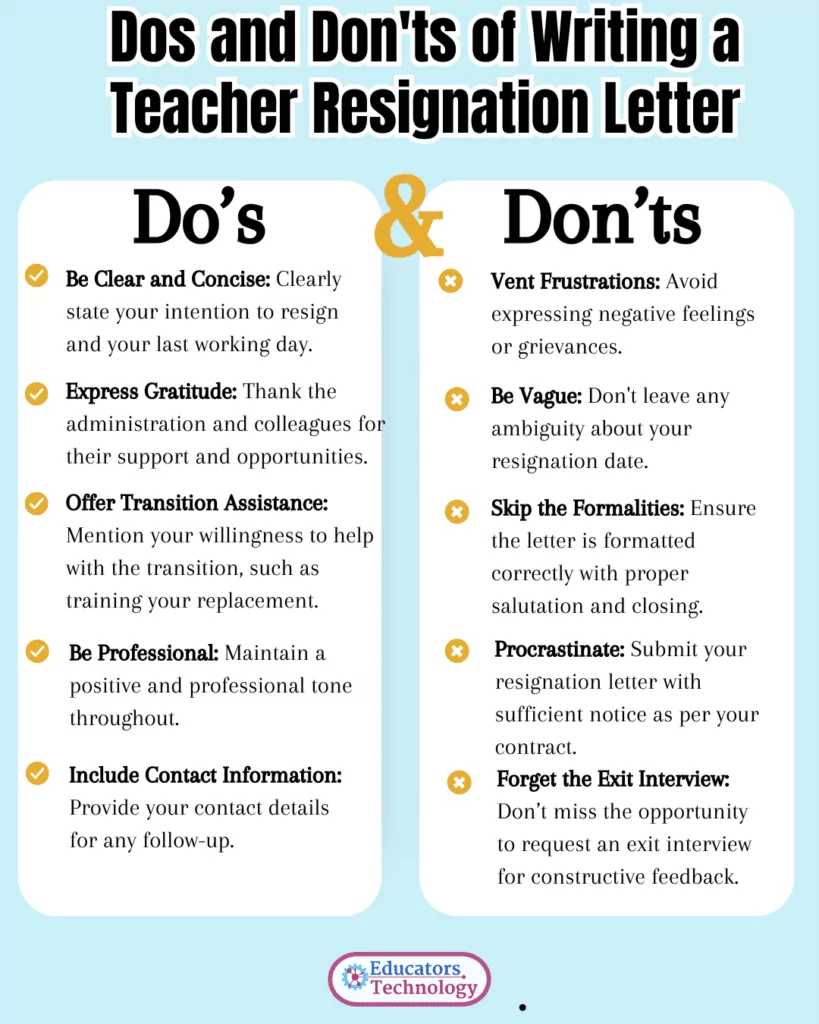
The following examples of teacher resignation letters are provided for illustration purposes. Each letter is designed to help you structure your own resignation letter in a professional and positive manner. Feel free to customize them according to your specific situation and needs.
To assist you further, we invite you to download our free templates which can be easily adapted to suit your personal circumstances. The templates are available in both PDF format and Word format .
Example 1: End-of-School-Year Resignation
[Your Name] [Your Address] [City, State, Zip Code] [Your Email Address] [Your Phone Number]
[Principal’s Name] [School Name] [School Address] [City, State, Zip Code]
Dear [Principal’s Name],
I am writing to formally resign from my position as [Your Position] at [School Name], effective at the end of the current school year. My final working day will be [Last Working Day].
I have deeply valued my time at [School Name] and am grateful for the opportunities to grow both personally and professionally. I appreciate the support and camaraderie of my colleagues and the administration. I am committed to making this transition as smooth as possible and am willing to assist in any way during my remaining time.
Thank you for your understanding and support.
Sincerely, [Your Full Legal Name]

Example 2: Midyear Resignation for Personal Reasons
I am writing to inform you of my resignation from my position as [Your Position] at [School Name], effective two weeks from today. My last working day will be [Last Working Day].
This decision was not easy and is based on personal reasons that require my full attention. I have enjoyed working at [School Name] and am grateful for the experiences and support I have received. I will do my utmost to ensure a smooth transition for my students and colleagues.

Example 3: Resignation Due to Relocation
I am writing to formally resign from my position as [Your Position] at [School Name], effective [Last Working Day]. Due to an upcoming relocation, I will be unable to continue my role here.
I have greatly enjoyed my time at [School Name] and am thankful for the support and opportunities provided. I am committed to ensuring a smooth transition and will assist in any way possible during my remaining time.

Example 4: Resignation for Career Change
I am writing to announce my resignation from my position as [Your Position] at [School Name], effective [Last Working Day]. I have decided to pursue a new career opportunity that aligns with my long-term goals.
Working at [School Name] has been a rewarding experience, and I am grateful for the support from the administration and my colleagues. I will do everything possible to ensure a smooth transition for my students.

Example 5: Resignation Due to Health Reasons
It is with a heavy heart that I submit my resignation from my position as [Your Position] at [School Name], effective [Last Working Day]. Due to health reasons, I must focus on my recovery and well-being.
I have cherished my time at [School Name] and the relationships built here. I am dedicated to ensuring a smooth handover and will support the transition process in any way I can.

Example 6: Resignation to Pursue Further Education
I am writing to formally resign from my position as [Your Position] at [School Name], effective [Last Working Day]. I have decided to pursue further education to enhance my skills and knowledge.
My time at [School Name] has been incredibly fulfilling, and I appreciate the support and professional growth opportunities provided. I will assist in making the transition as smooth as possible for my students and colleagues.

Example 7: Resignation for Personal Reasons
I am writing to inform you of my resignation from my position as [Your Position] at [School Name], effective [Last Working Day]. This decision is based on personal reasons that require my full attention.
I have enjoyed working at [School Name] and am grateful for the experiences and support I have received. I am committed to ensuring a smooth transition and will do everything possible to assist during this period.

Related: Teacher Appreciation Letter Templates
Final thoughts
I hope I was able to provide you with valuable insights and practical tips for writing a teacher resignation letter. Whether you need to resign at the end of the school year, midyear, or for personal reasons, the guidelines and examples included in this post will help ensure a smooth and professional transition. Remember, you can customize these templates to fit your specific needs (use Canva ). Don’t forget to download the free templates to make the process even easier and ensure a respectful and well-planned departure from your role.
- Indeed: https://in.indeed.com/career-advice/career-development/how-to-write-a-resignation-letter-as-a-teacher
- Corporate Finance: https://corporatefinanceinstitute.com/resources/career/resignation-letter-template/
- Hubspot: https://blog.hubspot.com/marketing/resignation-letter

Join our mailing list
Never miss an EdTech beat! Subscribe now for exclusive insights and resources .

Meet Med Kharbach, PhD
Dr. Med Kharbach is an influential voice in the global educational technology landscape, with an extensive background in educational studies and a decade-long experience as a K-12 teacher. Holding a Ph.D. from Mount Saint Vincent University in Halifax, Canada, he brings a unique perspective to the educational world by integrating his profound academic knowledge with his hands-on teaching experience. Dr. Kharbach's academic pursuits encompass curriculum studies, discourse analysis, language learning/teaching, language and identity, emerging literacies, educational technology, and research methodologies. His work has been presented at numerous national and international conferences and published in various esteemed academic journals.

Join our email list for exclusive EdTech content.
AI Accessibility: What Are AI Assistive Technology Examples?
2024-05-29 | By Orcam Staff

AI is revolutionizing the world, and one of its most impactful applications is in assistive technology.
This technology is designed to enhance the lives of individuals with disabilities, breaking down barriers and opening up new possibilities.
AI assistive technology is a testament to tech innovation. It's a blend of smart technology and AI applications, creating solutions that were once unimaginable.
From AI-powered wheelchairs to speech recognition tools, these advancements are transforming lives. They're making the world more accessible, one innovation at a time.
In this article, we delve into the world of AI assistive technology. We'll explore its various applications, the latest advancements, and what the future holds.
Join us as we uncover the transformative power of AI in creating a more inclusive world.
The Emergence of AI Assistive Technology
The emergence of AI assistive technology is a testament to the power of AI solutions. It's a story of how tech innovation can transform lives and create a more inclusive society.
AI advancements have been instrumental in this transformation. They've enabled the development of assistive tech that can adapt to individual needs, learn from user interactions, and provide personalized assistance. This has opened up a world of possibilities for individuals with disabilities, enhancing their independence and quality of life.
Defining AI Assistive Technology
AI assistive technology refers to AI applications that are designed to aid individuals with disabilities. These AI tools leverage smart technology to provide assistance in various aspects of daily life, from communication and mobility to learning and healthcare.
The goal of AI assistive technology is to enhance accessibility and overcome barriers faced by individuals with disabilities. It's about harnessing the power of AI technology to create a more inclusive world, where everyone has the opportunity to participate fully and independently.
AI Assistive Technology in Daily Life
AI assistive technology is not a distant concept; it's already integrated into our daily lives. From smart homes to personalized learning, AI solutions are enhancing accessibility in various sectors.
Smart Homes and Independent Living
Smart homes equipped with AI technology are revolutionizing independent living for individuals with disabilities. AI-powered devices, such as voice-controlled lights and automated door locks, are providing increased independence and safety.
AI in Education: Personalized Learning
In the realm of education, AI is creating adaptive and personalized learning experiences. AI tools can tailor educational content to individual learning styles, particularly benefiting students with learning disabilities.
AI in Healthcare: Predictive Analytics and Monitoring
AI is also making strides in healthcare, providing predictive analytics for personalized intervention. AI assistive tech can monitor health conditions and provide timely alerts, enhancing the quality of care.
AI in Employment: Workplace Accommodations
In the workplace, AI assistive technology is facilitating accommodations for employees with disabilities. From speech recognition software to AI-powered mobility aids, these tools are opening up new employment opportunities.
Innovative AI Tools for Accessibility
The realm of AI assistive technology is marked by continuous innovation. Developers are constantly creating new AI tools to enhance accessibility and improve the quality of life for individuals with disabilities.
These AI solutions range from communication aids to mobility and visual aids, each designed to overcome specific barriers. Let's delve into some of these innovative AI tools.
Communication Aids: Speech and Language Processing
AI plays a crucial role in enhancing communication for individuals with speech or language impairments. Speech recognition and generation technologies, powered by AI, are transforming communication aids.
These tools can convert speech to text, generate synthetic speech, and even predict text, enabling more effective and efficient communication.
Mobility Aids: Smart Prosthetics and Wheelchairs
AI is also revolutionizing mobility aids. Smart prosthetics and wheelchairs, equipped with AI technology, are providing unprecedented mobility solutions.
These AI-powered devices can adapt to the user's movements and environment, offering a higher degree of independence and control.
Visual Aids: Object Recognition and Navigation
For the visually impaired, AI is enhancing visual aids through object recognition and navigation technologies. These AI tools can identify and describe objects, read text aloud, and provide navigation assistance.
By doing so, they are helping individuals with visual impairments navigate their surroundings with greater ease and confidence.
Ethical Considerations and User-Centered Design
The deployment of AI assistive technology brings with it a host of ethical considerations. Data privacy and security are paramount, given the sensitive nature of the information these AI tools handle.
Moreover, the design of these AI solutions must be user-centered. It's crucial to involve users, disability advocates, and caregivers in the design process to ensure the technology truly meets the needs of those it's intended to assist. This collaborative approach can lead to more effective and inclusive AI assistive tools.
The Future of AI Assistive Technology
The future of AI assistive technology holds immense potential. With continuous advancements in AI and machine learning, we can expect more sophisticated and personalized assistive solutions. These advancements could augment human abilities beyond disability assistance, transforming the way we interact with the world.
However, the future also presents challenges. Ensuring universal access to these technologies and bridging the digital divide for people with disabilities will be critical. As we move forward, it's essential to keep these considerations in mind to create a more inclusive future.
Conclusion: The Impact of AI on Accessibility
AI assistive technology is revolutionizing accessibility. It's not just about overcoming barriers; it's about enhancing capabilities, fostering independence, and improving quality of life.
As we continue to innovate, we must ensure these technologies are accessible to all. The future of accessibility is here, and it's powered by AI.

IMAGES
VIDEO
COMMENTS
For our purposes, we will define 'technology' as the application of tools, knowledge, processes, or other methods of attaining objectives. See also 4 Examples Of Technology In The Special Education Classroom. In terms of its timeliness, 'technology' is also a relative term. At one point, a pencil was considered 'new' technology.
Using the technology of today, in the classroom today: the instructional power of digital games, social networking, simulations, and how teachers can leverage them. The Education Arcade, 2009, pp. 1-20. American Academy of Pediatrics. American Academy of Pediatrics Announces New Recommendations for Children's Media Use.
Digital innovation has demonstrated powers to complement, enrich and transform education, and has the potential to speed up progress towards Sustainable Development Goal 4 (SDG 4) for education and transform modes of provision of universal access to learning. It can enhance the quality and relevance of learning, strengthen inclusion, and ...
It provides the mid-term assessment of progress towards SDG 4, which was summarized in a brochure and promoted at the 2023 SDG Summit. The 2023 GEM Report and 200 PEER country profiles on technology and education were launched on 26 July. A recording of the global launch event can be watched here and a south-south dialogue between Ministers of ...
Here are five specific and sequential guidelines for decisionmakers to realize the potential of education technology to accelerate student learning. 1. Take stock of how your current schools ...
The theory and practice of educational approaches to learning, as well as. The technological tools that assist in the development and communication of knowledge. What is Educational Technology? [Tools & Media] One important definition of educational technology focuses on "the technological tools and media that assist in the communication of ...
Major advances in technology, especially digitaltechnology, are rapidly transforming the world.Information and communication technology (ICT) hasbeen applied for 100 years in education, ever sincethe popularization of radio in the 1920s. But it is the useof digital technology over the past 40 years that hasthe most significant potential to transform education.An education technology industry ...
Edtech, or education technology, is the practice of introducing information and communication technology tools into the classroom to create more engaging, inclusive and individualized learning experiences. Today's classrooms have moved beyond the clunky desktop computers that were once the norm and are now tech-infused with tablets ...
At its best, digital technologies can help build a more equitable and sustainable future. The 2023 GEM Report on technology and education, launched on 26 July 2023, similarly makes the case that, when used responsibly, digital technologies can help unlock the transformative power of education. However, the journey has had many twists and turns.
addresses the use of technology in education around the world through the lenses of relevance, equity, scalability and sustainability. It argues that education systems should always ensure that learners' interests are placed at the center and that digital technologies are used to support an education based on human interaction rather than ...
This 2024 National Educational Technology Plan (NETP) examines how technologies can raise the bar 7 for all elementary and secondary students. It offers examples of schools, districts, classrooms, and states doing the complex work of establishing systemic solutions to inequities of access, design, and use of technology in support of learning.
In recent years, there has been widespread excitement around the transformative potential of technology in education. In the United States alone, spending on education technology has now exceeded $13 billion.Programs and policies to promote the use of education technology may expand access to quality education, support students' learning in innovative ways, and help families navigate complex ...
Information and Communications Technology (ICT) can impact student learning when teachers are digitally literate and understand how to integrate it into curriculum. Schools use a diverse set of ICT tools to communicate, create, disseminate, store, and manage information.(6) In some contexts, ICT has also become integral to the teaching-learning interaction, through such approaches as replacing ...
Perhaps the most important thing about ed tech in K-12 isn't what the technology is, but how it's used. How to Integrate Technology into K-12 Classrooms. The first step to integrating technology into the K-12 classroom is figuring out which solution to integrate, given the large variety of tools available to educators. That variety ...
Educational technology businesses are continually attempting to create novel solutions to expand access to education for individuals who cannot obtain adequate educational facilities. ... For example, a student who has previously suffered in face-to-face circumstances may suffer far more in the current situation. These people may have been ...
Location: Seattle How it's doing edtech: Dreambox Learning's K-8 math curriculum relies on adaptive technology with game-like interfaces that responds to students' choices in real time by providing corrective drills in response to mistakes and moving on to new concepts when students display mastery of a particular topic. By making assessment an integral part of the learning process, the ...
4. Ensuring Equal Access. Technology can help correct the current imbalances that exist in our educational system. It can ensure that every student can get access to the same quality education ...
Internet Homework Assignments. Posting homework assignments online (via learning platforms like Blackboard, Brightspace, and Moodle) is one way many teachers can begin to integrate technology in the classroom. Assignments are easily accessible, which can increase student engagement and help students become more organized.
ISTE has a library of thousands of blog posts, podcasts, courses, books, journals, expert webinars and topic guides. Browse by topic or job role to find everything you need. Artificial Intelligence Augmented, Virtual & Mixed Reality Edtech Coaching Diversity, Equity & Inclusion ISTE Standards Digital Media & Creativity Computer Science ...
1. Getting virtual instruction right. Teachers, principals, and district leaders should be thinking hard about how to make remote learning better, especially if they are continuing to offer it ...
In the department's 2016 National Education Technology Plan, for example, it calls for states and districts to "design, develop, and implement learning dashboards, response systems, and ...
Increased Collaboration and Communication. Educational technology can foster collaboration. Not only can teachers engage with students during lessons, but students can also communicate with each other. Through online lessons and learning games, students get to work together to solve problems. In collaborative activities, students can share ...
Education trend 2: Interactivity. Education through interactivity uses quizzes, simulations, and collaborative projects in online learning environments. An online platform with interactive videos, particularly one with built-in quizzes that provide real-time, instant feedback, is super-effective and makes learning more dynamic.
Technology can be used as a powerful tool in education to support educators in achieving their teaching goals. For example, technology-infused active learning experiences can help teachers of any subject for any age develop student social, emotional, and practical skills through the act of completing activities and assignments.
The Future Of Educational Technology: A Look Ahead. The pace of technological innovation has significantly advanced in recent years. It shows no signs of slowing down. Looking ahead, technology will remain crucial in education. It will evolve to enhance and transform learning experiences. The integration of technology into education has been ...
D uring the COVID lockdowns, schools and universities worldwide relied on education technology—edtech—to keep students learning. They used online platforms to give lessons, mark work and send ...
Benefits of Technology in Education. Enhanced Engagement. Technology can make learning more engaging through multimedia content, interactive activities, and real-time feedback. Flexibility and Accessibility. Online learning platforms and digital resources allow students to learn at their own pace and on their own schedule, making education more ...
Care. The current studies focus on human-centered education by caring about the benefits and risks of emerging technologies. The technologies can benefit education by delivering more personalized, interactive, and immersive learning content, feedback, automated grading, and predictive analyzes (e.g., Büyüközkan & Mukul, Citation 2024; Hong, Citation 2023).
Discover essential tips and examples for writing a professional teacher resignation letter. This guide covers key elements, practical advice, and provides free downloadable teacher resignation letter examples. ... Dr. Med Kharbach is an influential voice in the global educational technology landscape, with an extensive background in educational ...
The realm of AI assistive technology is marked by continuous innovation. Developers are constantly creating new AI tools to enhance accessibility and improve the quality of life for individuals with disabilities. These AI solutions range from communication aids to mobility and visual aids, each designed to overcome specific barriers.